Paul van Yperen's Blog, page 135
January 29, 2022
Nos Artistes dans leurs expressions
One of the most fascinating star postcard series is Nos artistes dans leur loge, a French series published between 1922 and 1926 as a supplement for the journal Comœdia with dozens of French stage and film stars of the 1920s in their dressing rooms. The postcards were nearly all produced by Edit. Art de Comoedia and a few by Editions La Fayette. There are also two other interesting postcard series by the same publishers. Last week we did a post on the Nos Artistes series, and today EFSP presents Nos Artistes dans leurs expressions, a series with famous French stage artists and their typical expressions. This series was also published by Comœdia and in the beginning by Editions La Fayette but another part of the series was published by Paris sur scene.
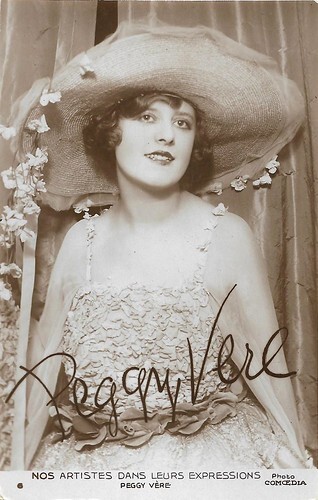
French postcard by Editions Lafayette in the Nos artistes dans leurs expressions series, no. 6. Photo: Comoedia.
Peggy Vere aka Peggy Vère (?-?) was a British music-hall artist, dancer and singer, as well as a stage and screen actress. She debuted at the Parisian music-hall Concert Mayol and at the Théâtre des Variétés, then moved on to the Ambassadeurs and Casino de Paris in 1920. Between 1920 and 1940 she mostly performed at the Concert Mayol again. She was active in spreading the Lambeth Walk in France. De Vere made her film debut in 1919 in the propgandistic drama Dans les ténèbres (Théo Bergerat, 1919). In 1923 she acted in La porteuse de pain (René Le Somptier, 1923), one of the many adaptations of Xavier de Montepin's popular novel, scripted by Germaine Dulac, and with Suzanne Desprès in the lead. In the comedy Ma tante d'Honfleur (Robert Saidreau, 1923) she played Albertine, opposite Jane Loury as the title character. In the early sound era she also played in two films, Le roi du camembert (Antoine Mourre, 1931), in which she had a lead as Miss Peggy Wood opposite Louis Rollin as the title character, and a supporting part in La dernière nuit (Jacques de Casembroot, 1933), starring Florelle.
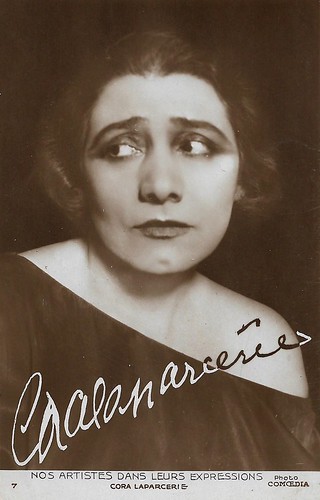
French postcard by Edit. Art de Comoedia in the Nos artistes dans leurs expressions series, no. 7. Photo: Comoedia.
Marie-Caroline Laparcerie, bettter known as Cora Laparcerie (1875-1951), was an actress, poetess and French theatre director.
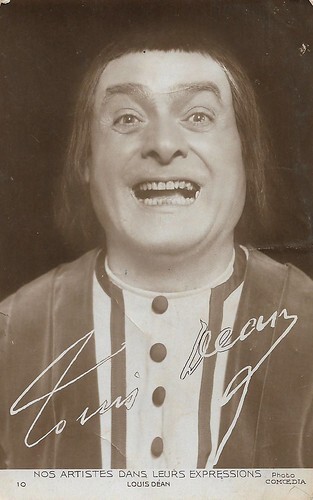
French postcard by Edit. Art de Comoedia in the Nos artistes dans leurs expressions series, no. 10. Photo: Comoedia.
Louis Déan was a French stage actor, about whom nothing much is known. In 1880 he acted as the British reporter Harry Blount in the play Michel Strogoff at the Théâtre du Chatelet, with Armand Bernard in the lead. Déan acted at the premiere of George Feydeau's play Le Dindon in 1896 in Paris. Felix Hugenet played the lead at the time. By the 1900s, Déan acted at the Théâtre de Porte Saint-Martin. Apparently, Déan often played the comical sidekick, as in 1915 the French reporter Jolivet in Michel Strogoff, Passepartout in La Tour du monde en 80 jours, and Coquillet in Les Exploits d'une petite Française. By the 1920s he acted the Théâtre du Chatelet again. On this card he probably must have been in his sixties. NB Déan should not be confused with the American silent film actor Louis Dean.
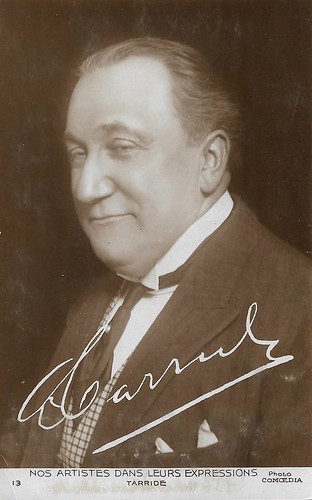
French postcard by Edit. Art de Comoedia in the Nos artistes dans leurs expressions series, no. 13. Photo: Comoedia.
Abel Tarride (1865-1951) was a French stage and screen actor and playwright, best known for his interpretation of Commissioner Maigret in the film Le Chien jaune (1932), made by his son Jean Tarride. Tarride first had a rich career as stage actor and playwright between the 1880s and the 1920s. He was also manager of the Théâtre de la Renaissance in Paris after Sarah Bernhardt and Lucien Guitry, and also managed the Théâtre des Bouffes-Parisiens and the Théâtre des Mathurins, and he was involved in the Théâtre national de l'Odéon and the Théâtre de l'Apollo. With the actress Marthe Regnier he had two sons, the future director Jean Tarride and the future actor Jacques Tarride. In the 1930s Tarride had an active career in French sound cinema, after incidental screen performances in the 1920s.
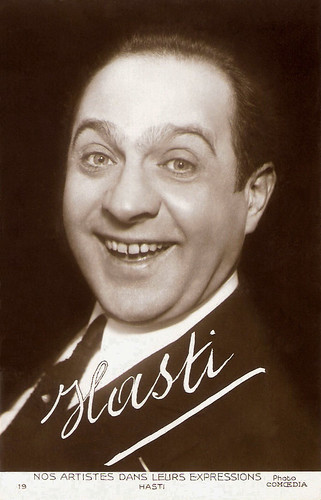
French postcard by Edit. Art de Comoedia in the Nos artistes dans leurs expressions series, no. 19. Photo: Comoedia.
French actor and painter Robert Hasti (1880-1956) appeared in a dozen French films of the 1910s and 1930s.
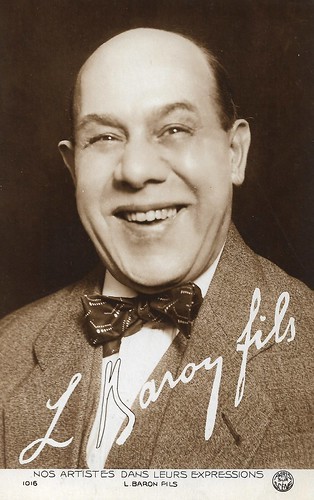
French postcard by Paris sur scene in the Nos artistes dans leurs expressions series, no. 1016.
Louis Bouchêne, known as Louis Baron, fils or just Baron fils (1870-1939), was an actor and singer, who performed in many operettas and comédie-musicales, and also in some 50 films between 1910 et 1938. He was the son of Louis Baron often associated with the works of Jacques Offenbach.
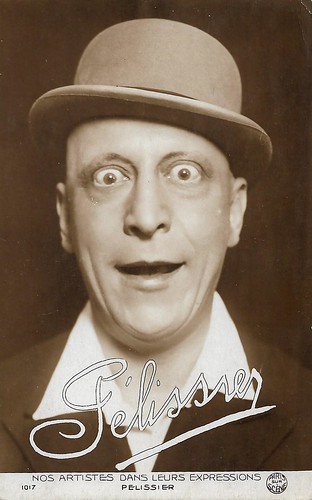
French postcard by Paris sur scene in the Nos artistes dans leurs expressions series, no. 1017.
On basis of the French site Gallica, we can conclude that Pelissier (?-?) must have had his breakthrough around 1910 at the Eldorado, soon rivaling Dranem, Boucot, and Tramel. He was between the mid-1910s and the mid-1920s a highly popular Parisian music-hall comedian, performing at e.g. La Cigale, Olympia, Moulin-Rouge, Concert Mayol, and above all the Eldorado and the Ambassadeurs. During WWI, he did charity performances in the provinces, as in Arcachon in 1917. In 1932 he played what may have been his only film role, as the 'patron' in the French early sound film Son plus bel exploit (André Chotin, 1932). a musical comedy starring Mireille.
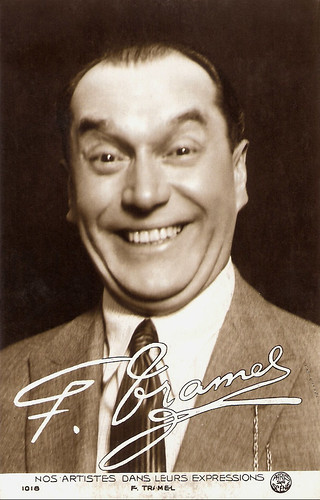
French postcard by Paris sur scene in the Nos artistes dans leurs expressions series, no. 1018. Photo: Comoedia.
Félicien Tramel (1880-1948) or just Tramel was a French singer and actor. Tramel made more than 30 78’s at Odeon with such hits as 'T'en fais pas Bouboule' (Do not worry Bouboule) and 'Y me faut mon patelin' (I miss my hometown). Between 1911 and 1947 he played in dozens of films. In a series of silent and sound comedies, Tramel starred as the character Alfred Bicard or Le Bouif.
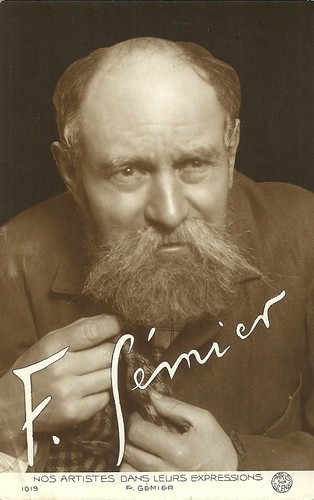
French postcard by Paris sur scene in the Nos artistes dans leurs expressions series, no. 1019.
Firmin Gémier (1869-1933) was actor, director and theatre manager at the French stage, promotor of the Théâtre Populaire, and founder of the first Théâtre National Populaire (Paris, 1920). He also acted in French silent and sound cinema of the 1910s to the 1930s.
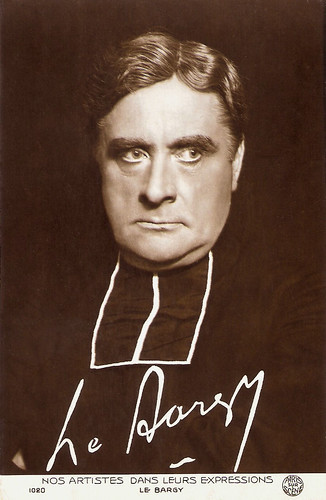
French postcard by Paris sur scene in the Nos artistes dans leurs expressions series, no. 1020. Charles Le Bargy in the play 'Le Duel' by Lavedan.
Charles Le Bargy (1858-1936) was already a famous stage actor in his time, performing at the Comedie Française when he debuted in the film as the perfidious king Henry III in L'Assassinat du Duc de Guise (1908).
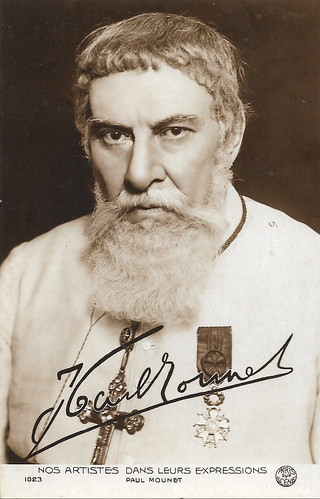
French postcard by Paris sur scene in the Nos artistes dans leurs expressions series, no. 1023. Paul Mounet in Par la vérité/By the truth (Maurice de Féraudy, Gaston Leprieur, 1917).
Paul Mounet (1847–1922), born Jean-Paul Sully, was a French actor of the Comédie Française, who also acted in various Film d'art films around 1910.
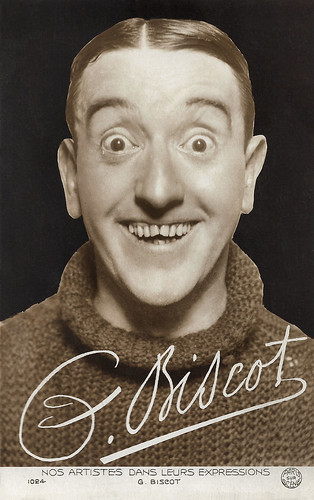
French postcard by Paris sur scene in the Nos artistes dans leurs expressions series, no. 1024.
Georges Biscot (1886-1945) was a popular French music-hall and revue singer and actor. He also had a career in French silent and sound cinema.
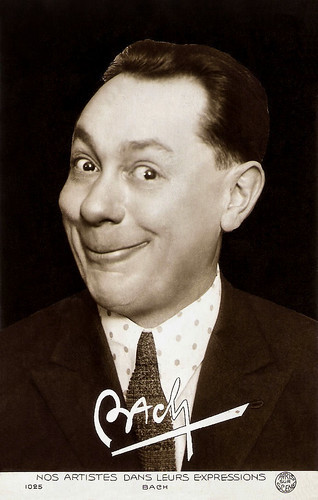
French postcard by Paris sur scene in the Nos artistes dans leurs expressions series, no. 1025.
Bach (1882-1953) was a popular French actor, singer, and music hall performer. During the 1930s, he was the king of the Comique Troupier (coarse comedy).
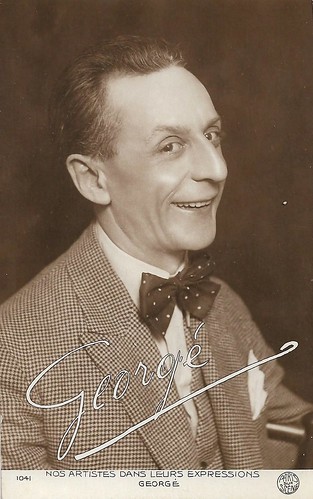
French postcard by Paris sur scene in the Nos artistes dans leurs expressions series, no. 1041.
Georgé (1880-1969), born Ernest Georgé, was a French stage and screen actor, who played in 16 films between 1920 and 1948. He made his debut in the fantasy film Asmodée à Paris (1921). The next year he had the title role in Le Noël du père Lathuile (Pierre Colombier, 1922). After a few minor parts, he had a major role as the priest in Colombier's comedy Paris en cinq jours (Pierre Colombier, 1926), starring Dolly Davis and Nicolas Rimsky. In the early sound era he did almost one film per year between 1930 and 1937, including the comedy Conduisez-moi, Madame (Herbert Selpin, 1932) with Jeanne Boitel, and La châtelaine du Liban (Jean Epstein, 1934), but from the mid-1930s his parts became small, uncredited ones. In 1947-1948 Georgé did his last three film parts, including Mademoiselle s'amuse (Jean Boyer 1948) with Ray Ventura and Gisèle Pascal.
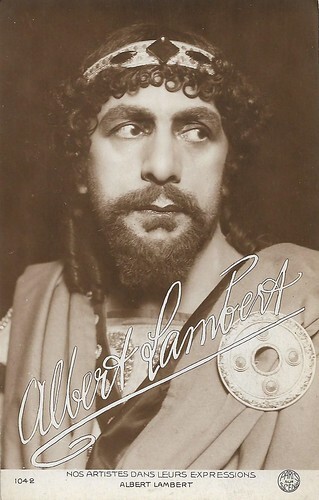
French postcard by Paris sur scene in the Nos artistes dans leurs expressions series, no. 1042.
Albert Lambert (1865-1941), aka Albert Lambert fils, was a French stage and screen actor, who was for a long time part of the Comédie-Française. He also played in several early French Film d’Art films, first of all in L'Assassinat du Duc de Guise (1908).
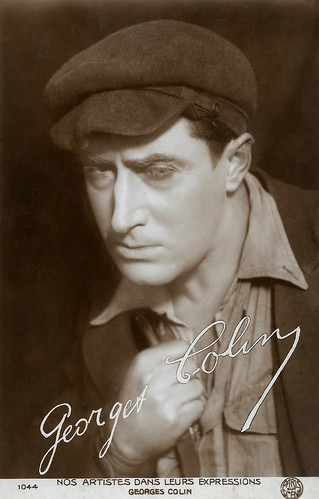
French postcard by Paris sur scene in the Nos artistes dans leurs expressions series, no. 1044.
Georges Colin (1880-1945) was a French actor, who appeared in nearly 40 silent and sound films between 1909 and 1945.
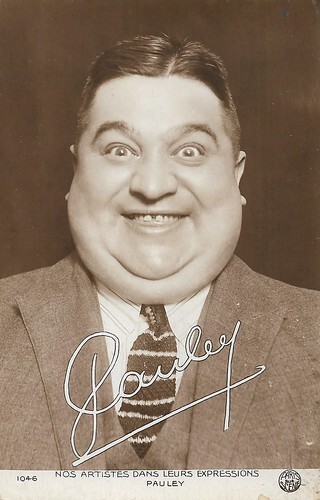
French postcard by Paris sur scene in the Nos artistes dans leurs expressions series, no. 1046.
Pauley or Paul Pauley (1886-1938) was a French actor and singer, who knew a prolific career in French cinema of the 1930s.
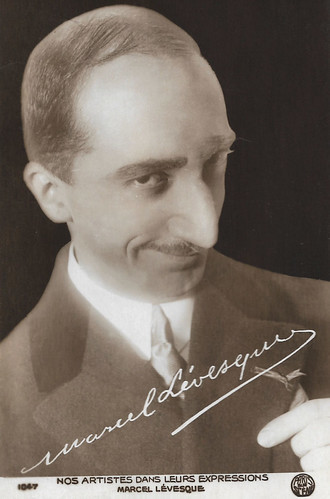
French postcard by Paris sur scene in the Nos artistes dans leurs expressions series, no. 1047.
Marcel Lévesque (1877-1962) was a French actor and scriptwriter who excelled in French silent and sound comedies. He also played memorable parts in the crime serials by Louis Feuillade and in Jean Renoir’s Le Crime de M. Lange (1936).
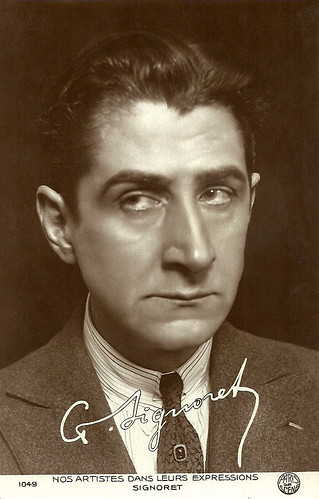
French postcard by Paris sur scene in the Nos artistes dans leurs expressions series, no. 1049.
Gabriel Signoret aka Signoret (1878 - 1937) was a French actor and director who played in some 85 films, mostly silent ones.
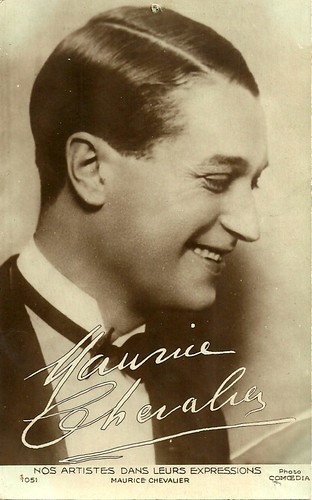
French postcard by Edit. Art de Comoedia in the Nos artistes dans leurs expressions series, no. 1051. Photo: Comoedia.
Maurice Chevalier (1988-1972) was a French actor, singer and entertainer. His trademark was a casual straw hat, which he always wore on stage with a cane and a tuxedo.
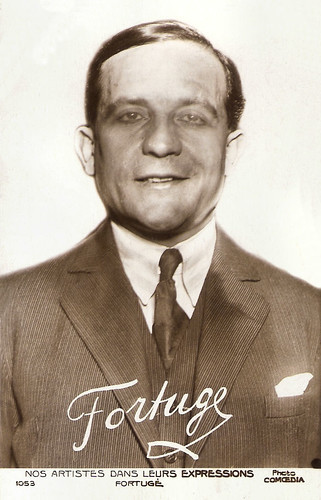
French postcard by Edit. Art de Comoedia in the Nos artistes dans leurs expressions series, no. 1053. Photo: Comoedia.
Fortugé (1887-1923) was a French artist, who was a popular Music-hall and Café Concert singer before and after World War I. He recorded several of his comic songs for Pathé Frères. His early death made an end to his successful career.
Sources:

French postcard by Editions Lafayette in the Nos artistes dans leurs expressions series, no. 6. Photo: Comoedia.
Peggy Vere aka Peggy Vère (?-?) was a British music-hall artist, dancer and singer, as well as a stage and screen actress. She debuted at the Parisian music-hall Concert Mayol and at the Théâtre des Variétés, then moved on to the Ambassadeurs and Casino de Paris in 1920. Between 1920 and 1940 she mostly performed at the Concert Mayol again. She was active in spreading the Lambeth Walk in France. De Vere made her film debut in 1919 in the propgandistic drama Dans les ténèbres (Théo Bergerat, 1919). In 1923 she acted in La porteuse de pain (René Le Somptier, 1923), one of the many adaptations of Xavier de Montepin's popular novel, scripted by Germaine Dulac, and with Suzanne Desprès in the lead. In the comedy Ma tante d'Honfleur (Robert Saidreau, 1923) she played Albertine, opposite Jane Loury as the title character. In the early sound era she also played in two films, Le roi du camembert (Antoine Mourre, 1931), in which she had a lead as Miss Peggy Wood opposite Louis Rollin as the title character, and a supporting part in La dernière nuit (Jacques de Casembroot, 1933), starring Florelle.

French postcard by Edit. Art de Comoedia in the Nos artistes dans leurs expressions series, no. 7. Photo: Comoedia.
Marie-Caroline Laparcerie, bettter known as Cora Laparcerie (1875-1951), was an actress, poetess and French theatre director.

French postcard by Edit. Art de Comoedia in the Nos artistes dans leurs expressions series, no. 10. Photo: Comoedia.
Louis Déan was a French stage actor, about whom nothing much is known. In 1880 he acted as the British reporter Harry Blount in the play Michel Strogoff at the Théâtre du Chatelet, with Armand Bernard in the lead. Déan acted at the premiere of George Feydeau's play Le Dindon in 1896 in Paris. Felix Hugenet played the lead at the time. By the 1900s, Déan acted at the Théâtre de Porte Saint-Martin. Apparently, Déan often played the comical sidekick, as in 1915 the French reporter Jolivet in Michel Strogoff, Passepartout in La Tour du monde en 80 jours, and Coquillet in Les Exploits d'une petite Française. By the 1920s he acted the Théâtre du Chatelet again. On this card he probably must have been in his sixties. NB Déan should not be confused with the American silent film actor Louis Dean.

French postcard by Edit. Art de Comoedia in the Nos artistes dans leurs expressions series, no. 13. Photo: Comoedia.
Abel Tarride (1865-1951) was a French stage and screen actor and playwright, best known for his interpretation of Commissioner Maigret in the film Le Chien jaune (1932), made by his son Jean Tarride. Tarride first had a rich career as stage actor and playwright between the 1880s and the 1920s. He was also manager of the Théâtre de la Renaissance in Paris after Sarah Bernhardt and Lucien Guitry, and also managed the Théâtre des Bouffes-Parisiens and the Théâtre des Mathurins, and he was involved in the Théâtre national de l'Odéon and the Théâtre de l'Apollo. With the actress Marthe Regnier he had two sons, the future director Jean Tarride and the future actor Jacques Tarride. In the 1930s Tarride had an active career in French sound cinema, after incidental screen performances in the 1920s.

French postcard by Edit. Art de Comoedia in the Nos artistes dans leurs expressions series, no. 19. Photo: Comoedia.
French actor and painter Robert Hasti (1880-1956) appeared in a dozen French films of the 1910s and 1930s.

French postcard by Paris sur scene in the Nos artistes dans leurs expressions series, no. 1016.
Louis Bouchêne, known as Louis Baron, fils or just Baron fils (1870-1939), was an actor and singer, who performed in many operettas and comédie-musicales, and also in some 50 films between 1910 et 1938. He was the son of Louis Baron often associated with the works of Jacques Offenbach.

French postcard by Paris sur scene in the Nos artistes dans leurs expressions series, no. 1017.
On basis of the French site Gallica, we can conclude that Pelissier (?-?) must have had his breakthrough around 1910 at the Eldorado, soon rivaling Dranem, Boucot, and Tramel. He was between the mid-1910s and the mid-1920s a highly popular Parisian music-hall comedian, performing at e.g. La Cigale, Olympia, Moulin-Rouge, Concert Mayol, and above all the Eldorado and the Ambassadeurs. During WWI, he did charity performances in the provinces, as in Arcachon in 1917. In 1932 he played what may have been his only film role, as the 'patron' in the French early sound film Son plus bel exploit (André Chotin, 1932). a musical comedy starring Mireille.

French postcard by Paris sur scene in the Nos artistes dans leurs expressions series, no. 1018. Photo: Comoedia.
Félicien Tramel (1880-1948) or just Tramel was a French singer and actor. Tramel made more than 30 78’s at Odeon with such hits as 'T'en fais pas Bouboule' (Do not worry Bouboule) and 'Y me faut mon patelin' (I miss my hometown). Between 1911 and 1947 he played in dozens of films. In a series of silent and sound comedies, Tramel starred as the character Alfred Bicard or Le Bouif.

French postcard by Paris sur scene in the Nos artistes dans leurs expressions series, no. 1019.
Firmin Gémier (1869-1933) was actor, director and theatre manager at the French stage, promotor of the Théâtre Populaire, and founder of the first Théâtre National Populaire (Paris, 1920). He also acted in French silent and sound cinema of the 1910s to the 1930s.

French postcard by Paris sur scene in the Nos artistes dans leurs expressions series, no. 1020. Charles Le Bargy in the play 'Le Duel' by Lavedan.
Charles Le Bargy (1858-1936) was already a famous stage actor in his time, performing at the Comedie Française when he debuted in the film as the perfidious king Henry III in L'Assassinat du Duc de Guise (1908).

French postcard by Paris sur scene in the Nos artistes dans leurs expressions series, no. 1023. Paul Mounet in Par la vérité/By the truth (Maurice de Féraudy, Gaston Leprieur, 1917).
Paul Mounet (1847–1922), born Jean-Paul Sully, was a French actor of the Comédie Française, who also acted in various Film d'art films around 1910.

French postcard by Paris sur scene in the Nos artistes dans leurs expressions series, no. 1024.
Georges Biscot (1886-1945) was a popular French music-hall and revue singer and actor. He also had a career in French silent and sound cinema.

French postcard by Paris sur scene in the Nos artistes dans leurs expressions series, no. 1025.
Bach (1882-1953) was a popular French actor, singer, and music hall performer. During the 1930s, he was the king of the Comique Troupier (coarse comedy).

French postcard by Paris sur scene in the Nos artistes dans leurs expressions series, no. 1041.
Georgé (1880-1969), born Ernest Georgé, was a French stage and screen actor, who played in 16 films between 1920 and 1948. He made his debut in the fantasy film Asmodée à Paris (1921). The next year he had the title role in Le Noël du père Lathuile (Pierre Colombier, 1922). After a few minor parts, he had a major role as the priest in Colombier's comedy Paris en cinq jours (Pierre Colombier, 1926), starring Dolly Davis and Nicolas Rimsky. In the early sound era he did almost one film per year between 1930 and 1937, including the comedy Conduisez-moi, Madame (Herbert Selpin, 1932) with Jeanne Boitel, and La châtelaine du Liban (Jean Epstein, 1934), but from the mid-1930s his parts became small, uncredited ones. In 1947-1948 Georgé did his last three film parts, including Mademoiselle s'amuse (Jean Boyer 1948) with Ray Ventura and Gisèle Pascal.

French postcard by Paris sur scene in the Nos artistes dans leurs expressions series, no. 1042.
Albert Lambert (1865-1941), aka Albert Lambert fils, was a French stage and screen actor, who was for a long time part of the Comédie-Française. He also played in several early French Film d’Art films, first of all in L'Assassinat du Duc de Guise (1908).

French postcard by Paris sur scene in the Nos artistes dans leurs expressions series, no. 1044.
Georges Colin (1880-1945) was a French actor, who appeared in nearly 40 silent and sound films between 1909 and 1945.

French postcard by Paris sur scene in the Nos artistes dans leurs expressions series, no. 1046.
Pauley or Paul Pauley (1886-1938) was a French actor and singer, who knew a prolific career in French cinema of the 1930s.

French postcard by Paris sur scene in the Nos artistes dans leurs expressions series, no. 1047.
Marcel Lévesque (1877-1962) was a French actor and scriptwriter who excelled in French silent and sound comedies. He also played memorable parts in the crime serials by Louis Feuillade and in Jean Renoir’s Le Crime de M. Lange (1936).

French postcard by Paris sur scene in the Nos artistes dans leurs expressions series, no. 1049.
Gabriel Signoret aka Signoret (1878 - 1937) was a French actor and director who played in some 85 films, mostly silent ones.

French postcard by Edit. Art de Comoedia in the Nos artistes dans leurs expressions series, no. 1051. Photo: Comoedia.
Maurice Chevalier (1988-1972) was a French actor, singer and entertainer. His trademark was a casual straw hat, which he always wore on stage with a cane and a tuxedo.

French postcard by Edit. Art de Comoedia in the Nos artistes dans leurs expressions series, no. 1053. Photo: Comoedia.
Fortugé (1887-1923) was a French artist, who was a popular Music-hall and Café Concert singer before and after World War I. He recorded several of his comic songs for Pathé Frères. His early death made an end to his successful career.
Sources:
Published on January 29, 2022 22:00
January 28, 2022
The Early Silent Comedians: USA
This month, EFSP presents three posts by Ivo Blom on early comedy in three countries. In the previous weeks, Ivo selected postcards of the silent Italian and French comedians. Today, the series finishes with a post on the American silent comedians. In the USA, silent comedy was huge and diverse, so Ivo chose a few interesting themes and selected a mix of well-known and forgotten comedians.
The Vitagraph Comedians
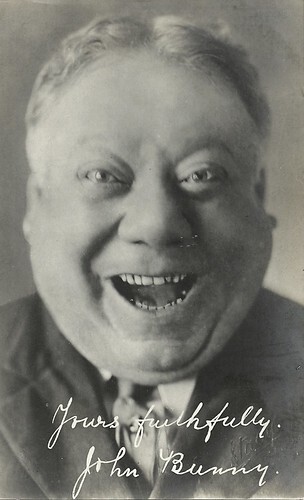
British or American postcard. Editor unknown.
American actor and comedian John Bunny (1863-1915) was considered the first true comedy star of the early American silent film era. He acted in over a hundred short comedies at Vitagraph, often with Flora Finch. By 1909 he was already under contract to Vitagraph, and his character as a well-fed, carefree man quickly made him an international silent comedy star. Bunny's comedy was not slapstick, crass, and circus-inspired but polite, middle-class, situational comedy, often situated in domestic settings. He played Mr. Pickwick in The Pickwick Papers (Laurence Trimble, 1913), a three-reeler based on Charles Dicken's classic tale.
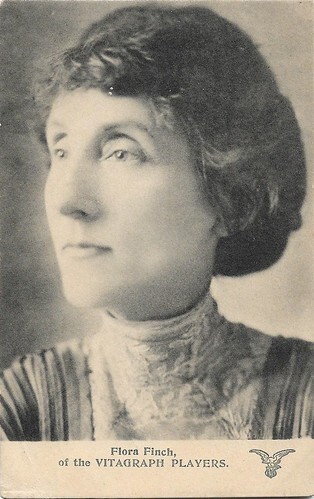
British postcard. Editor unknown. Caption: Flora Finch, of the Vitagraph Players.
Flora Finch (1867-1940) was an English-born vaudevillian, stage, and film actress who starred in over 300 silent films. She formed a popular pair with John Bunny in a series of more than a hundred Vitagraph comedies, commonly identified as the 'Bunnygraphs' or 'Bunnyfinches'. Several of the Bunny and Finch comedies have been found in the Desmet Collection of the Eye Filmmuseum (Netherlands) and can be found on Eye's YouTube section, such as Stenographer's Troubles, Bunny's Suicide, and Tangled Tangoists. A candid gossip: Finch disliked Bunny, who reportedly was arrogant, short-tempered, and generally difficult to work with.
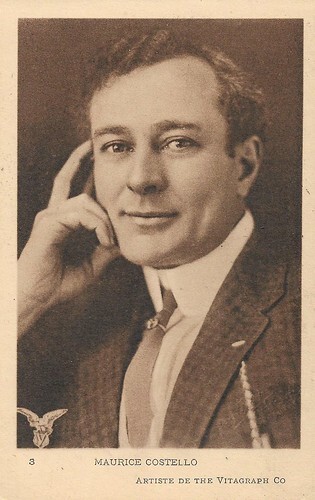
French postcard, probably issued by Vitagraph's subsidiary in Paris, no. 3. Photo: Vitagraph. Caption: Maurice Costello, artist of The Vitagraph Co. In contrast to most American film companies, who had London as their hub for the European film distribution market, Vitagraph had opened an office in Paris and arranged its European publicity from there, including the astonishing film posters (de)signed by Harry Bedos.
Maurice Costello (1877-1950) was a prominent American vaudeville actor of the late 1890s and early 1900s, who later became a prominent matinee idol and director at The Vitagraph Co. of America. He made fun of his own image in the delicious comedy The Picture Idol (James Young, 1912) with Clara Kimball Young as his idolising fan.
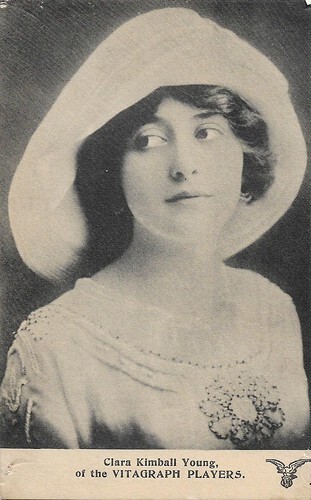
British postcard. Photo: Vitagraph. Caption: Clara Kimball Young of the Vitagraph Players.
American film actress Clara Kimball Young (1890-1960) was very popular in the early silent film era. After sending a photograph to Vitagraph Studios, Kimball Young was offered a yearly contract in 1912. Young's star at Vitagraph rose quickly. She was predominantly cast in melodramas and romantic comedies as the virtuous heroine. By 1913, she had become one of the more popular leading ladies at Vitagraph. Then, Vitagraph released the drama My Official Wife (James Young, 1914), which starred Young as a Russian revolutionary. The film, which is now lost, was an enormous success and launched Young into first place in the popularity polls.
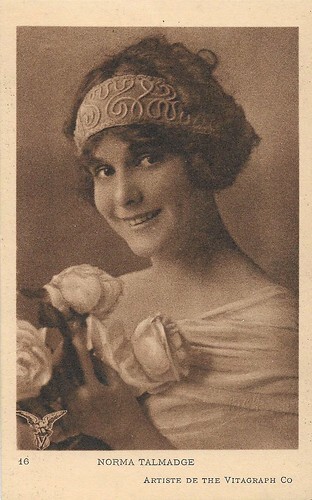
French postcard, no. 16. Photo: Vitagraph. Caption: Norma Talmadge , artist of The Vitagraph Co. In contrast to most American film companies, who had London as their hub for the European film distribution market, Vitagraph had opened an office in Paris and arranged its European publicity from there, including the astonishing film posters (de)signed by Harry Bedos.
Between 1909 and 1915, Norma Talmadge (1894-1957) was one of the regular actors at Vitagraph, acting in hundreds of shorts, but also in the feature The Battlecry for Peace. She was a major box-office draw for more than a decade. Her career reached a peak in the early 1920s when she ranked among the most popular idols on the American screen.
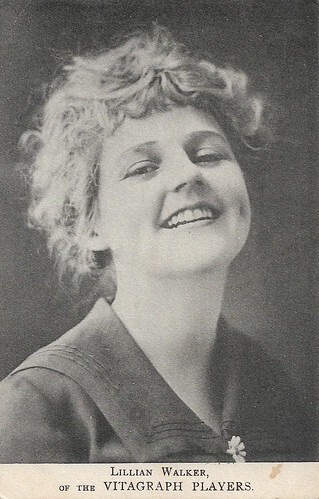
British postcard. Photo: Vitagraph. Caption: Lillian Walker of the Vitagraph Players.
American silent film actress Lillian Walker (1887-1975) appeared in 178 films between 1909 and 1934. In 1909 she could be seen in her first part in a Vitagraph film, C.Q.D.; or, Saved by Wireless; a True Story of the Wreck of the Republic. She did 18 shorts in 1911, both dramas and comedies. Nicknamed 'Dimples', she played in the comedies with John Bunny and Wally Van. 1912 was a top year at Vitagraph with some 43 short films, followed by 35 more films in 1913, 28 in 1914, and 23 in 1915. Memorable were films like Those Troublesome Tresses, Cinderella's Slippers, and Miss Tomboy.
American silent comedians by La Novela Semanal Cinematográfica
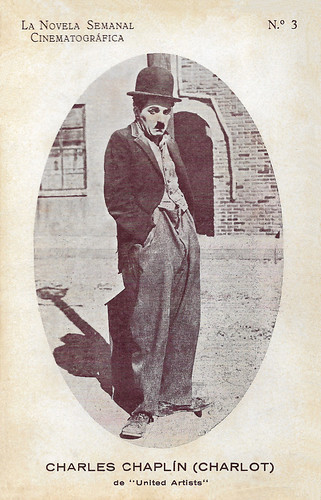
Spanish postcard by La Novela Semanal Cinematográfica, no. 3. Photo: United Artists (but the film was produced by First National). Charles Chaplin in A Dog's Life (Charles Chaplin, 1918). Charlot was the Spanish nickname for Chaplin.
English comedian Charles ‘Charlie’ Chaplin (1889-1977) was one of the most creative and influential personalities of the silent-film era. His most famous role was that of The Tramp with his toothbrush mustache, undersized bowler hat, and bamboo cane who struggled to survive while keeping his dignity in a world with great social injustice. Chaplin used mime, slapstick, and other visual comedy routines, and he not only starred in his films, but also directed, wrote, and produced them, and composed the music as well. His working life in entertainment spanned over 75 years, from the Victorian stage and the Music Hall in the United Kingdom as a child performer, until close to his death at the age of 88. Author George Bernard Shaw called Chaplin "the only genius to come out of the movie industry".
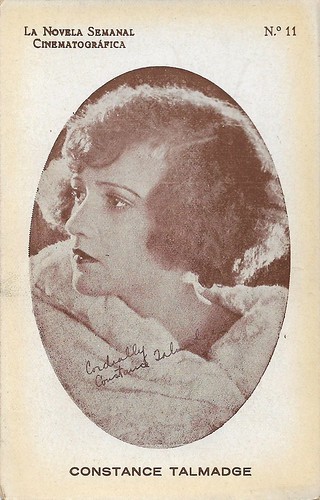
Spanish collectors card by La Novela Semanal Cinematográfica, no. 11.
Constance Talmadge (1898-1973) was an actress of the American silent screen, who started at Vitagraph in 1914. Talmadge had her breakthrough as the tomboyish Mountain Girl in D.W. Griffith's Intolerance (1916). Talmadge appeared in over 80 films, mostly comedies of manners, for which Anita Loos wrote several scripts, such as A Pair of Silk Stockings (1918), Happiness à la Mode (1919), Romance and Arabella (1919), Wedding Bells (1921), and The Primitive Lover (1922). Together with her sister Norma, Constance Talmadge was billed as one of the biggest stars of the twenties.
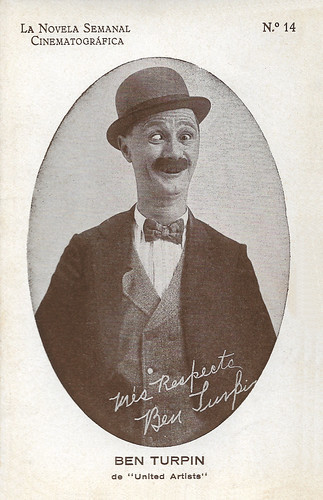
Spanish card by La Novela Semanal Cinematográfica, no. 14. Photo: United Artists.
Cross-eyed silent comedian Ben Turpin (1869-1940) was not born that way. Supposedly his right eye slipped out of alignment while playing the role of the similarly afflicted Happy Hooligan in vaudeville and it never adjusted. Ironically, it was this disability that would enhance his comic value and make him a top name in the silent film era. Turpin's true forte was impersonating the most dashingly romantic and sophisticated stars of the day and turning them into clumsy oafs. He also invented a Hollywood tradition by being the first actor to receive a pie in his face.
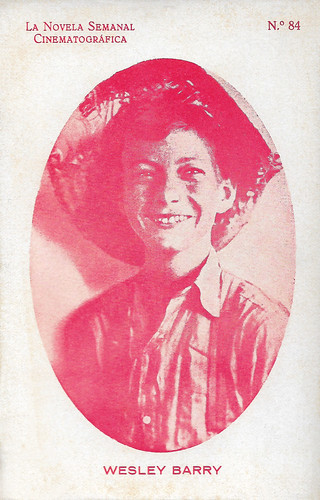
Spanish card by La Novela Semanal Cinematográfica, no. 84.
Wesley Barry (1907-1994) was an adorable child actor in silent comedies who was known for his face full of freckles. He later became a producer and director of both film and television. As a director, he was sometimes billed as Wesley E. Barry.
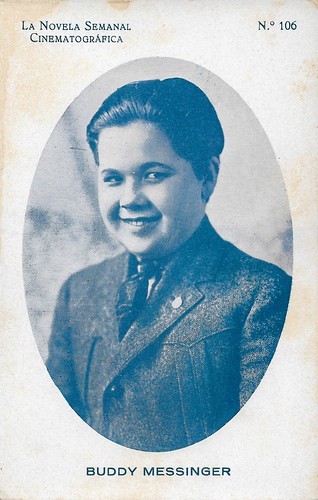
Spanish card by La Novela Semanal Cinematográfica, no. 106.
Buddy Messinger (1907–1965) was a popular child actor in American silent cinema of the late 1910s and 1920s. Between 1923 and 1925 he had his own series on the character of Buddy, produced by Century Film and distributed by Universal. In 1926-27 he worked for Bray Studios, and in 1928 he was in many episodes of the Drugstore Cowboy one-reel comedies. He continued in the sound era till the early 1940s - but in uncredited parts - while from the 1950s he worked as assistant director.
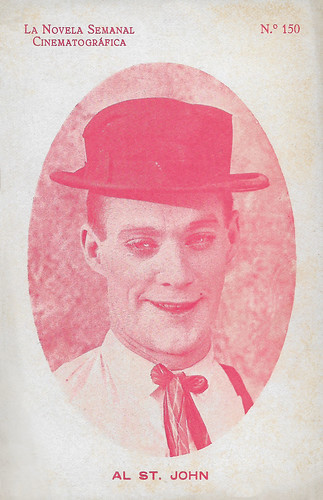
Spanish card by La Novela Semanal Cinematográfica, no. 150.
Al St. John (1892-1963) was an early American film comedian, and nephew of Roscoe 'Fatty' Arbuckle, with whom he often appeared. He appeared in dozens of Mack Sennett's early Keystone comedies and worked with Charlie Chaplin, Buster Keaton, and Mabel Normand. He would eventually create and star in his own vehicles for other studios. In the sound era, he was the sidekick of B-Western heroes like Bob Steele and Buster Crabbe. He played the scruffy comedy relief character 'Fuzzy Q. Jones' in the Billy the Kid series (1940-1946), and the Lone Rider series (1941-1943). From 1912 to 1952, Al St. John acted in 346 films.
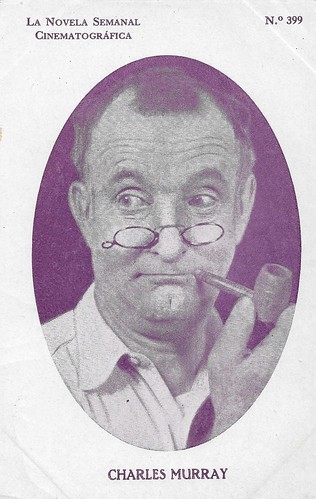
Spanish postcard by La Novela Semanal Cinematográfica, no. 399.
American comedian Charles Murray (1872-1941) worked with George Sydney on a series of comedies around the Jewish Nate Cohen and the Irish-Catholic Patrick Kelly, two business partners who are constantly fighting. Murray joined Biograph in 1912 (some sources say 1914). Two years later, he moved to Keystone, where he played the Hogan character. He appeared in several films opposite Charlie Chaplin and Mabel Normand. He remained a popular actor in 2-reel comedy shorts throughout the 1920s. Murray appeared in 283 films between 1912 and 1938, and also directed 5 films.
Spanish caricatures of American comedians by Martinez
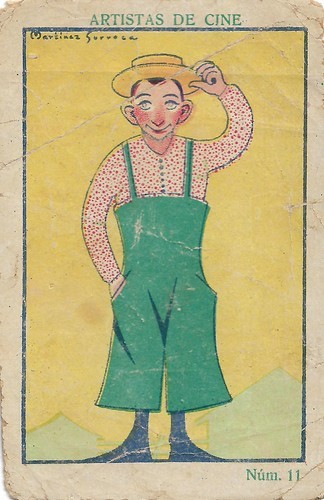
Spanish collectors card by Chocolates Amatller, Barcelona, in the 'Artistas de cine' series, no. 11: Larry Semon. Image: Martinez Surroca. Fulgencio Martínez Surroca (1902-1967) was a Spanish cartoonist, illustrator and publicist.
Lawrence 'Larry' Semon (1889-1928) was an American actor, director, producer, and screenwriter during the silent film era. In his day, Semon was considered a major film comedian, but he is now remembered mainly for working with both Stan Laurel and Oliver Hardy before they started working together. He is also sometimes noted for directing (as well as appearing in) the silent film The Wizard of Oz (1925), which had a slight influence on the better-known sound version, The Wizard of Oz (1939).
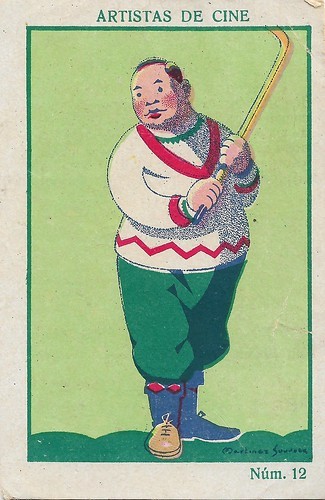
Spanish collectors card by Chocolates Amatller, Barcelona, in the 'Artistas de cine' series, no. 12: Walter Hiers. Image: Martinez Surroca.
Walter Hiers (1893-1933) was an American actor in silent cinema. During his two-decade-long acting career, spanning from 1912 to 1932, Hiers acted in over 100 films. He started out in 1912 in shorts by the Edison company, with William Wadsworth in the lead, while in 1913 -1914 he played at Lubin's, followed by a wide range of companies in subsequent years. In 1916 he did a whole string of shorts for Thanhouser.
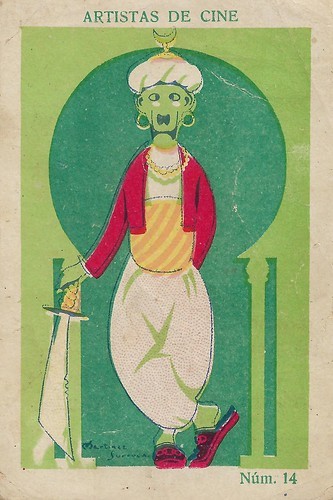
Spanish collectors card by Chocolates Amatller, Barcelona, in the 'Artistas de cine' series, no. 14: Ben Turpin. Image: Martinez Surroca.
Cross-eyed silent comedian Ben Turpin (1869-1940) was not born that way. Supposedly his right eye slipped out of alignment while playing the role of the similarly afflicted Happy Hooligan in vaudeville and it never adjusted. Ironically, it was this disability that would enhance his comic value and make him a top name in the silent film era. Turpin's true forte was impersonating the most dashingly romantic and sophisticated stars of the day and turning them into clumsy oafs. He also invented a Hollywood tradition by being the first actor to receive a pie in his face.
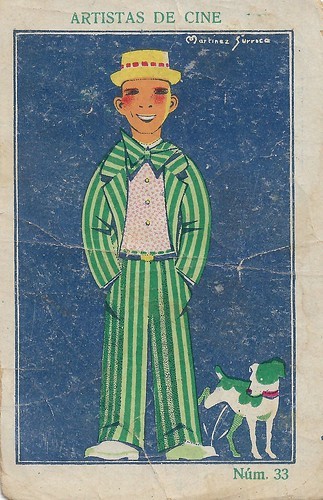
Spanish collectors card by Chocolates Amatller, Barcelona, in the 'Artistas de cine' series, no. 33: Bobby Vernon. Image: Martinez Surroca.
Bobby Vernon (1897-1939) was an American comedic actor in silent films. Blue-eyed with medium brown hair, he stood five feet and two-and-a-half inches, making him perfect for juvenile comedy roles. His comedies were popular with children. Mack Sennett teamed him up with young Gloria Swanson in nine comedies between 1916 and 1917, most memorably in Teddy at the Throttle (1917). He later became a writer and comedy supervisor at Paramount for W. C. Fields and Bing Crosby, when the sound era arrived.
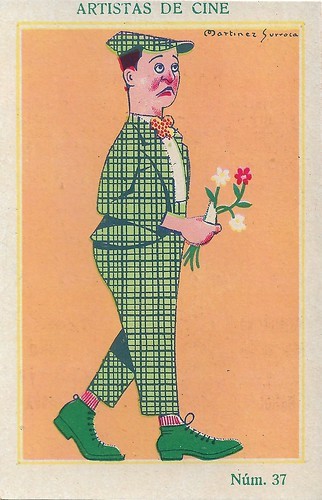
Spanish collectors card by Chocolates Amatller, Barcelona, in the 'Artistas de cine' series, no. 37: Lloyd Hamilton. Image: Martinez Surroca.
Lloyd Hamilton (1891-1935) was an American film comedian. He is one of the numerous important comedians during the silent era whose popularity has turned into almost complete obscurity, Hamilton has nevertheless earned a reputation as an original talent. He teamed up with Bud Duncan in Kalem's 'Ham and Bud'-series, being one of the very first permanent comedy teams produced in the movies. The series turned out moderately popular and ran for three years. Hamilton left Kalem for Fox in late 1917 and starred in such comedies as Moonshine (1920) and The Simp (1920), and was hailed in the press as a "great comedy coup". He produced many fine short comedies throughout the decade, such as Move Along (1926), Nobody's Business (1926), and Somebody's Fault (1927), most of which were directed by Norman Taurog.
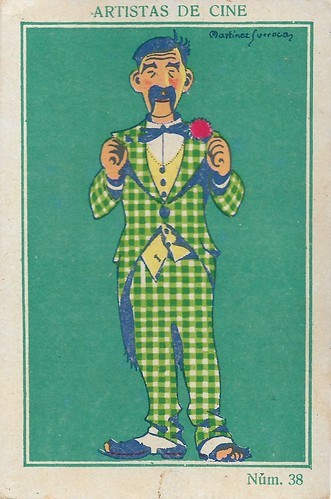
Spanish collectors card by Chocolates Amatller, Barcelona, in the 'Artistas de cine' series, no. 38: Snub Pollard. Image: Martinez Surroca.
Australian-born comedian Snub Pollard (1889-1962) with his walrus moustache was one of the well-known faces of the Hal Roach company during the 1910s. 'Snub' started off in bit parts at the Essanay Film Studios in 1911 and briefly worked with the Keystone Kops. Moving up into support roles, often with the Keystone Cops series, Hal Roach took an avid interest in him and, by 1915, had Snub co-starring with Harold Lloyd and Bebe Daniels in the highly successful Lonesome Luke series, which ran for years (86 films in all). In 1919, Snub took a chance and ventured on with his own solo one- and two-reelers with zany slapstick, sights gags, and gimmicks-a-plenty.
Comedy stars we should never forget
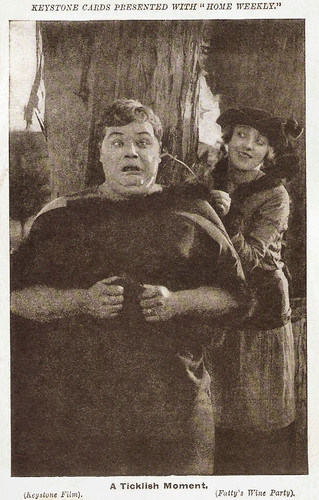
American postcard by Keystone cards, presented with Home Weekly. Photo: Keystone Film. Publicity still for Fatty's Wine Party (Roscoe 'Fatty' Arbuckle, 1914) with Fatty Arbuckle and Mabel Normand . Caption: A Ticklish Moment.
American silent film actor, comedian Roscoe ‘Fatty’ Arbuckle (1887-1933) was one of the most popular silent stars of the 1910s. He started at the Selig Polyscope and moved to Keystone Studios, where he worked with Mabel Normand and Harold Lloyd. Arbuckle mentored Charlie Chaplin and discovered Buster Keaton and Bob Hope. In 1920, he signed a contract with Paramount Pictures for US$1 million.

British postcard in the series "Keystone cards presented with Home Weekly". Photo: Keystone Film. Mabel Normand in The Sea Nymphs (Mack Sennett, 1914). Caption: Mabel as a sea nymph.
Mabel Normand (1892-1930) was a popular American silent film comedienne, in particular in her films with Charlie Chaplin. But alcohol, drugs, and scandal wrecked her career and TBC killed her at a young age.

British postcard in the series "Keystone cards presented with Home Weekly". Photo: Keystone Film. Chester Conklin and Minta Durfee in A Bird's A Bird (Walter Wright, 1915).
American comedian Chester Conklin (1886-1971) developed for Vaudeville his character patterned after his boss, a German baker named Schultz, with a thick accent and a very bushy walrus moustache. After seeing several of Mack Sennett's Keystone Kops shorts, Conklin applied for a job and stayed with Sennett for six years. Conklin became famous for his pairing with burly comic Mack Swain in a series of Ambrose and Walrus shorts. He also appeared in several of Charles Chaplin's shorts for the studio.
American comedienne Minta Durfee (1889-1975) began her career on stage in 1908 as a chorus girl in musical revues. She married comedian Roscoe 'Fatty' Arbuckle. In 1914, they entered Keystone and were soon a comedy double. Minta became Chaplin's leading lady in the two-reeler Making a Living (1914). In addition to the series of 'Fatty' featurettes, Minta also worked at Keystone in the classic madcap farce Tillie's Punctured Romance (1914) and co-starred opposite Chester Conklin, Mack Swain, and Ford Sterling in a series of outrageous daredevil comedies until 1916.
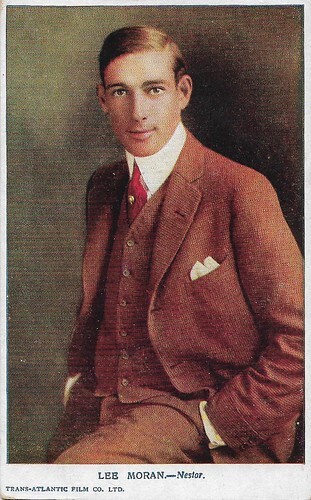
British postcard by Trans-Atlantic Film Co. Ltd. Photo: Nestor Film.
American actor, film director, and screenwriter Lee Moran (1888-1961) transcended the silent film era of motion pictures to the talkies. Moran was often paired with Eddie Lyons and the two made several silent comedies together. In 1912 Moran started at the Nestor company, first in the comedy Three of a Kind (1912), shot in New Mexico. Fall of 1912, Eddie Lyons joined their ranks, probably first in Hearts and Skirts (Al Christie, 1912), and soon became the leading man with Christie's films. Lyons and Moran were often paired as chums, at times also as antagonists in their films. Often the characters of Lyons and Moran were indicated with their first names, Lee and Eddie. Still, Moran also acted in many comedies by Christie without Lyons.
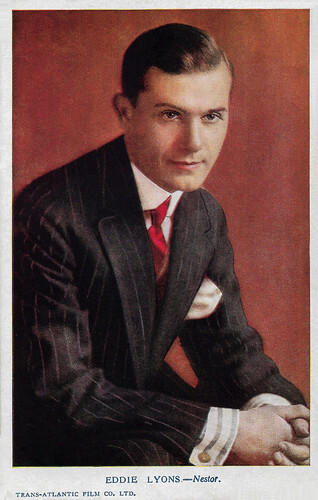
British postcard by Trans-Atlantic Film Co. Ltd. Photo: Nestor Film.
American film actor, director, writer, and producer Eddie Lyons (1886-1926) appeared in 388, directed 153, wrote for 93, and produced 40 films between 1911 and 1926. Debuting in minor parts at Biograph in 1911, Lyons moved in 1912 to IMP (Independent Motion Pictures of America), where he immediately got leads or major supporting parts in dramas and comedies, e.g. with Margarita Fischer. End of 1912 he shifted to Nestor Film. Just like his future film partner Lee Moran, Lyons was trained in vaudeville, hence their long-lasting partnership in acting together (from late 1912) at Nestor, and from 1916 also in directing and writing at Nestor and from 1918 at Universal, making hundreds of short comedies. The chums were immensely popular with American audiences. After his split with Moran in 1920/1921, Lyons continued with his own film company, Eddie Lyons Comedies (1921-1924). After that, Lyons' career slowed down and he had only a few minor parts in features in 1925-1926. In 1926 Eddie Lyons suddenly died of appendicitis in Pasadena, California.
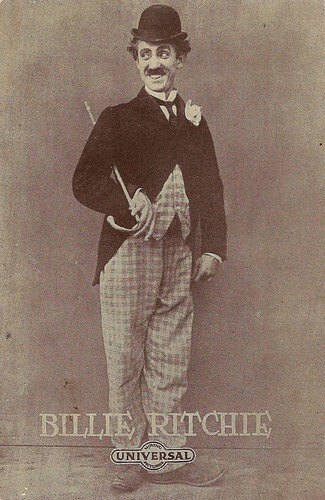
American postcard. Photo: Universal Moving Pictures. On the back an ink stamp by the Auditorium, Taunton, Mass.
Billie Ritchie (1878-1921) was a Scottish comedian who first gained transatlantic fame as a performer for British music hall producer Fred Karno — this, a full decade before Stan Laurel and Charlie Chaplin took a similar career path. Ritchie always claimed that Charlie Chaplin imitated his on-stage character of a rag-bedecked 'little tramp', although he himself was saddled with the description of being one of the many Chaplin imitators. Ritchie is best recalled today for the silent comedy shorts he made between 1914 and 1920 for director/producer Henry Lehrman's L-KO Kompany (distributed by Universal and its British distribution branch Transatlantic), and Fox Film Sunshine Comedy unit. While Lehrman directed Ritchie himself initially in 1914, afterward other directors such as Harry Edwards and Al Christie took over. Regular co-actors were Eva Nelson and Gene Rogers. In 1917 Ritchie stepped over to Fox, where Lehrman, F. Richard Jones, William Campbell, and others directed him, while actresses such as Virginia Rappe and Betty Carpenter co-acted.
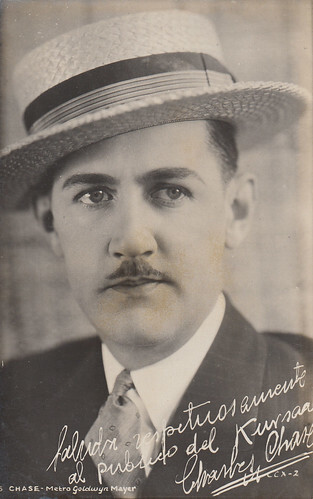
Spanish postcard by IFG. Photo: Metro Goldwyn Mayer. Collection: Marlene Pilaete.
American comedian, actor, screenwriter, and film director Charley Chase (1893-1940) was best known for his work in Hal Roach short film comedies. Chase usually portrayed an apparently gentle and charming man who in reality, it eventually turned out, was quite a loser after all. While Chase is less famous than 'The Big Three' (Charles Chaplin, Buster Keaton, and Harold Lloyd), he's highly respected today by fans of silent comedy.
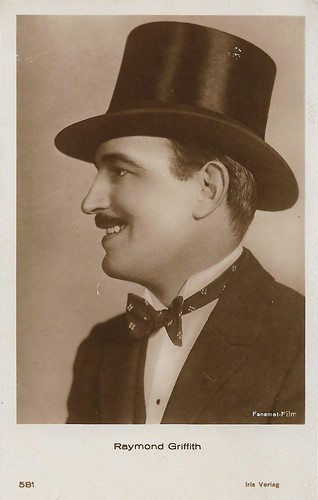
Austrian postcard by Iris Verlag, no. 581. Photo: Fanamet-Film.
Raymond Griffith (1895-1957) was an American comedian, known for such silent films as Paths to Paradise (1925) and Hands Up! (1926). In the sound era, he worked as a production supervisor and associate producer.
Five funny ladies
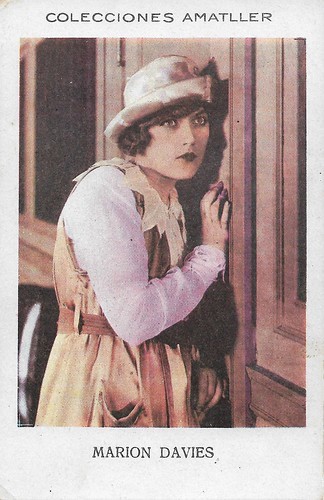
Spanish collectors card by Chocolate Amatller, Series KK, Artist 48, no. 94.
Marion Davies (1897-1961) was one of the great comedic actresses of the silent era. She starred in nearly four dozen films between 1917 and 1937. By 1924, Davies was the number one female box office star in Hollywood because of the popularity of the historical dramas When Knighthood Was in Flower (1922) and Little Old New York (1923), which were among the biggest box-office hits of their respective years. However, she was at her best in contemporary comedies, especially three directed by King Vidor, The Patsy (1928), the backstage-in-Hollywood saga Show People (1928), and Not So Dumb (1930).
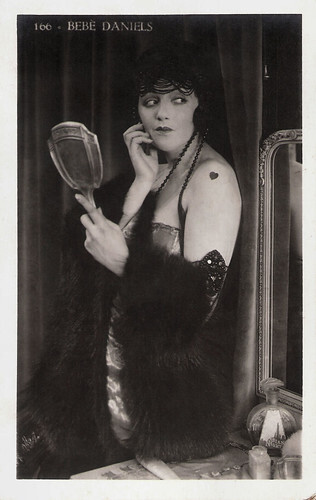
Italian postcard, no. 166. Photo: Bebe Daniels in Why Change Your Wife? (Cecil B. DeMille, 1920).
Bebe Daniels (1901-1971) was an American actress, singer, dancer, writer, and producer. She began her career in Hollywood during the silent film era as a child actress and later as the love interest of Harold Lloyd in dozens of short comedies. Cecil B. de Mille made her a silent star and later she sang and danced in early musicals like Rio Rita (1929) and 42nd Street (1933). In Great Britain, she gained further fame on stage, radio, and television. In her long career, Bebe Daniels appeared in 230 films.
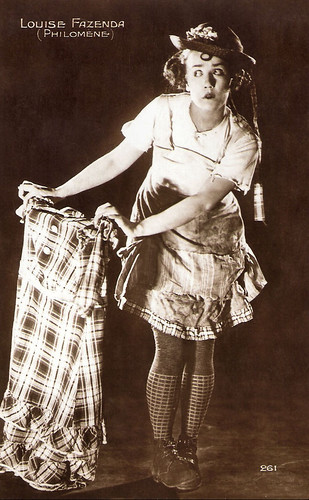
French postcard by Editions Cinémagazine, no. 261. In France, Louise Fazenda was called Philomène.
Louise Fazenda (1895-1962) was a gawky, highly popular funny girl in slapstick comedies for Keystone Studios. She paired up well with comedian Charlie Murray. Her best-known character was her country bumpkin - complete with spit curls, multiple pigtails, and calico dresses. In the early 1920s, Louise left Sennett's company and progressed to feature films, where her eccentric talents were greatly utilised in musicals and knockabout comedies.
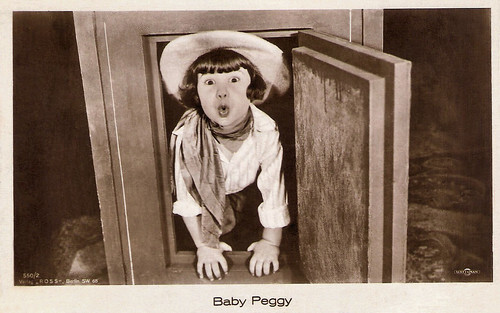
German postcard by Ross Verlag, Berlin, no. 550/2, 1919-1924. Photo: Unifilman.
Baby Peggy (1918-2020) was one of the three major American child stars of the Hollywood silent movie era along with Jackie Coogan and Baby Marie. The first film, Playmates in 1921, was a success, and Peggy was signed to a long-term contract with Century Studios. Between 1921 and 1923 she made over 150 short comedies for Century. In 1922 she received 1.2 million fan letters and by 1924 she had been dubbed 'The Million Dollar Baby' for her $1.5 million a year salary. Only a handful of Baby Peggy shorts, including Playmates (1921), Miles of Smiles (1923), and Sweetie (1923) have been discovered and preserved in film archives around the world.
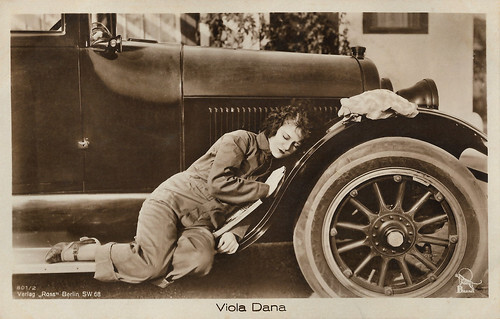
German postcard by Ross Verlag, Berlin, no. 801/2, 1925-1926. Photo: British-American Films AG (BAFAG).
American film actress Viola Dana (1897-1987) was successful during the silent era. She became a star with the Edison Company, working at their studio in the Bronx. Dana's success in Collins's Edison features such as Children of Eve (1915) and The Cossack Whip (1916) encouraged producer B. A. Rolfe to offer the couple lucrative contracts with his company, Rolfe Photoplays, which released their films through Metro Pictures Corporation. Vola starred for Rolfe/Metro in hits like The Girl Without a Soul (1917) and Blue Jeans (1917). Dana continued to act throughout the 1920s, but her popularity gradually waned. One of her last important roles was in Frank Capra's first film for Columbia Pictures, That Certain Thing (1928).
The Big Four
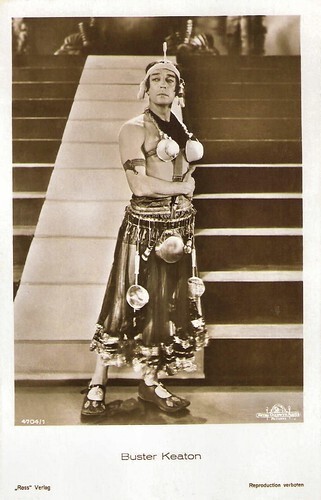
German postcard by Ross Verlag, no. 4704/1, 1929-1930. Photo: MGM. Buster Keaton as Princess Raja in The Hollywood Revue of 1929 (Charles Reisner, 1929). This performance must have been inspired by the Egyptian dance in The Cook (Roscoe 'Fatty' Arbuckle, 1918).
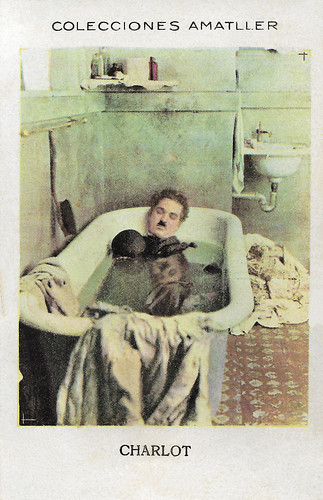
Spanish collectors card in the Collecciones Amatller Series, Serie D, artist no. 7, no. 26, by Chocolate Amatller. Photo: Charlie Chaplin in Pay Day (Charles Chaplin, 1922).
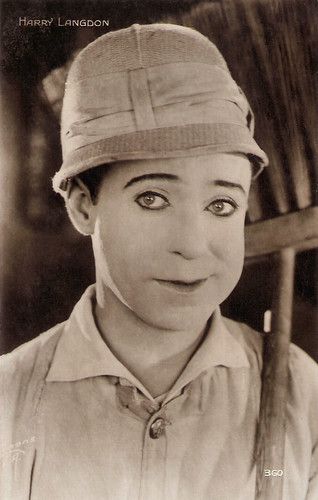
French postcard by Cinémagazine-Edition, Paris, no. 360. Photo: George Frederic Cannons, Los Angeles. Harry Langdon in Feet of Mud (Harry Edwards, 1924).
Hollywood comedian Harry Langdon (1884-1944), often called 'Baby Face', had enormous success during his heyday. Early in his film career, he had the good fortune to work regularly with director Harry Edwards, writer Frank Arthur Ripley, and the young Frank Capra. They created his unique character of the innocent and helpless man-child who found himself in dramatic and hazardous circumstances with only providence and good luck to survive. Despite his success, Langdon has remained far more obscure than his contemporaries as Charlie Chaplin, Buster Keaton, and Harold Lloyd.
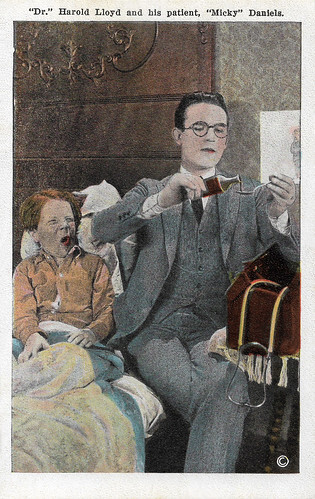
American postcard by Postcard Co. California, Los Angeles. Photo: Glen G. Stone, Los Angeles. Harold Lloyd and Mickey Daniels in Dr. Jack (1922). Captions: "Dr." Harold Lloyd and his patient, 'Mickey' Daniels. (front) Showing Harold Lloyd in the role of a doctor who "dispenses happiness". Both he and his patient "look their parts". For the freckled youngster, the happiness has evidently to come after the dose.
American actor, comedian, director, producer, screenwriter, and stunt performer Harold Lloyd (1893-1971) is best known for his silent comedies. He ranks alongside Charlie Chaplin and Buster Keaton as one of the three most popular and influential comedians of the silent film. Between 1914 and 1947, Lloyd made nearly 200 comedies, often as a bespectacled 'Glass' character, a resourceful, success-seeking go-getter who was perfectly in tune with the 1920s-era United States. His films frequently contained 'thrill sequences' of extended chase scenes and daredevil physical feats. A classic is Lloyd hanging from the hands of a clock high above the street in Safety Last! (1923).
And finally, the most famous duo
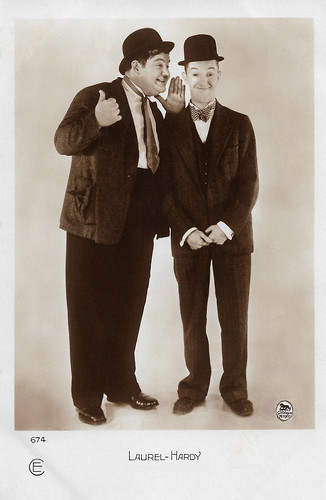
French postcard by Cinémagazine-Edition, Paris, no. 674. Photo: Goldwyn Mayer (MGM). Collection: Geoffrey Donaldson Institute.
Thin Englishman Stan Laurel (1890–1965) and heavyset American Oliver Hardy (1892–1957) were a comedy double act during the early Classical Hollywood era. They became well known during the late 1920s through the mid-1940s for their slapstick comedy with Laurel playing the clumsy and childlike friend of the pompous Hardy.
Sources: Wikipedia and .
The Vitagraph Comedians

British or American postcard. Editor unknown.
American actor and comedian John Bunny (1863-1915) was considered the first true comedy star of the early American silent film era. He acted in over a hundred short comedies at Vitagraph, often with Flora Finch. By 1909 he was already under contract to Vitagraph, and his character as a well-fed, carefree man quickly made him an international silent comedy star. Bunny's comedy was not slapstick, crass, and circus-inspired but polite, middle-class, situational comedy, often situated in domestic settings. He played Mr. Pickwick in The Pickwick Papers (Laurence Trimble, 1913), a three-reeler based on Charles Dicken's classic tale.

British postcard. Editor unknown. Caption: Flora Finch, of the Vitagraph Players.
Flora Finch (1867-1940) was an English-born vaudevillian, stage, and film actress who starred in over 300 silent films. She formed a popular pair with John Bunny in a series of more than a hundred Vitagraph comedies, commonly identified as the 'Bunnygraphs' or 'Bunnyfinches'. Several of the Bunny and Finch comedies have been found in the Desmet Collection of the Eye Filmmuseum (Netherlands) and can be found on Eye's YouTube section, such as Stenographer's Troubles, Bunny's Suicide, and Tangled Tangoists. A candid gossip: Finch disliked Bunny, who reportedly was arrogant, short-tempered, and generally difficult to work with.

French postcard, probably issued by Vitagraph's subsidiary in Paris, no. 3. Photo: Vitagraph. Caption: Maurice Costello, artist of The Vitagraph Co. In contrast to most American film companies, who had London as their hub for the European film distribution market, Vitagraph had opened an office in Paris and arranged its European publicity from there, including the astonishing film posters (de)signed by Harry Bedos.
Maurice Costello (1877-1950) was a prominent American vaudeville actor of the late 1890s and early 1900s, who later became a prominent matinee idol and director at The Vitagraph Co. of America. He made fun of his own image in the delicious comedy The Picture Idol (James Young, 1912) with Clara Kimball Young as his idolising fan.

British postcard. Photo: Vitagraph. Caption: Clara Kimball Young of the Vitagraph Players.
American film actress Clara Kimball Young (1890-1960) was very popular in the early silent film era. After sending a photograph to Vitagraph Studios, Kimball Young was offered a yearly contract in 1912. Young's star at Vitagraph rose quickly. She was predominantly cast in melodramas and romantic comedies as the virtuous heroine. By 1913, she had become one of the more popular leading ladies at Vitagraph. Then, Vitagraph released the drama My Official Wife (James Young, 1914), which starred Young as a Russian revolutionary. The film, which is now lost, was an enormous success and launched Young into first place in the popularity polls.

French postcard, no. 16. Photo: Vitagraph. Caption: Norma Talmadge , artist of The Vitagraph Co. In contrast to most American film companies, who had London as their hub for the European film distribution market, Vitagraph had opened an office in Paris and arranged its European publicity from there, including the astonishing film posters (de)signed by Harry Bedos.
Between 1909 and 1915, Norma Talmadge (1894-1957) was one of the regular actors at Vitagraph, acting in hundreds of shorts, but also in the feature The Battlecry for Peace. She was a major box-office draw for more than a decade. Her career reached a peak in the early 1920s when she ranked among the most popular idols on the American screen.

British postcard. Photo: Vitagraph. Caption: Lillian Walker of the Vitagraph Players.
American silent film actress Lillian Walker (1887-1975) appeared in 178 films between 1909 and 1934. In 1909 she could be seen in her first part in a Vitagraph film, C.Q.D.; or, Saved by Wireless; a True Story of the Wreck of the Republic. She did 18 shorts in 1911, both dramas and comedies. Nicknamed 'Dimples', she played in the comedies with John Bunny and Wally Van. 1912 was a top year at Vitagraph with some 43 short films, followed by 35 more films in 1913, 28 in 1914, and 23 in 1915. Memorable were films like Those Troublesome Tresses, Cinderella's Slippers, and Miss Tomboy.
American silent comedians by La Novela Semanal Cinematográfica

Spanish postcard by La Novela Semanal Cinematográfica, no. 3. Photo: United Artists (but the film was produced by First National). Charles Chaplin in A Dog's Life (Charles Chaplin, 1918). Charlot was the Spanish nickname for Chaplin.
English comedian Charles ‘Charlie’ Chaplin (1889-1977) was one of the most creative and influential personalities of the silent-film era. His most famous role was that of The Tramp with his toothbrush mustache, undersized bowler hat, and bamboo cane who struggled to survive while keeping his dignity in a world with great social injustice. Chaplin used mime, slapstick, and other visual comedy routines, and he not only starred in his films, but also directed, wrote, and produced them, and composed the music as well. His working life in entertainment spanned over 75 years, from the Victorian stage and the Music Hall in the United Kingdom as a child performer, until close to his death at the age of 88. Author George Bernard Shaw called Chaplin "the only genius to come out of the movie industry".

Spanish collectors card by La Novela Semanal Cinematográfica, no. 11.
Constance Talmadge (1898-1973) was an actress of the American silent screen, who started at Vitagraph in 1914. Talmadge had her breakthrough as the tomboyish Mountain Girl in D.W. Griffith's Intolerance (1916). Talmadge appeared in over 80 films, mostly comedies of manners, for which Anita Loos wrote several scripts, such as A Pair of Silk Stockings (1918), Happiness à la Mode (1919), Romance and Arabella (1919), Wedding Bells (1921), and The Primitive Lover (1922). Together with her sister Norma, Constance Talmadge was billed as one of the biggest stars of the twenties.

Spanish card by La Novela Semanal Cinematográfica, no. 14. Photo: United Artists.
Cross-eyed silent comedian Ben Turpin (1869-1940) was not born that way. Supposedly his right eye slipped out of alignment while playing the role of the similarly afflicted Happy Hooligan in vaudeville and it never adjusted. Ironically, it was this disability that would enhance his comic value and make him a top name in the silent film era. Turpin's true forte was impersonating the most dashingly romantic and sophisticated stars of the day and turning them into clumsy oafs. He also invented a Hollywood tradition by being the first actor to receive a pie in his face.

Spanish card by La Novela Semanal Cinematográfica, no. 84.
Wesley Barry (1907-1994) was an adorable child actor in silent comedies who was known for his face full of freckles. He later became a producer and director of both film and television. As a director, he was sometimes billed as Wesley E. Barry.

Spanish card by La Novela Semanal Cinematográfica, no. 106.
Buddy Messinger (1907–1965) was a popular child actor in American silent cinema of the late 1910s and 1920s. Between 1923 and 1925 he had his own series on the character of Buddy, produced by Century Film and distributed by Universal. In 1926-27 he worked for Bray Studios, and in 1928 he was in many episodes of the Drugstore Cowboy one-reel comedies. He continued in the sound era till the early 1940s - but in uncredited parts - while from the 1950s he worked as assistant director.

Spanish card by La Novela Semanal Cinematográfica, no. 150.
Al St. John (1892-1963) was an early American film comedian, and nephew of Roscoe 'Fatty' Arbuckle, with whom he often appeared. He appeared in dozens of Mack Sennett's early Keystone comedies and worked with Charlie Chaplin, Buster Keaton, and Mabel Normand. He would eventually create and star in his own vehicles for other studios. In the sound era, he was the sidekick of B-Western heroes like Bob Steele and Buster Crabbe. He played the scruffy comedy relief character 'Fuzzy Q. Jones' in the Billy the Kid series (1940-1946), and the Lone Rider series (1941-1943). From 1912 to 1952, Al St. John acted in 346 films.

Spanish postcard by La Novela Semanal Cinematográfica, no. 399.
American comedian Charles Murray (1872-1941) worked with George Sydney on a series of comedies around the Jewish Nate Cohen and the Irish-Catholic Patrick Kelly, two business partners who are constantly fighting. Murray joined Biograph in 1912 (some sources say 1914). Two years later, he moved to Keystone, where he played the Hogan character. He appeared in several films opposite Charlie Chaplin and Mabel Normand. He remained a popular actor in 2-reel comedy shorts throughout the 1920s. Murray appeared in 283 films between 1912 and 1938, and also directed 5 films.
Spanish caricatures of American comedians by Martinez

Spanish collectors card by Chocolates Amatller, Barcelona, in the 'Artistas de cine' series, no. 11: Larry Semon. Image: Martinez Surroca. Fulgencio Martínez Surroca (1902-1967) was a Spanish cartoonist, illustrator and publicist.
Lawrence 'Larry' Semon (1889-1928) was an American actor, director, producer, and screenwriter during the silent film era. In his day, Semon was considered a major film comedian, but he is now remembered mainly for working with both Stan Laurel and Oliver Hardy before they started working together. He is also sometimes noted for directing (as well as appearing in) the silent film The Wizard of Oz (1925), which had a slight influence on the better-known sound version, The Wizard of Oz (1939).

Spanish collectors card by Chocolates Amatller, Barcelona, in the 'Artistas de cine' series, no. 12: Walter Hiers. Image: Martinez Surroca.
Walter Hiers (1893-1933) was an American actor in silent cinema. During his two-decade-long acting career, spanning from 1912 to 1932, Hiers acted in over 100 films. He started out in 1912 in shorts by the Edison company, with William Wadsworth in the lead, while in 1913 -1914 he played at Lubin's, followed by a wide range of companies in subsequent years. In 1916 he did a whole string of shorts for Thanhouser.

Spanish collectors card by Chocolates Amatller, Barcelona, in the 'Artistas de cine' series, no. 14: Ben Turpin. Image: Martinez Surroca.
Cross-eyed silent comedian Ben Turpin (1869-1940) was not born that way. Supposedly his right eye slipped out of alignment while playing the role of the similarly afflicted Happy Hooligan in vaudeville and it never adjusted. Ironically, it was this disability that would enhance his comic value and make him a top name in the silent film era. Turpin's true forte was impersonating the most dashingly romantic and sophisticated stars of the day and turning them into clumsy oafs. He also invented a Hollywood tradition by being the first actor to receive a pie in his face.

Spanish collectors card by Chocolates Amatller, Barcelona, in the 'Artistas de cine' series, no. 33: Bobby Vernon. Image: Martinez Surroca.
Bobby Vernon (1897-1939) was an American comedic actor in silent films. Blue-eyed with medium brown hair, he stood five feet and two-and-a-half inches, making him perfect for juvenile comedy roles. His comedies were popular with children. Mack Sennett teamed him up with young Gloria Swanson in nine comedies between 1916 and 1917, most memorably in Teddy at the Throttle (1917). He later became a writer and comedy supervisor at Paramount for W. C. Fields and Bing Crosby, when the sound era arrived.

Spanish collectors card by Chocolates Amatller, Barcelona, in the 'Artistas de cine' series, no. 37: Lloyd Hamilton. Image: Martinez Surroca.
Lloyd Hamilton (1891-1935) was an American film comedian. He is one of the numerous important comedians during the silent era whose popularity has turned into almost complete obscurity, Hamilton has nevertheless earned a reputation as an original talent. He teamed up with Bud Duncan in Kalem's 'Ham and Bud'-series, being one of the very first permanent comedy teams produced in the movies. The series turned out moderately popular and ran for three years. Hamilton left Kalem for Fox in late 1917 and starred in such comedies as Moonshine (1920) and The Simp (1920), and was hailed in the press as a "great comedy coup". He produced many fine short comedies throughout the decade, such as Move Along (1926), Nobody's Business (1926), and Somebody's Fault (1927), most of which were directed by Norman Taurog.

Spanish collectors card by Chocolates Amatller, Barcelona, in the 'Artistas de cine' series, no. 38: Snub Pollard. Image: Martinez Surroca.
Australian-born comedian Snub Pollard (1889-1962) with his walrus moustache was one of the well-known faces of the Hal Roach company during the 1910s. 'Snub' started off in bit parts at the Essanay Film Studios in 1911 and briefly worked with the Keystone Kops. Moving up into support roles, often with the Keystone Cops series, Hal Roach took an avid interest in him and, by 1915, had Snub co-starring with Harold Lloyd and Bebe Daniels in the highly successful Lonesome Luke series, which ran for years (86 films in all). In 1919, Snub took a chance and ventured on with his own solo one- and two-reelers with zany slapstick, sights gags, and gimmicks-a-plenty.
Comedy stars we should never forget

American postcard by Keystone cards, presented with Home Weekly. Photo: Keystone Film. Publicity still for Fatty's Wine Party (Roscoe 'Fatty' Arbuckle, 1914) with Fatty Arbuckle and Mabel Normand . Caption: A Ticklish Moment.
American silent film actor, comedian Roscoe ‘Fatty’ Arbuckle (1887-1933) was one of the most popular silent stars of the 1910s. He started at the Selig Polyscope and moved to Keystone Studios, where he worked with Mabel Normand and Harold Lloyd. Arbuckle mentored Charlie Chaplin and discovered Buster Keaton and Bob Hope. In 1920, he signed a contract with Paramount Pictures for US$1 million.

British postcard in the series "Keystone cards presented with Home Weekly". Photo: Keystone Film. Mabel Normand in The Sea Nymphs (Mack Sennett, 1914). Caption: Mabel as a sea nymph.
Mabel Normand (1892-1930) was a popular American silent film comedienne, in particular in her films with Charlie Chaplin. But alcohol, drugs, and scandal wrecked her career and TBC killed her at a young age.

British postcard in the series "Keystone cards presented with Home Weekly". Photo: Keystone Film. Chester Conklin and Minta Durfee in A Bird's A Bird (Walter Wright, 1915).
American comedian Chester Conklin (1886-1971) developed for Vaudeville his character patterned after his boss, a German baker named Schultz, with a thick accent and a very bushy walrus moustache. After seeing several of Mack Sennett's Keystone Kops shorts, Conklin applied for a job and stayed with Sennett for six years. Conklin became famous for his pairing with burly comic Mack Swain in a series of Ambrose and Walrus shorts. He also appeared in several of Charles Chaplin's shorts for the studio.
American comedienne Minta Durfee (1889-1975) began her career on stage in 1908 as a chorus girl in musical revues. She married comedian Roscoe 'Fatty' Arbuckle. In 1914, they entered Keystone and were soon a comedy double. Minta became Chaplin's leading lady in the two-reeler Making a Living (1914). In addition to the series of 'Fatty' featurettes, Minta also worked at Keystone in the classic madcap farce Tillie's Punctured Romance (1914) and co-starred opposite Chester Conklin, Mack Swain, and Ford Sterling in a series of outrageous daredevil comedies until 1916.

British postcard by Trans-Atlantic Film Co. Ltd. Photo: Nestor Film.
American actor, film director, and screenwriter Lee Moran (1888-1961) transcended the silent film era of motion pictures to the talkies. Moran was often paired with Eddie Lyons and the two made several silent comedies together. In 1912 Moran started at the Nestor company, first in the comedy Three of a Kind (1912), shot in New Mexico. Fall of 1912, Eddie Lyons joined their ranks, probably first in Hearts and Skirts (Al Christie, 1912), and soon became the leading man with Christie's films. Lyons and Moran were often paired as chums, at times also as antagonists in their films. Often the characters of Lyons and Moran were indicated with their first names, Lee and Eddie. Still, Moran also acted in many comedies by Christie without Lyons.

British postcard by Trans-Atlantic Film Co. Ltd. Photo: Nestor Film.
American film actor, director, writer, and producer Eddie Lyons (1886-1926) appeared in 388, directed 153, wrote for 93, and produced 40 films between 1911 and 1926. Debuting in minor parts at Biograph in 1911, Lyons moved in 1912 to IMP (Independent Motion Pictures of America), where he immediately got leads or major supporting parts in dramas and comedies, e.g. with Margarita Fischer. End of 1912 he shifted to Nestor Film. Just like his future film partner Lee Moran, Lyons was trained in vaudeville, hence their long-lasting partnership in acting together (from late 1912) at Nestor, and from 1916 also in directing and writing at Nestor and from 1918 at Universal, making hundreds of short comedies. The chums were immensely popular with American audiences. After his split with Moran in 1920/1921, Lyons continued with his own film company, Eddie Lyons Comedies (1921-1924). After that, Lyons' career slowed down and he had only a few minor parts in features in 1925-1926. In 1926 Eddie Lyons suddenly died of appendicitis in Pasadena, California.

American postcard. Photo: Universal Moving Pictures. On the back an ink stamp by the Auditorium, Taunton, Mass.
Billie Ritchie (1878-1921) was a Scottish comedian who first gained transatlantic fame as a performer for British music hall producer Fred Karno — this, a full decade before Stan Laurel and Charlie Chaplin took a similar career path. Ritchie always claimed that Charlie Chaplin imitated his on-stage character of a rag-bedecked 'little tramp', although he himself was saddled with the description of being one of the many Chaplin imitators. Ritchie is best recalled today for the silent comedy shorts he made between 1914 and 1920 for director/producer Henry Lehrman's L-KO Kompany (distributed by Universal and its British distribution branch Transatlantic), and Fox Film Sunshine Comedy unit. While Lehrman directed Ritchie himself initially in 1914, afterward other directors such as Harry Edwards and Al Christie took over. Regular co-actors were Eva Nelson and Gene Rogers. In 1917 Ritchie stepped over to Fox, where Lehrman, F. Richard Jones, William Campbell, and others directed him, while actresses such as Virginia Rappe and Betty Carpenter co-acted.

Spanish postcard by IFG. Photo: Metro Goldwyn Mayer. Collection: Marlene Pilaete.
American comedian, actor, screenwriter, and film director Charley Chase (1893-1940) was best known for his work in Hal Roach short film comedies. Chase usually portrayed an apparently gentle and charming man who in reality, it eventually turned out, was quite a loser after all. While Chase is less famous than 'The Big Three' (Charles Chaplin, Buster Keaton, and Harold Lloyd), he's highly respected today by fans of silent comedy.

Austrian postcard by Iris Verlag, no. 581. Photo: Fanamet-Film.
Raymond Griffith (1895-1957) was an American comedian, known for such silent films as Paths to Paradise (1925) and Hands Up! (1926). In the sound era, he worked as a production supervisor and associate producer.
Five funny ladies

Spanish collectors card by Chocolate Amatller, Series KK, Artist 48, no. 94.
Marion Davies (1897-1961) was one of the great comedic actresses of the silent era. She starred in nearly four dozen films between 1917 and 1937. By 1924, Davies was the number one female box office star in Hollywood because of the popularity of the historical dramas When Knighthood Was in Flower (1922) and Little Old New York (1923), which were among the biggest box-office hits of their respective years. However, she was at her best in contemporary comedies, especially three directed by King Vidor, The Patsy (1928), the backstage-in-Hollywood saga Show People (1928), and Not So Dumb (1930).

Italian postcard, no. 166. Photo: Bebe Daniels in Why Change Your Wife? (Cecil B. DeMille, 1920).
Bebe Daniels (1901-1971) was an American actress, singer, dancer, writer, and producer. She began her career in Hollywood during the silent film era as a child actress and later as the love interest of Harold Lloyd in dozens of short comedies. Cecil B. de Mille made her a silent star and later she sang and danced in early musicals like Rio Rita (1929) and 42nd Street (1933). In Great Britain, she gained further fame on stage, radio, and television. In her long career, Bebe Daniels appeared in 230 films.

French postcard by Editions Cinémagazine, no. 261. In France, Louise Fazenda was called Philomène.
Louise Fazenda (1895-1962) was a gawky, highly popular funny girl in slapstick comedies for Keystone Studios. She paired up well with comedian Charlie Murray. Her best-known character was her country bumpkin - complete with spit curls, multiple pigtails, and calico dresses. In the early 1920s, Louise left Sennett's company and progressed to feature films, where her eccentric talents were greatly utilised in musicals and knockabout comedies.

German postcard by Ross Verlag, Berlin, no. 550/2, 1919-1924. Photo: Unifilman.
Baby Peggy (1918-2020) was one of the three major American child stars of the Hollywood silent movie era along with Jackie Coogan and Baby Marie. The first film, Playmates in 1921, was a success, and Peggy was signed to a long-term contract with Century Studios. Between 1921 and 1923 she made over 150 short comedies for Century. In 1922 she received 1.2 million fan letters and by 1924 she had been dubbed 'The Million Dollar Baby' for her $1.5 million a year salary. Only a handful of Baby Peggy shorts, including Playmates (1921), Miles of Smiles (1923), and Sweetie (1923) have been discovered and preserved in film archives around the world.

German postcard by Ross Verlag, Berlin, no. 801/2, 1925-1926. Photo: British-American Films AG (BAFAG).
American film actress Viola Dana (1897-1987) was successful during the silent era. She became a star with the Edison Company, working at their studio in the Bronx. Dana's success in Collins's Edison features such as Children of Eve (1915) and The Cossack Whip (1916) encouraged producer B. A. Rolfe to offer the couple lucrative contracts with his company, Rolfe Photoplays, which released their films through Metro Pictures Corporation. Vola starred for Rolfe/Metro in hits like The Girl Without a Soul (1917) and Blue Jeans (1917). Dana continued to act throughout the 1920s, but her popularity gradually waned. One of her last important roles was in Frank Capra's first film for Columbia Pictures, That Certain Thing (1928).
The Big Four

German postcard by Ross Verlag, no. 4704/1, 1929-1930. Photo: MGM. Buster Keaton as Princess Raja in The Hollywood Revue of 1929 (Charles Reisner, 1929). This performance must have been inspired by the Egyptian dance in The Cook (Roscoe 'Fatty' Arbuckle, 1918).

Spanish collectors card in the Collecciones Amatller Series, Serie D, artist no. 7, no. 26, by Chocolate Amatller. Photo: Charlie Chaplin in Pay Day (Charles Chaplin, 1922).

French postcard by Cinémagazine-Edition, Paris, no. 360. Photo: George Frederic Cannons, Los Angeles. Harry Langdon in Feet of Mud (Harry Edwards, 1924).
Hollywood comedian Harry Langdon (1884-1944), often called 'Baby Face', had enormous success during his heyday. Early in his film career, he had the good fortune to work regularly with director Harry Edwards, writer Frank Arthur Ripley, and the young Frank Capra. They created his unique character of the innocent and helpless man-child who found himself in dramatic and hazardous circumstances with only providence and good luck to survive. Despite his success, Langdon has remained far more obscure than his contemporaries as Charlie Chaplin, Buster Keaton, and Harold Lloyd.

American postcard by Postcard Co. California, Los Angeles. Photo: Glen G. Stone, Los Angeles. Harold Lloyd and Mickey Daniels in Dr. Jack (1922). Captions: "Dr." Harold Lloyd and his patient, 'Mickey' Daniels. (front) Showing Harold Lloyd in the role of a doctor who "dispenses happiness". Both he and his patient "look their parts". For the freckled youngster, the happiness has evidently to come after the dose.
American actor, comedian, director, producer, screenwriter, and stunt performer Harold Lloyd (1893-1971) is best known for his silent comedies. He ranks alongside Charlie Chaplin and Buster Keaton as one of the three most popular and influential comedians of the silent film. Between 1914 and 1947, Lloyd made nearly 200 comedies, often as a bespectacled 'Glass' character, a resourceful, success-seeking go-getter who was perfectly in tune with the 1920s-era United States. His films frequently contained 'thrill sequences' of extended chase scenes and daredevil physical feats. A classic is Lloyd hanging from the hands of a clock high above the street in Safety Last! (1923).
And finally, the most famous duo

French postcard by Cinémagazine-Edition, Paris, no. 674. Photo: Goldwyn Mayer (MGM). Collection: Geoffrey Donaldson Institute.
Thin Englishman Stan Laurel (1890–1965) and heavyset American Oliver Hardy (1892–1957) were a comedy double act during the early Classical Hollywood era. They became well known during the late 1920s through the mid-1940s for their slapstick comedy with Laurel playing the clumsy and childlike friend of the pompous Hardy.
Sources: Wikipedia and .
Published on January 28, 2022 22:00
January 27, 2022
Mickey Rourke
American actor and former boxer Mickey Rourke (1952) received critical praise for his deep, tortured characters in the Charles Bukowski biopic Barfly (1987) and the horror mystery Angel Heart (1987). In 1991, Rourke left acting and became a professional boxer for a time. After returning to acting, he had supporting roles in the remake of Get Carter (2000), and Once Upon a Time in Mexico (2003). Rourke made his mainstream comeback with lead roles in Sin City (2005) and The Wrestler (2008), for which he received a Golden Globe, and an Oscar nomination. Since then, Rourke has appeared in blockbusters like Iron Man 2 (2010) and Immortals (2011).
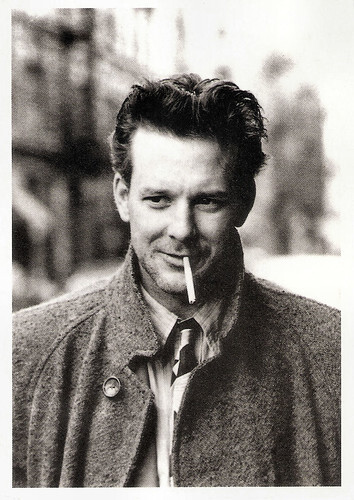
French postcard by Humour a la Carte, Paris, no. ST-186. Photo: TriStar Pictures. Mickey Rourke in Angel Heart (Alan Parker, 1987).
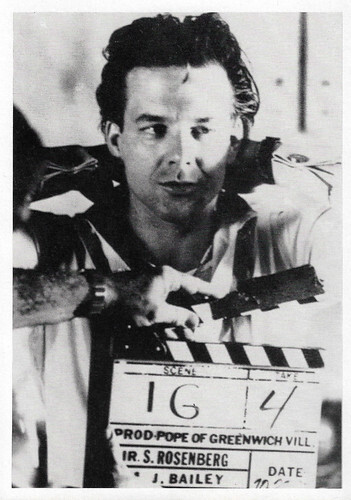
British postcard by Palm Pictures, no. C 7. Mickey Rourke on the set of The Pope of Greenwich Village (Stuart Rosenberg, 1984).
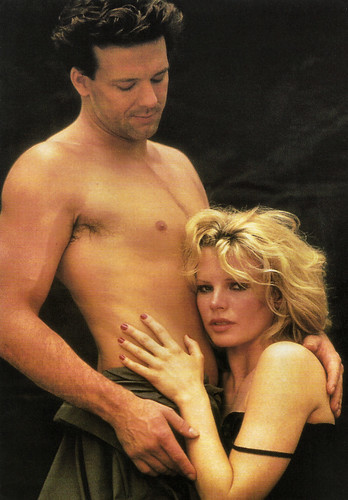
French postcard by Editions F. Nugeron, Paris, no. 2. Photo: Collection de l'École de Cinéma CAMIRIS. Kim Basinger and Mickey Rourke in Nine ½ Weeks (Adrian Lyne, 1986).
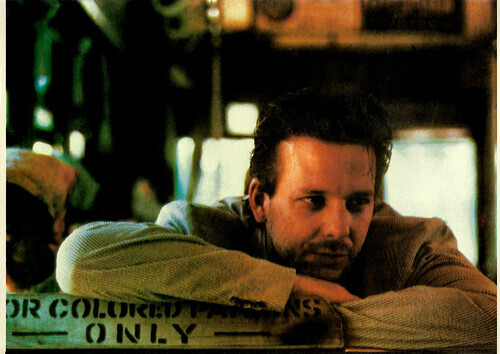
French postcard by Editions La Malibran, Paris, in the Collection Cinema Couleur, no MC 32, 1989. Photo: Mickey Rourke in Angel Heart (Alan Parker, 1987).
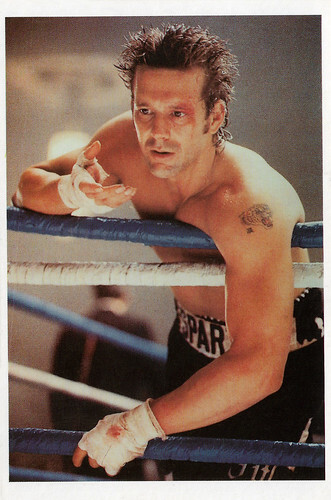
Vintage postcard by World Postcards Inc., no X 177, 1989. Photo: Mickey Rourke in Homeboy (Michael Seresin, 1988).
A shy and reserved student, but very comfortable with improvisation
Philip Andre 'Mickey' Rourke Jr. was born in Schenectady, New York, in 1952, He was the son of Ann (Cameron) and Philip Andre Rourke, a bodybuilder. He has a brother, Joey, and an older sister, Patricia. The nickname Mickey was given to him as a child by his parents, who thought he looked like a mouse.
When he was six, his parents divorced. A year later, his mother married Eugene Addis, a Miami Beach police officer, and mother and son moved to Miami Shores, Florida. There, he went to the Miami Beach Senior High School. Rourke joined a self-defense course at the Boys Club of Miami. Here he learned to box and began a career as an amateur boxer. At that time, he was more interested in baseball and boxing than in acting.
At the age of 12, he won his first match in the 51-54 kg category. He then called himself Andre Rourke. Later, he moved to a gym on 5th Street in Miami and joined the Police Athletic League. In 1969, he briefly became a sparring partner of Luis Rodriguez, who at that time was the world light heavyweight champion. In 1971, he suffered a concussion during a boxing match, so doctors ordered him to stop boxing for a year.
After working for a short time as a busboy at the famed Forge Restaurant on Miami Beach, Rourke moved back to New York to seek out a career in acting. He attended acting classes at the Lee Strasberg Theatre Institute. Rourke says of himself that he was a shy and reserved student, but very comfortable with improvisation. His teacher Sandra Seacat convinced him to move to Los Angeles.
After a few small roles on television, Rourke made his film debut in the small role of Private Reese in Steven Spielberg's war comedy 1941 (1979). A year later, he appeared in Heaven's Gate (Michael Cimino, 1980), one of the biggest commercial failures in film history that meant the end of United Artists. A year later, he appeared alongside Kathleen Turner and William Hurt as a pyro expert in the thriller Body Heat (Lawrence Kasdan, 1982). This is generally regarded as his breakthrough.
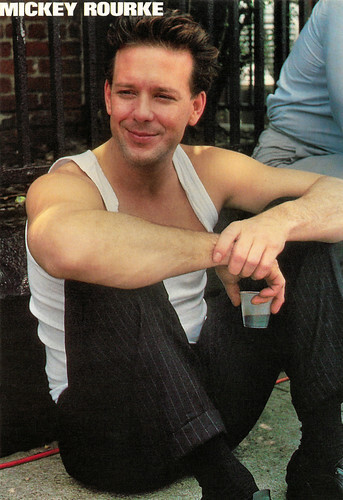
British postcard by Minerva, Holmes McDougall LTD, Edinburgh, no. PC268.
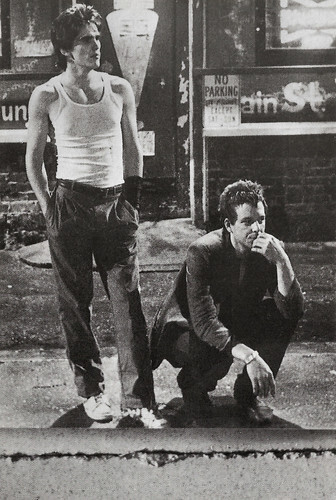
British postcard by Classics Postcards London, no. 59. Matt Dillon and Mickey Rourke in Rumble Fish (Francis Coppola, 1983).
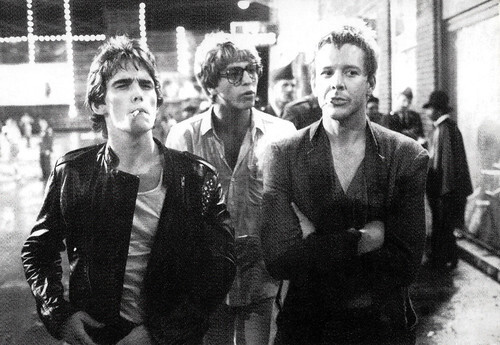
American postcard by Zoetroope Images LTD., Boston, Mass, no. 398. Matt Dillon , Vincent Spano, and Mickey Rourke in Rumble Fish (Francis Coppola, 1983).
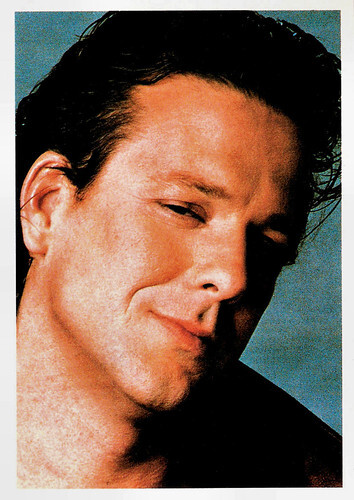
French postcard by Ebullitions, no. 544.
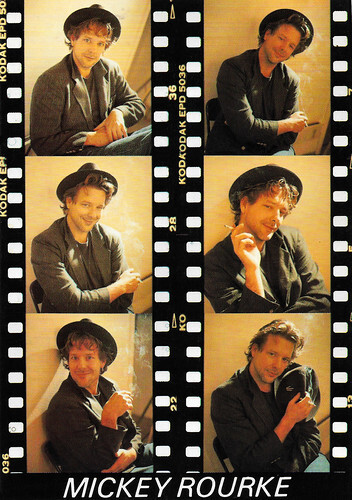
French postcard by Amorimage Productions (distribution by Humour a la Carte), no. ST-183. Photos: Frédérique Veysset.
The sensitive and protective older brother of Matt Dillon
In the 1980s, Mickey Rourke began to claim the lead role a little more often. He was one of Steve Guttenberg and Kevin Bacon's young pals in Barry Levinson's Diner (1982). He appeared as the sensitive and protective older brother of Matt Dillon in Francis Ford Coppola's Rumble Fish (1983).
Rourke had his first lead role in The Pope of Greenwich Village (Stuart Rosenberg, 1984), co-starring with Eric Roberts.
He reunited with Michael Cimino for the violent police film Year of the Dragon (1985), based on a scenario by Oliver Stone. Rourke gave a bravura performance as police captain Stanley White, fanatically determined to eliminate John Lone, the crime boss of New York's Chinatown. The film was hotly contested in the United States, however, with critics denouncing the negative portrayal of Chinese people and the overtly racist nature of its central character.
He gained the status of sex symbol with the erotic drama 9½ Weeks (Adrian Lyne, 1986), which became one of Rourke's best-known films. He plays John, a man who starts an affair with Elizabeth ( Kim Basinger ).
A year later, he played the lead in Angel Heart (Alan Parker, 1987), opposite Robert De Niro . The film was once again controversial in the United States, initially rated X (No one under 17 admitted) because of the sex scene between Rourke and the young Lisa Bonet, fresh off The Cosby Show. The sequence was eventually censored in the cinema and Rated R (Restricted – Under 17 requires accompanying parent or adult guardian).
For his next film, Barfly (Barbet Schroeder, 1987), the actor received rave reviews for his role as the alcoholic writer Henry Chinaski, based on Charles Bukowski. These rebellious anti-hero characters were especially well-liked in Europe and especially France where Rourke was a popular film idol.
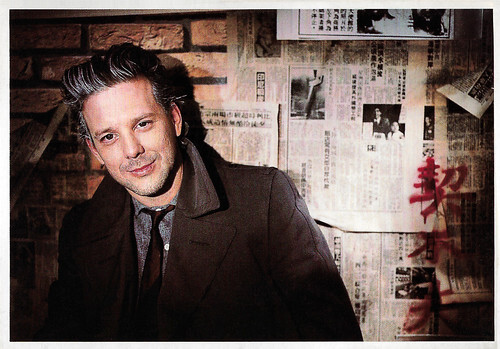
French postcard by Humour a la Carte, Paris, no ST-198. Photo: Marianne Rosenstiehl. Mickey Rourke in Year of the Dragon (Michael Cimino, 1985).
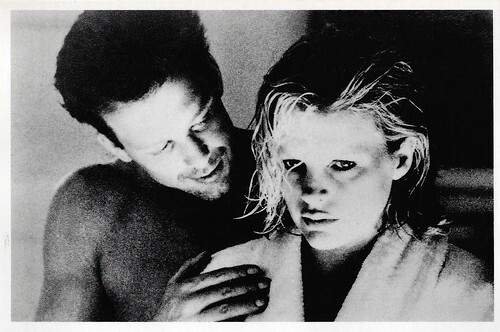
Vintage postcard, no. X 142. Photo: Kim Basinger and Mickey Rourke in Nine ½ Weeks (Adrian Lyne, 1986).
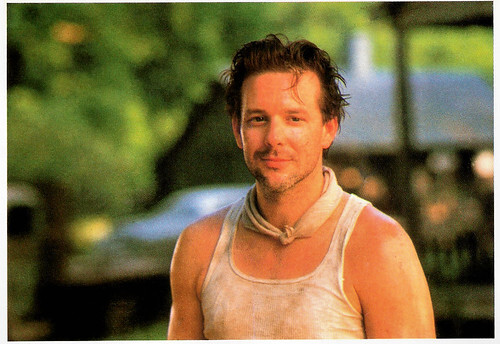
British postcard, no. FA 222. Photo: Mickey Rourke in Angel Heart (Alan Parker, 1987).
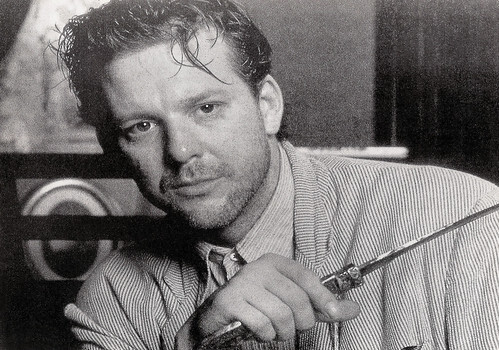
British postcard by Moviedrome, no. M1. Mickey Rourke in Angel Heart (Alan Parker, 1987).
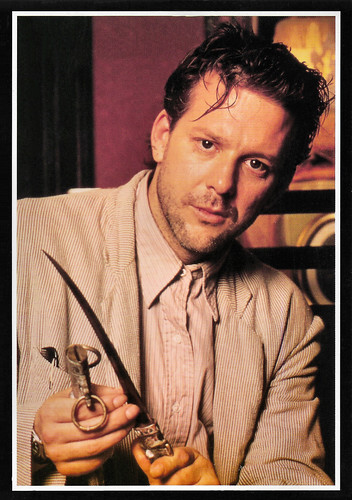
French postcard by Editions Damilla, Paris, no 94967. Photo: Mickey Rourke in Angel Heart (Alan Parker, 1987).
A near brain-dead prizefighter
Mickey Rourke wrote, produced, and starred in Homeboy (Michael Seresin, 1988), a film about a near brain-dead prizefighter. It skipped theatrical release and went straight to home video.
Rourke joined Walter Hill's Johnny Handsome (1989), then appeared in Wild Orchid (Zalman King, 1989). Divorced from his first wife Debra Feuer in 1989, he met actress-model Carré Otis on the set, who became his wife in 1992. The film was mocked by critics for its overall weakness and its sex scenes considered too explicit, some of which were cut to avoid the film being classified as pornographic.
Rourke played another anti-hero in Desperate Hours (Michael Cimino, 1990) but was nominated for a Razzie Award for Worst Actor of the Year for his performances in Wild Orchid and Desperate Hours. He worked with David Bowie on his album 'Never Let Me Down'', but his film career had taken a turn downhill. Another setback was Harley Davidson and the Marlboro Man (Simon Wincer, 1991), with Don Johnson. Rourke later admitted that he only made the film for the money.
Mickey decided to take up boxing again. He felt that he was self-destructive and had no respect for the actor Rourke. His boxing career did not go smoothly. Under the supervision of his coach, Chuck Zito of the Hells Angels, he was often injured. In retrospect, he would admit that he was too old to return to boxing, but that he had done so anyway for personal reasons.
In 1995, he continued to work on his film career but he had to make do with supporting roles. In 1997, Mickey Rourke appeared on screen with his face surgically altered, his features enlarged and his body thickened in Double Team (Tsui Hark', 1997) opposite Jean-Claude Van Damme . Rourke also reprised his role as an s&m fetishist in Another 9 1/2 Weeks (Anne Goursaud, 1997), a virtual remake of the original, only sans the redeeming presence of Kim Basinger .
He had a small part in Francis Ford Coppola's adaptation of John Grisham's The Rainmaker (1997). There were also quite a few roles that barely came to light. In the critically-worshipped The Thin Red Line (Terrence Malick, 1997), his role was edited out. Unemployed and broke, he had to sell his motorbike collection and his Los Angeles mansion to pay off his creditors and was temporarily committed when his friends became concerned about his suicidal tendencies.
In 1999, he played an important role in the Flemish film Shades (Erik Van Looy, 1999). He also appeared as a transvestite prisoner in Steve Buscemi's Animal Factory (2000), and opposite Sylvester Stallone in Get Carter (Stephen T. Kay, 2000). The latter film, above all, enabled him to straighten out his financial situation, thanks to Stallone.
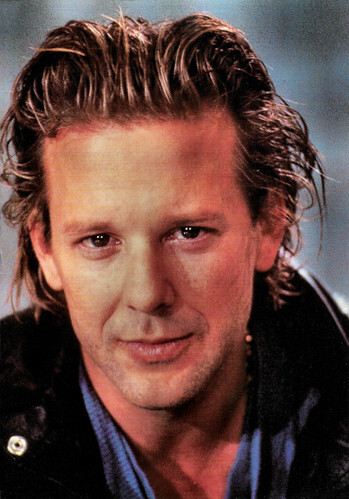
British postcard by Personality Posters LTD., no PP45.
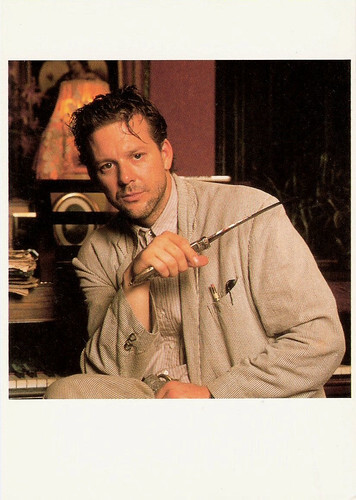
British postcard, no. FA 223. Mickey Rourke in Angel Heart (Alan Parker, 1987).
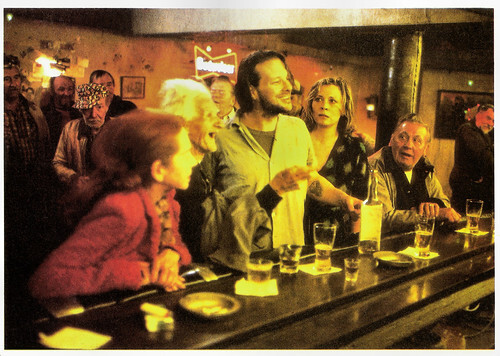
French postcard in the Collection Cinéma Couleur by Editions La Malibran, Paris, no. MC 29, 1989. Photo: Mickey Rourke and Faye Dunaway in Barfly (Barbet Schroeder, 1987).
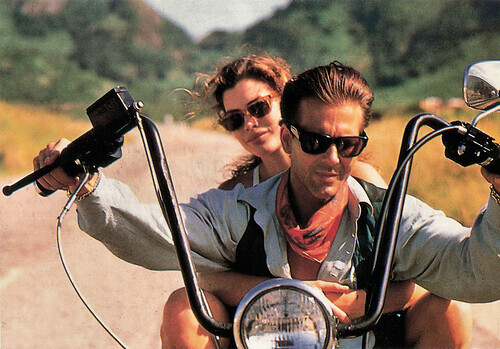
French postcard by Sonis, no. C. 109. Photo: Deal. Mickey Rourke and Carré Otis in Wild Orchid (Zalman King, 1989).
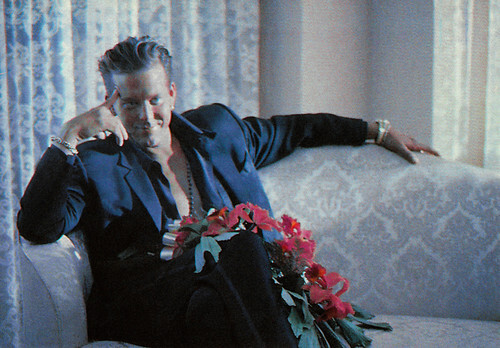
French postcard by Sonis, no. C. 110. Photo: Deal. Mickey Rourke in Wild Orchid (Zalman King, 1989).
An imposing beast of a fellow
Mickey Rourke gave an impressive supporting performance in Sean Penn 's police procedural-cum-harrowing study of obsession, The Pledge (2001) opposite Jack Nicholson .
After Rourke played a role in the music video for the song 'Hero' by Enrique Iglesias , he appeared in Roberto Rodriguez's hit Once Upon a Time in Mexico (2003). As a harbinger of things to come, a powerful creative bond formed between the weathered, iconic Rourke and the tireless director on the Mexico set.
In 2005 they again teamed for Rodriguez's and Frank Miller's eagerly anticipated big-screen adaptation of Miller's Sin City comics. Bruce Lawton writes at AllMovie : "Cast as lovelorn brute Marv, Rourke delivered an impressive performance as an imposing beast of a fellow bent on avenging the death of an angelic prostitute in this stylish noir comic book come to life, which gave him cult status among a new generation of fans.
In 2004, Rourke delivered a memorable supporting performance in Tony Scott's Man on Fire (2004) alongside Denzel Washington. It marked the first film in a two-picture creative partnership between Scott and Rourke, the second half of which came to fruition with Domino (2005) starring Keira Knightley .
In 2008, he collaborated with Darren Aronofsky on the film The Wrestler. Rourke was widely praised for his role as Randy "The Ram" Robinson, a wrestler who is way past his prime. Besides the typical elements of a sports drama, the film also contains some striking similarities with Rourke's own career as a boxer and actor. Mickey Rourke won a Golden Globe in 2009 for this role.
Rourke would enjoy sustained success in the years to follow, appearing in films like The Expendables (Sylvester Stallone, 2010), and Iron Man 2 (Jon Favreau, 2010) with Robert Downey Jr. and Scarlett Johansson. The latter brought in more than $312 million in the United States. His later films include Immortals (Tarsem Singh, 2011), the thriller The Courier (Hany Abu-Assad, 2012), and the Western Dead in Tombstone (Roel Reiné, 2013).
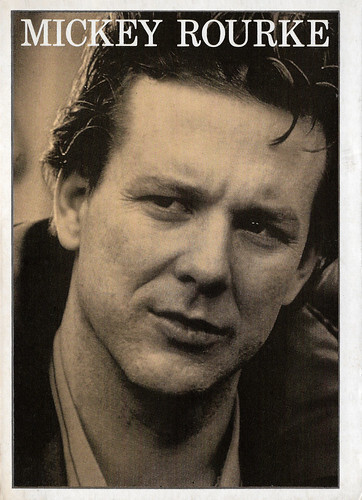
British postcard by Heroes, London, no. SPC2228.
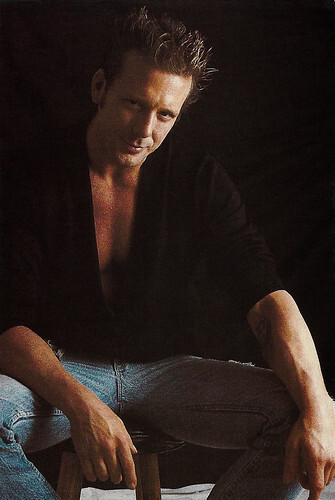
French postcard by Editions SPK, Ref. 265.
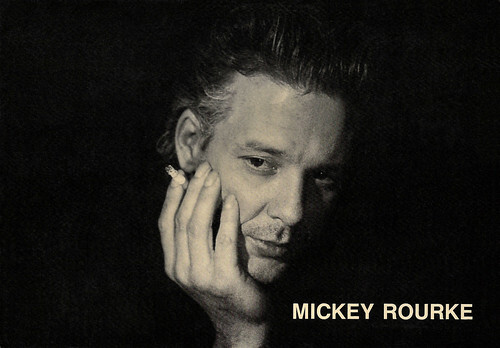
Italian postcard by World Pictures, no. P.c. 182.
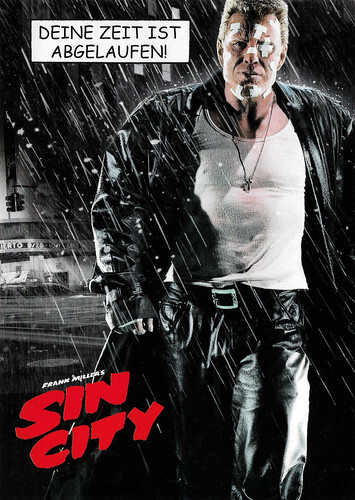
German postcard by Edgar Medien, no. 7.592. Image: Miramax. Photo: Rico Torres. Mickey Rourke in Sin City (Frank Miller, Quentin Tarantino (special guest director), Robert Rodriguez, 2005).
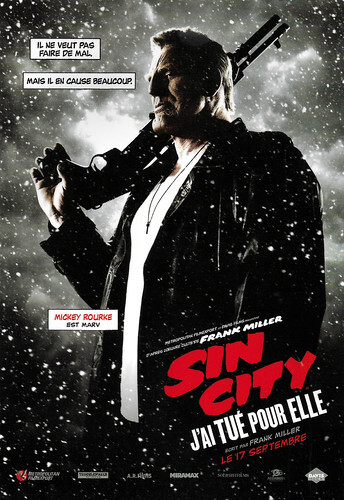
French postcard by Metropolitan. Image: Miramax. Artwork: The Weinstein Company. Mickey Rourke in Sin City - A Dame to Kill For (Frank Miller, Robert Rodriguez, 2014). Captions: He means no harm. But he does cause a lot of harm. Mickey Rourke is Marv.
Sources: Bruce Lawton (AllMovie), (IMDb), Wikipedia (Dutch, French, and English), and .

French postcard by Humour a la Carte, Paris, no. ST-186. Photo: TriStar Pictures. Mickey Rourke in Angel Heart (Alan Parker, 1987).

British postcard by Palm Pictures, no. C 7. Mickey Rourke on the set of The Pope of Greenwich Village (Stuart Rosenberg, 1984).

French postcard by Editions F. Nugeron, Paris, no. 2. Photo: Collection de l'École de Cinéma CAMIRIS. Kim Basinger and Mickey Rourke in Nine ½ Weeks (Adrian Lyne, 1986).

French postcard by Editions La Malibran, Paris, in the Collection Cinema Couleur, no MC 32, 1989. Photo: Mickey Rourke in Angel Heart (Alan Parker, 1987).

Vintage postcard by World Postcards Inc., no X 177, 1989. Photo: Mickey Rourke in Homeboy (Michael Seresin, 1988).
A shy and reserved student, but very comfortable with improvisation
Philip Andre 'Mickey' Rourke Jr. was born in Schenectady, New York, in 1952, He was the son of Ann (Cameron) and Philip Andre Rourke, a bodybuilder. He has a brother, Joey, and an older sister, Patricia. The nickname Mickey was given to him as a child by his parents, who thought he looked like a mouse.
When he was six, his parents divorced. A year later, his mother married Eugene Addis, a Miami Beach police officer, and mother and son moved to Miami Shores, Florida. There, he went to the Miami Beach Senior High School. Rourke joined a self-defense course at the Boys Club of Miami. Here he learned to box and began a career as an amateur boxer. At that time, he was more interested in baseball and boxing than in acting.
At the age of 12, he won his first match in the 51-54 kg category. He then called himself Andre Rourke. Later, he moved to a gym on 5th Street in Miami and joined the Police Athletic League. In 1969, he briefly became a sparring partner of Luis Rodriguez, who at that time was the world light heavyweight champion. In 1971, he suffered a concussion during a boxing match, so doctors ordered him to stop boxing for a year.
After working for a short time as a busboy at the famed Forge Restaurant on Miami Beach, Rourke moved back to New York to seek out a career in acting. He attended acting classes at the Lee Strasberg Theatre Institute. Rourke says of himself that he was a shy and reserved student, but very comfortable with improvisation. His teacher Sandra Seacat convinced him to move to Los Angeles.
After a few small roles on television, Rourke made his film debut in the small role of Private Reese in Steven Spielberg's war comedy 1941 (1979). A year later, he appeared in Heaven's Gate (Michael Cimino, 1980), one of the biggest commercial failures in film history that meant the end of United Artists. A year later, he appeared alongside Kathleen Turner and William Hurt as a pyro expert in the thriller Body Heat (Lawrence Kasdan, 1982). This is generally regarded as his breakthrough.

British postcard by Minerva, Holmes McDougall LTD, Edinburgh, no. PC268.

British postcard by Classics Postcards London, no. 59. Matt Dillon and Mickey Rourke in Rumble Fish (Francis Coppola, 1983).

American postcard by Zoetroope Images LTD., Boston, Mass, no. 398. Matt Dillon , Vincent Spano, and Mickey Rourke in Rumble Fish (Francis Coppola, 1983).

French postcard by Ebullitions, no. 544.

French postcard by Amorimage Productions (distribution by Humour a la Carte), no. ST-183. Photos: Frédérique Veysset.
The sensitive and protective older brother of Matt Dillon
In the 1980s, Mickey Rourke began to claim the lead role a little more often. He was one of Steve Guttenberg and Kevin Bacon's young pals in Barry Levinson's Diner (1982). He appeared as the sensitive and protective older brother of Matt Dillon in Francis Ford Coppola's Rumble Fish (1983).
Rourke had his first lead role in The Pope of Greenwich Village (Stuart Rosenberg, 1984), co-starring with Eric Roberts.
He reunited with Michael Cimino for the violent police film Year of the Dragon (1985), based on a scenario by Oliver Stone. Rourke gave a bravura performance as police captain Stanley White, fanatically determined to eliminate John Lone, the crime boss of New York's Chinatown. The film was hotly contested in the United States, however, with critics denouncing the negative portrayal of Chinese people and the overtly racist nature of its central character.
He gained the status of sex symbol with the erotic drama 9½ Weeks (Adrian Lyne, 1986), which became one of Rourke's best-known films. He plays John, a man who starts an affair with Elizabeth ( Kim Basinger ).
A year later, he played the lead in Angel Heart (Alan Parker, 1987), opposite Robert De Niro . The film was once again controversial in the United States, initially rated X (No one under 17 admitted) because of the sex scene between Rourke and the young Lisa Bonet, fresh off The Cosby Show. The sequence was eventually censored in the cinema and Rated R (Restricted – Under 17 requires accompanying parent or adult guardian).
For his next film, Barfly (Barbet Schroeder, 1987), the actor received rave reviews for his role as the alcoholic writer Henry Chinaski, based on Charles Bukowski. These rebellious anti-hero characters were especially well-liked in Europe and especially France where Rourke was a popular film idol.

French postcard by Humour a la Carte, Paris, no ST-198. Photo: Marianne Rosenstiehl. Mickey Rourke in Year of the Dragon (Michael Cimino, 1985).

Vintage postcard, no. X 142. Photo: Kim Basinger and Mickey Rourke in Nine ½ Weeks (Adrian Lyne, 1986).

British postcard, no. FA 222. Photo: Mickey Rourke in Angel Heart (Alan Parker, 1987).

British postcard by Moviedrome, no. M1. Mickey Rourke in Angel Heart (Alan Parker, 1987).

French postcard by Editions Damilla, Paris, no 94967. Photo: Mickey Rourke in Angel Heart (Alan Parker, 1987).
A near brain-dead prizefighter
Mickey Rourke wrote, produced, and starred in Homeboy (Michael Seresin, 1988), a film about a near brain-dead prizefighter. It skipped theatrical release and went straight to home video.
Rourke joined Walter Hill's Johnny Handsome (1989), then appeared in Wild Orchid (Zalman King, 1989). Divorced from his first wife Debra Feuer in 1989, he met actress-model Carré Otis on the set, who became his wife in 1992. The film was mocked by critics for its overall weakness and its sex scenes considered too explicit, some of which were cut to avoid the film being classified as pornographic.
Rourke played another anti-hero in Desperate Hours (Michael Cimino, 1990) but was nominated for a Razzie Award for Worst Actor of the Year for his performances in Wild Orchid and Desperate Hours. He worked with David Bowie on his album 'Never Let Me Down'', but his film career had taken a turn downhill. Another setback was Harley Davidson and the Marlboro Man (Simon Wincer, 1991), with Don Johnson. Rourke later admitted that he only made the film for the money.
Mickey decided to take up boxing again. He felt that he was self-destructive and had no respect for the actor Rourke. His boxing career did not go smoothly. Under the supervision of his coach, Chuck Zito of the Hells Angels, he was often injured. In retrospect, he would admit that he was too old to return to boxing, but that he had done so anyway for personal reasons.
In 1995, he continued to work on his film career but he had to make do with supporting roles. In 1997, Mickey Rourke appeared on screen with his face surgically altered, his features enlarged and his body thickened in Double Team (Tsui Hark', 1997) opposite Jean-Claude Van Damme . Rourke also reprised his role as an s&m fetishist in Another 9 1/2 Weeks (Anne Goursaud, 1997), a virtual remake of the original, only sans the redeeming presence of Kim Basinger .
He had a small part in Francis Ford Coppola's adaptation of John Grisham's The Rainmaker (1997). There were also quite a few roles that barely came to light. In the critically-worshipped The Thin Red Line (Terrence Malick, 1997), his role was edited out. Unemployed and broke, he had to sell his motorbike collection and his Los Angeles mansion to pay off his creditors and was temporarily committed when his friends became concerned about his suicidal tendencies.
In 1999, he played an important role in the Flemish film Shades (Erik Van Looy, 1999). He also appeared as a transvestite prisoner in Steve Buscemi's Animal Factory (2000), and opposite Sylvester Stallone in Get Carter (Stephen T. Kay, 2000). The latter film, above all, enabled him to straighten out his financial situation, thanks to Stallone.

British postcard by Personality Posters LTD., no PP45.

British postcard, no. FA 223. Mickey Rourke in Angel Heart (Alan Parker, 1987).

French postcard in the Collection Cinéma Couleur by Editions La Malibran, Paris, no. MC 29, 1989. Photo: Mickey Rourke and Faye Dunaway in Barfly (Barbet Schroeder, 1987).

French postcard by Sonis, no. C. 109. Photo: Deal. Mickey Rourke and Carré Otis in Wild Orchid (Zalman King, 1989).

French postcard by Sonis, no. C. 110. Photo: Deal. Mickey Rourke in Wild Orchid (Zalman King, 1989).
An imposing beast of a fellow
Mickey Rourke gave an impressive supporting performance in Sean Penn 's police procedural-cum-harrowing study of obsession, The Pledge (2001) opposite Jack Nicholson .
After Rourke played a role in the music video for the song 'Hero' by Enrique Iglesias , he appeared in Roberto Rodriguez's hit Once Upon a Time in Mexico (2003). As a harbinger of things to come, a powerful creative bond formed between the weathered, iconic Rourke and the tireless director on the Mexico set.
In 2005 they again teamed for Rodriguez's and Frank Miller's eagerly anticipated big-screen adaptation of Miller's Sin City comics. Bruce Lawton writes at AllMovie : "Cast as lovelorn brute Marv, Rourke delivered an impressive performance as an imposing beast of a fellow bent on avenging the death of an angelic prostitute in this stylish noir comic book come to life, which gave him cult status among a new generation of fans.
In 2004, Rourke delivered a memorable supporting performance in Tony Scott's Man on Fire (2004) alongside Denzel Washington. It marked the first film in a two-picture creative partnership between Scott and Rourke, the second half of which came to fruition with Domino (2005) starring Keira Knightley .
In 2008, he collaborated with Darren Aronofsky on the film The Wrestler. Rourke was widely praised for his role as Randy "The Ram" Robinson, a wrestler who is way past his prime. Besides the typical elements of a sports drama, the film also contains some striking similarities with Rourke's own career as a boxer and actor. Mickey Rourke won a Golden Globe in 2009 for this role.
Rourke would enjoy sustained success in the years to follow, appearing in films like The Expendables (Sylvester Stallone, 2010), and Iron Man 2 (Jon Favreau, 2010) with Robert Downey Jr. and Scarlett Johansson. The latter brought in more than $312 million in the United States. His later films include Immortals (Tarsem Singh, 2011), the thriller The Courier (Hany Abu-Assad, 2012), and the Western Dead in Tombstone (Roel Reiné, 2013).

British postcard by Heroes, London, no. SPC2228.

French postcard by Editions SPK, Ref. 265.

Italian postcard by World Pictures, no. P.c. 182.

German postcard by Edgar Medien, no. 7.592. Image: Miramax. Photo: Rico Torres. Mickey Rourke in Sin City (Frank Miller, Quentin Tarantino (special guest director), Robert Rodriguez, 2005).

French postcard by Metropolitan. Image: Miramax. Artwork: The Weinstein Company. Mickey Rourke in Sin City - A Dame to Kill For (Frank Miller, Robert Rodriguez, 2014). Captions: He means no harm. But he does cause a lot of harm. Mickey Rourke is Marv.
Sources: Bruce Lawton (AllMovie), (IMDb), Wikipedia (Dutch, French, and English), and .
Published on January 27, 2022 22:00
January 26, 2022
Francis Ford
Francis Ford (1881-1953) was an American actor and director of the silent era. Ford was the male lead in such silent films as the Universal serial The Broken Coin (Francis Ford, 1915), co-scripted by Grace Cunard, the female lead of the serial. Francis was the elder brother and mentor of director John Ford. He also appeared in many of the latter's films, including Young Mr. Lincoln (1939) and The Quiet Man (1952). Ford may have acted in over 400 films, with many of his early credits poorly documented and probably lost.
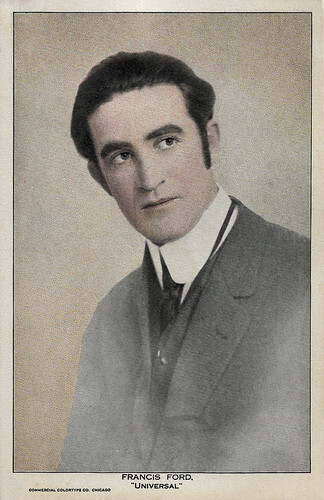
American postcard by Commercial Colortype Co., Chicago, no. M-34. Photo: Universal.
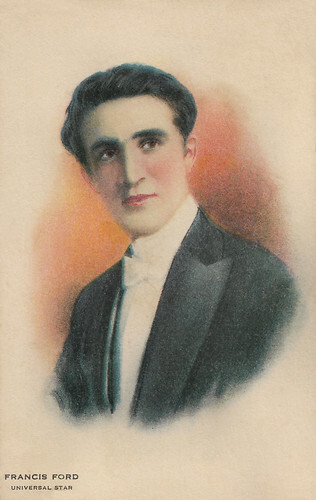
American postcard by Kline Poster Co. Inc., Phila. Image: Universal.
Specialised in Abraham Lincoln
Francis Ford was born Frank Thomas Feeney in 1881 in Portland, Maine, USA. He was the son of John Augustine Feeney and Barbara "Abbey" Curran. By 1878, John had moved to Portland, Maine, and opened a saloon, at 42 Center Street, that used a false front to pose as a grocery store. John opened four others in the following years.
Francis left home. He joined the army in 1898 to fight in the Spanish-American War but was discharged when the authorities discovered he was only seventeen years old. After a brief marriage to Dell Cole from whom he had a son, Philip Ford (1900-1976), Francis lived off odd jobs, worked in a circus, and then became a stage actor where he met his second wife, the actress Elsie Van Name.
In 1909, he drifted into the film business in New York City, working for David Horsley, Al Christie, and the Star Film Company's San Antonio operation under Gaston Méliès. He made his film debut in small roles and was often in charge of props, costumes, and set design. He adopted the name Ford from the automobile.
From San Antonio, Francis began his Hollywood career in 1910 working for Thomas H. Ince at Ince's Bison studio, directing and appearing in Westerns. Francis's transition from the Ford family home in Maine to having a career in Hollywood as an actor and director motivated his little brother John Ford to do the same, largely as an act of competition.
Separated from his wife Elsie, Francis Ford moved to Universal in early 1913. His 1913 Lucille Love, Girl of Mystery was Universal's first serial, and the first of a string of very popular serials starring Ford's collaborator and lover Grace Cunard. Their serial The Broken Coin (Francis Ford, 1915) was expanded from 15 to 22 episodes by popular demand, It was probably the highlight of Ford's career.
He played the role of President Lincoln on several occasions, notably in On Secret Service (Thomas H. Ince, 1912|), The Great Sacrifice (Raymond B. West, 1913), From Rail-Splitter to President (Francis Ford, 1913), and The Toll of War (Francis Ford, 1913). He also planned to make a twelve-part film on the life of Abraham Lincoln, but this project did not materialise. Francis also played General George A. Custer in Custer's Last Fight (Francis Ford, 1912).
In 1914, when Francis was the head of the Universal Film Manufacturing Co.'s shorts and serials department, he assigned his twelve years younger brother John Ford, who was working odd jobs around the studio, to Harry Carey's unit. In 1914, Francis played Sherlock Holmes in A Study in Scarlet (Francis Ford, 1914) with John as Dr. Watson.
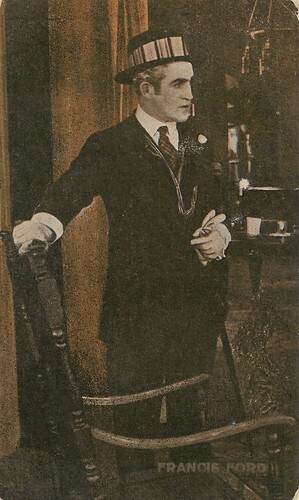
Spanish cromo (collector's card) by Amatller Marca Luna, series 1a, no. 31. Photo: Universal. Francis Ford as Count Hugo in the serial The Broken Coin (Francis Ford 1915), released in Spain as 'La Moneda Rota'.
[image error]
Spanish postcard. Photo: Universal. Francis Ford, Grace Cunard, and Eddie Polo in The Broken Coin (Francis Ford, 1915), co-scripted by Cunard. The serial is presumably lost.
An ample feel for light comedy
In 1917, Francis Ford left Universal and separated from Grace Cunard. He founded a short-lived independent company, Ford Films, which released Berlin Via America (Francis Ford, 1918), and briefly opened his own studio at Sunset Boulevard and Gower Street.
Francis mentored John, collaborating frequently as writers, directors, and actors in each other's projects, but it soon became clear that his younger brother's star was on the rise.
Frank's directorial style remained suitable for serials but failed to evolve. Ford's final known directorial credit is for The Call of the Heart (Francis Ford, 1928), a 50-minute vehicle for 'Dynamite the Devil Dog'.
Francis Ford turned to acting exclusively circa 1929. He is often uncredited, as in his appearance in James Whale's Frankenstein (1931). As an actor, he would provide convincing portrayals of men of authority - men sometimes ruthless if not downright unsavory. He played the Republican judge in his brother John's The Informer (John Ford, 1935).
But he also had an ample feel for light comedy. Thus he played in John's The Quiet Man (John Ford, 1952), as the village elder who - almost in the manner of slapstick - rouses himself from his very deathbed to witness the film's donnybrook dénouement.
Francis Ford passed away from cancer in 1953 in Los Angeles at the age of 72. He was married three times, to Delia Agatha Cole (1900-1909), Elsie Van Name (1909-1934), and Mary Elizabeth Swearingen (1935-1953). His sons were film actor/director Philip Ford and Francis Joseph Ford Jr. a.k.a. "Bill".
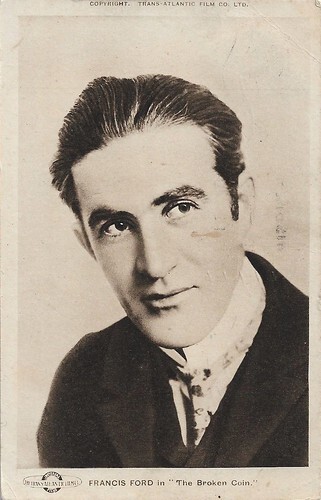
British postcard. Photo: The Trans-Atlantic Film Co. (British subsidiary of Universal in Europe). Francis Ford as the male lead in The Broken Coin (Francis Ford, 1915), co-scripted by Grace Cunard, the female lead of the serial.
Sources: (IMDb), Wikipedia, and .

American postcard by Commercial Colortype Co., Chicago, no. M-34. Photo: Universal.

American postcard by Kline Poster Co. Inc., Phila. Image: Universal.
Specialised in Abraham Lincoln
Francis Ford was born Frank Thomas Feeney in 1881 in Portland, Maine, USA. He was the son of John Augustine Feeney and Barbara "Abbey" Curran. By 1878, John had moved to Portland, Maine, and opened a saloon, at 42 Center Street, that used a false front to pose as a grocery store. John opened four others in the following years.
Francis left home. He joined the army in 1898 to fight in the Spanish-American War but was discharged when the authorities discovered he was only seventeen years old. After a brief marriage to Dell Cole from whom he had a son, Philip Ford (1900-1976), Francis lived off odd jobs, worked in a circus, and then became a stage actor where he met his second wife, the actress Elsie Van Name.
In 1909, he drifted into the film business in New York City, working for David Horsley, Al Christie, and the Star Film Company's San Antonio operation under Gaston Méliès. He made his film debut in small roles and was often in charge of props, costumes, and set design. He adopted the name Ford from the automobile.
From San Antonio, Francis began his Hollywood career in 1910 working for Thomas H. Ince at Ince's Bison studio, directing and appearing in Westerns. Francis's transition from the Ford family home in Maine to having a career in Hollywood as an actor and director motivated his little brother John Ford to do the same, largely as an act of competition.
Separated from his wife Elsie, Francis Ford moved to Universal in early 1913. His 1913 Lucille Love, Girl of Mystery was Universal's first serial, and the first of a string of very popular serials starring Ford's collaborator and lover Grace Cunard. Their serial The Broken Coin (Francis Ford, 1915) was expanded from 15 to 22 episodes by popular demand, It was probably the highlight of Ford's career.
He played the role of President Lincoln on several occasions, notably in On Secret Service (Thomas H. Ince, 1912|), The Great Sacrifice (Raymond B. West, 1913), From Rail-Splitter to President (Francis Ford, 1913), and The Toll of War (Francis Ford, 1913). He also planned to make a twelve-part film on the life of Abraham Lincoln, but this project did not materialise. Francis also played General George A. Custer in Custer's Last Fight (Francis Ford, 1912).
In 1914, when Francis was the head of the Universal Film Manufacturing Co.'s shorts and serials department, he assigned his twelve years younger brother John Ford, who was working odd jobs around the studio, to Harry Carey's unit. In 1914, Francis played Sherlock Holmes in A Study in Scarlet (Francis Ford, 1914) with John as Dr. Watson.

Spanish cromo (collector's card) by Amatller Marca Luna, series 1a, no. 31. Photo: Universal. Francis Ford as Count Hugo in the serial The Broken Coin (Francis Ford 1915), released in Spain as 'La Moneda Rota'.
[image error]
Spanish postcard. Photo: Universal. Francis Ford, Grace Cunard, and Eddie Polo in The Broken Coin (Francis Ford, 1915), co-scripted by Cunard. The serial is presumably lost.
An ample feel for light comedy
In 1917, Francis Ford left Universal and separated from Grace Cunard. He founded a short-lived independent company, Ford Films, which released Berlin Via America (Francis Ford, 1918), and briefly opened his own studio at Sunset Boulevard and Gower Street.
Francis mentored John, collaborating frequently as writers, directors, and actors in each other's projects, but it soon became clear that his younger brother's star was on the rise.
Frank's directorial style remained suitable for serials but failed to evolve. Ford's final known directorial credit is for The Call of the Heart (Francis Ford, 1928), a 50-minute vehicle for 'Dynamite the Devil Dog'.
Francis Ford turned to acting exclusively circa 1929. He is often uncredited, as in his appearance in James Whale's Frankenstein (1931). As an actor, he would provide convincing portrayals of men of authority - men sometimes ruthless if not downright unsavory. He played the Republican judge in his brother John's The Informer (John Ford, 1935).
But he also had an ample feel for light comedy. Thus he played in John's The Quiet Man (John Ford, 1952), as the village elder who - almost in the manner of slapstick - rouses himself from his very deathbed to witness the film's donnybrook dénouement.
Francis Ford passed away from cancer in 1953 in Los Angeles at the age of 72. He was married three times, to Delia Agatha Cole (1900-1909), Elsie Van Name (1909-1934), and Mary Elizabeth Swearingen (1935-1953). His sons were film actor/director Philip Ford and Francis Joseph Ford Jr. a.k.a. "Bill".

British postcard. Photo: The Trans-Atlantic Film Co. (British subsidiary of Universal in Europe). Francis Ford as the male lead in The Broken Coin (Francis Ford, 1915), co-scripted by Grace Cunard, the female lead of the serial.
Sources: (IMDb), Wikipedia, and .
Published on January 26, 2022 22:00
January 25, 2022
Etchika Choureau (1929-2022)
French actress Etchika Choureau (1929) died on 25 January 2022, at the age of 92. Choureau's film career started very promisingly with three films and an award in 1953. During the 1950s, the beauty with the green eyes and long blond hair graced films in France, Germany, Italy, and Hollywood. After a long affair with the Crown prince of Morocco, she tried to make a come-back but failed and retired.
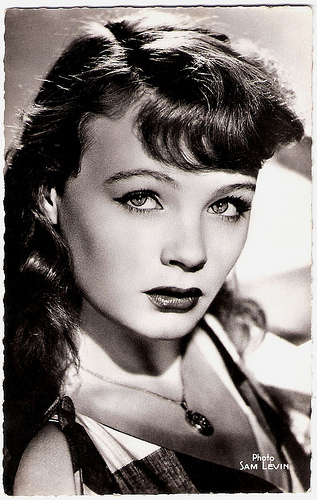
French postcard by Editions du Globe (E.D.U.G.), Paris, no. 322. Photo: Sam Lévin.
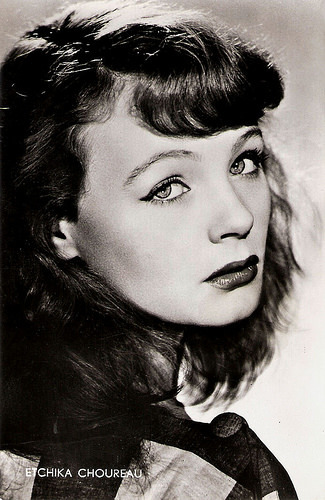
French postcard by Kores, 'Carboplane'. Photo: Unifrance film.
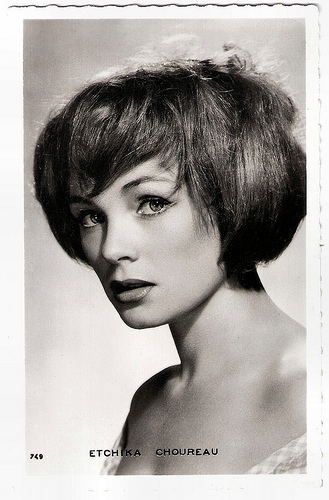
French postcard by Editions P.I., Paris, no. 749. Photo: Sam Lévin.
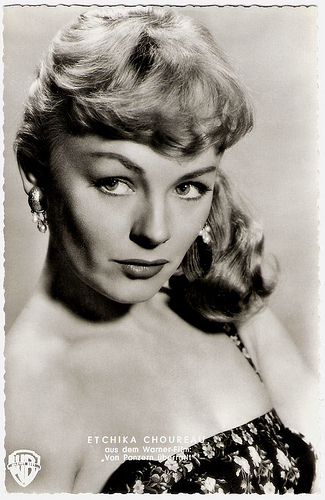
German postcard by Film und Bild, Berlin-Charlottenburg, no. A 1541. Photo: Warner Bros. Publicity still for Darby's Rangers (William A. Wellman, 1958).
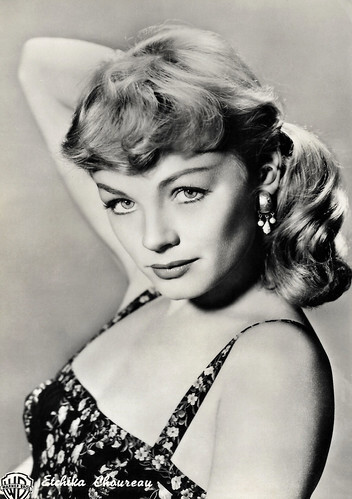
Italian postcard by Bromofoto, Milano, no. 1410. Photo: Warner Bros.
Antonioni
Etchika Choureau was born Jeannine Paulette Verret in Paris in 1929 (some sources says 1923, others 1933).
In 1948 the beautiful 19-year-old girl met Max Choureau, four years her senior whose parents were beekeepers in the Gâtinais. They fell in love and were married.
After various jobs, she enrolled in the Paris Conservatory of Arts to study drama. At her graduation, she won the first prize in a contest with film diva Edwige Feuillère heading the jury.
Actor Alain Cuny discovered her and pushed her to accept a beautiful role in the Italian film I vinti/The Vanquished (1953), an early work of legendary director Michelangelo Antonioni. This anthology film contains three stories of well-off youths in the post-war years who commit murders, one taking place in Paris, another in Rome, and another in London.
In the French episode Sans Amour (Without Love), Choureay plays a young temptress in a gang of aimless youth from working-class families. They cold-bloodedly plan and carry out the murder of a boastful bourgeois classmate (Jean-Pierre Mocky), just out of envy. Antonioni had huge problems when he tried to find funding for such ambitious, resolutely downbeat material. The result was banned in France for a long time.
In 1953 Choureau also divorced but kept the name of her ex-husband as a pseudonym. That same year she starred in two more remarkable films. She played a mortally ill village girl in L'envers du paradis/The Other Side of Paradise (Edmond T. Gréville, 1953) starring Erich von Stroheim .
The third film was Les enfants de l'amour/Children of Love (Léonide Moguy, 1953), a drama about unwed mothers in which she played a double role. It earned her that year le Prix Suzanne-Bianchetti (the Suzanne Bianchetti award) for the Most Promising Actress.
After this jump-start, she made nine more films in France, Italy, and Germany during the following years. Although she co-starred in these films with stars like Jean Marais , Michel Simon , and Isa Miranda , none of these productions was memorable.
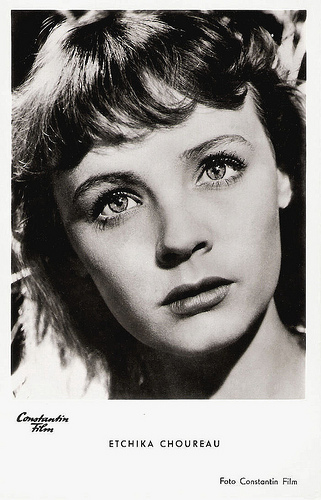
German postcard by Kunst und Bild, Berlin, no. A 1075. Photo: Constantin Film. Publicity still for Les enfants de l'amour/Children of Love (Léonide Moguy, 1953).
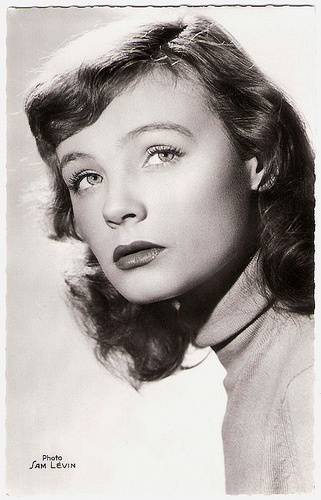
French postcard by Editions du Globe, Paris, no. 439. Photo: Sam Lévin.
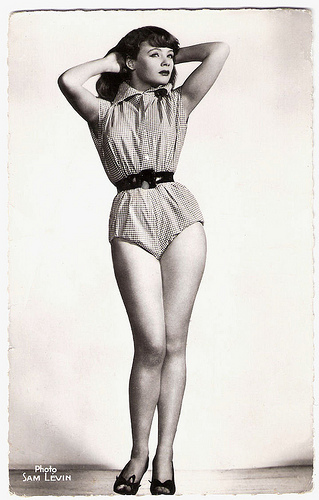
French postcard by Editions du Globe (E.D.U.G.), Paris, no. 358. Photo: Sam Lévin.
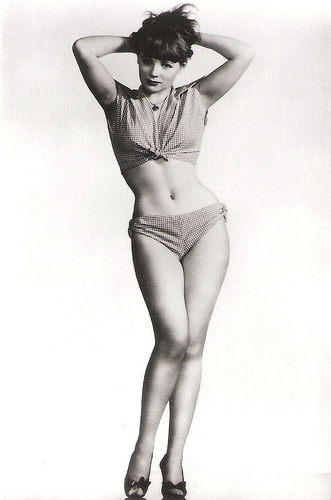
Yugoslavian postcard by Studio Sombor, no. 212.
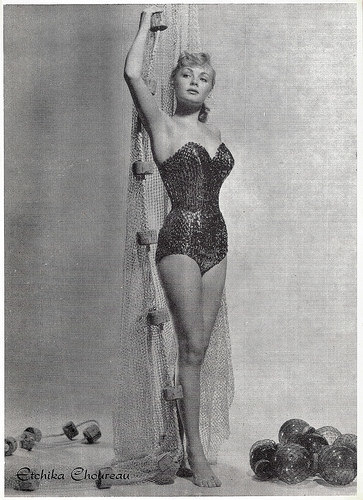 .
.
Big vintage card.
Crown Prince
In 1957 Etchika Choureau tried to conquer Hollywood. She played the female leads in two American war films made by Warner Bros.
In Darby's Rangers (William A. Wellman, 1958) she was the love interest of James Garner, and in Lafayette Escadrille (William A. Wellman, 1958) of Tab Hunter . According to the fan magazines, Hunter was deeply in love with her, but his studio wouldn’t allow him to fly to Paris to visit her...
She had a real love affair with Moulay Hassan II, the Crown Prince of Morocco. She retired from the screen. In 1961 their relationship suddenly ended when Hassan was proclaimed King of Morocco following the death of His Majesty Mohammed V.
After an absence of four years, Choureau tried to revive her cinema career with three new roles. First, she played the lead in the drama La prostitution/Prostitution (Maurice Boutel, 1963).
The following year she had a small part in the romantic adventure film Angélique, marquise des anges/Angélique (Bernard Borderie, 1964), the first part of the romantic Angélique cycle, set in Mid-17th century France. This huge box office hit meant the breakthrough for lead actress Michèle Mercier but did nothing for the career of Choureau.
She played in only one more film, Paris au mois d'août/Paris in August (Pierre Granier-Deferre, 1966) as the wife of Charles Aznavour . Then she retired permanently.
Three years later, she married auctioneer Philippe Rheims. Etchika Choureau had appeared in only seventeen films.
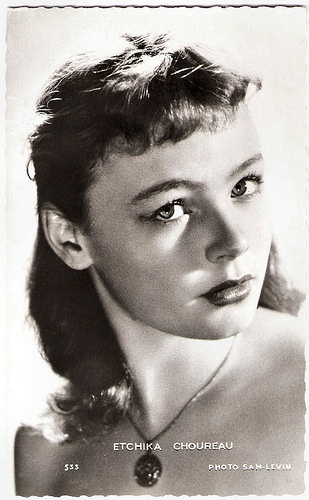
French postcard by Editions P.I., Paris, no 533. Photo: Sam Lévin.
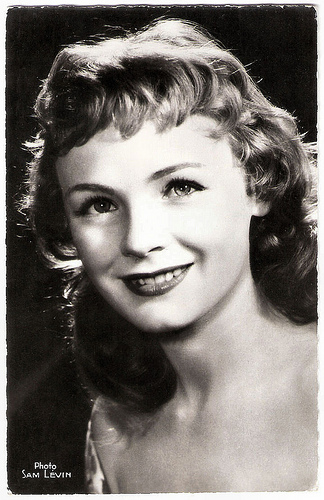
French postcard by Editions du Globe (E.D.U.G.), Paris, no. 323. Photo: Sam Lévin.
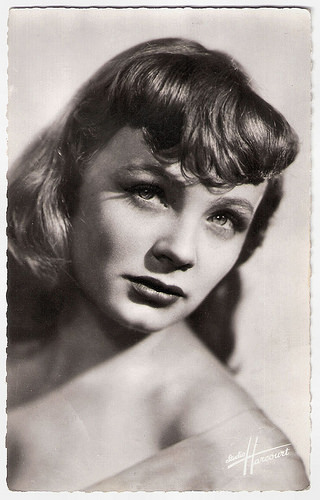
French postcard by Editions du Globe, Paris, no. 343. Photo: Studio Harcourt.
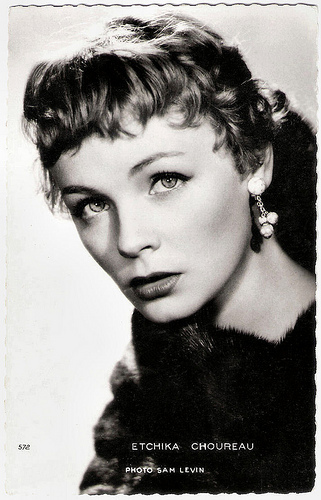
French postcard by Editions P.I., Paris, no. 572. Photo: Sam Lévin.
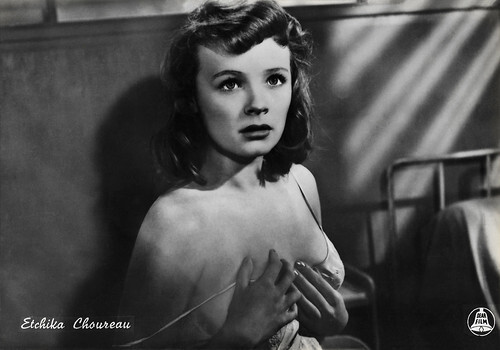
Italian postcard by Bromofoto, Milano, no. 947. Photo: Dear Film. Etchika Choureau in Les Enfants de l'amour/Children of Love (Léonide Moguy, 1953).
Sources: Yves Foucart (Les gens du Cinema), Michael Hastings (AllMovie), Glamour Girls of the Silver Screen, Wikipedia (French), and .

French postcard by Editions du Globe (E.D.U.G.), Paris, no. 322. Photo: Sam Lévin.

French postcard by Kores, 'Carboplane'. Photo: Unifrance film.

French postcard by Editions P.I., Paris, no. 749. Photo: Sam Lévin.

German postcard by Film und Bild, Berlin-Charlottenburg, no. A 1541. Photo: Warner Bros. Publicity still for Darby's Rangers (William A. Wellman, 1958).

Italian postcard by Bromofoto, Milano, no. 1410. Photo: Warner Bros.
Antonioni
Etchika Choureau was born Jeannine Paulette Verret in Paris in 1929 (some sources says 1923, others 1933).
In 1948 the beautiful 19-year-old girl met Max Choureau, four years her senior whose parents were beekeepers in the Gâtinais. They fell in love and were married.
After various jobs, she enrolled in the Paris Conservatory of Arts to study drama. At her graduation, she won the first prize in a contest with film diva Edwige Feuillère heading the jury.
Actor Alain Cuny discovered her and pushed her to accept a beautiful role in the Italian film I vinti/The Vanquished (1953), an early work of legendary director Michelangelo Antonioni. This anthology film contains three stories of well-off youths in the post-war years who commit murders, one taking place in Paris, another in Rome, and another in London.
In the French episode Sans Amour (Without Love), Choureay plays a young temptress in a gang of aimless youth from working-class families. They cold-bloodedly plan and carry out the murder of a boastful bourgeois classmate (Jean-Pierre Mocky), just out of envy. Antonioni had huge problems when he tried to find funding for such ambitious, resolutely downbeat material. The result was banned in France for a long time.
In 1953 Choureau also divorced but kept the name of her ex-husband as a pseudonym. That same year she starred in two more remarkable films. She played a mortally ill village girl in L'envers du paradis/The Other Side of Paradise (Edmond T. Gréville, 1953) starring Erich von Stroheim .
The third film was Les enfants de l'amour/Children of Love (Léonide Moguy, 1953), a drama about unwed mothers in which she played a double role. It earned her that year le Prix Suzanne-Bianchetti (the Suzanne Bianchetti award) for the Most Promising Actress.
After this jump-start, she made nine more films in France, Italy, and Germany during the following years. Although she co-starred in these films with stars like Jean Marais , Michel Simon , and Isa Miranda , none of these productions was memorable.

German postcard by Kunst und Bild, Berlin, no. A 1075. Photo: Constantin Film. Publicity still for Les enfants de l'amour/Children of Love (Léonide Moguy, 1953).

French postcard by Editions du Globe, Paris, no. 439. Photo: Sam Lévin.

French postcard by Editions du Globe (E.D.U.G.), Paris, no. 358. Photo: Sam Lévin.

Yugoslavian postcard by Studio Sombor, no. 212.
 .
.Big vintage card.
Crown Prince
In 1957 Etchika Choureau tried to conquer Hollywood. She played the female leads in two American war films made by Warner Bros.
In Darby's Rangers (William A. Wellman, 1958) she was the love interest of James Garner, and in Lafayette Escadrille (William A. Wellman, 1958) of Tab Hunter . According to the fan magazines, Hunter was deeply in love with her, but his studio wouldn’t allow him to fly to Paris to visit her...
She had a real love affair with Moulay Hassan II, the Crown Prince of Morocco. She retired from the screen. In 1961 their relationship suddenly ended when Hassan was proclaimed King of Morocco following the death of His Majesty Mohammed V.
After an absence of four years, Choureau tried to revive her cinema career with three new roles. First, she played the lead in the drama La prostitution/Prostitution (Maurice Boutel, 1963).
The following year she had a small part in the romantic adventure film Angélique, marquise des anges/Angélique (Bernard Borderie, 1964), the first part of the romantic Angélique cycle, set in Mid-17th century France. This huge box office hit meant the breakthrough for lead actress Michèle Mercier but did nothing for the career of Choureau.
She played in only one more film, Paris au mois d'août/Paris in August (Pierre Granier-Deferre, 1966) as the wife of Charles Aznavour . Then she retired permanently.
Three years later, she married auctioneer Philippe Rheims. Etchika Choureau had appeared in only seventeen films.

French postcard by Editions P.I., Paris, no 533. Photo: Sam Lévin.

French postcard by Editions du Globe (E.D.U.G.), Paris, no. 323. Photo: Sam Lévin.

French postcard by Editions du Globe, Paris, no. 343. Photo: Studio Harcourt.

French postcard by Editions P.I., Paris, no. 572. Photo: Sam Lévin.

Italian postcard by Bromofoto, Milano, no. 947. Photo: Dear Film. Etchika Choureau in Les Enfants de l'amour/Children of Love (Léonide Moguy, 1953).
Sources: Yves Foucart (Les gens du Cinema), Michael Hastings (AllMovie), Glamour Girls of the Silver Screen, Wikipedia (French), and .
Published on January 25, 2022 22:00
January 24, 2022
32 times Ava!
Today, it's exactly 32 years ago that Ava Gardner (1922-1990) passed away. She was considered one of the most beautiful women of her day. In 1941, 19-years-old Ava signed a contract with MGM. After her screen test, the director had clapped his hands gleefully and yelled, "She can't talk! She can't act! She's sensational!" Ava appeared in small roles and on pin-up photos until she drew everybody's attention in The Killers (1946). She became one of Hollywood's most glamorous stars but was also nominated for the Oscar for Best Actress for Mogambo (1953). From then till the 1970s, she appeared in several high-profile films, both in Hollywood and Europe. On 25 January 1990 she died at the age of 67.
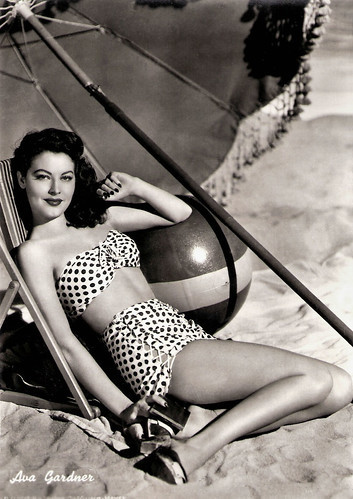
Italian postcard by Bromofoto, Milano, no. 224.
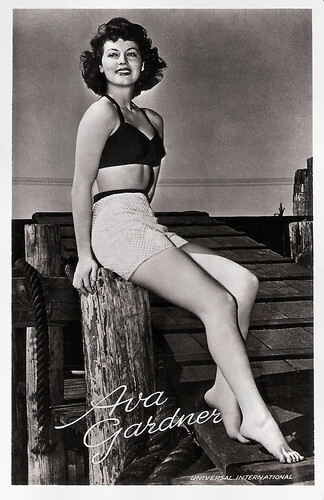
Dutch postcard, no. 3265. Photo: Universal International.
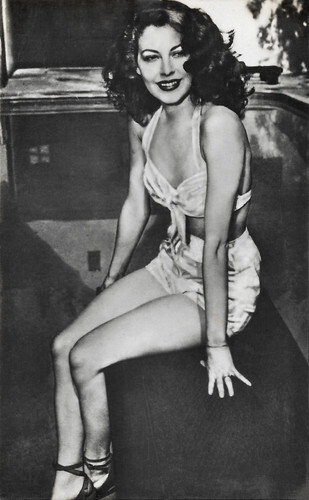
Spanish postcard, no. 261.
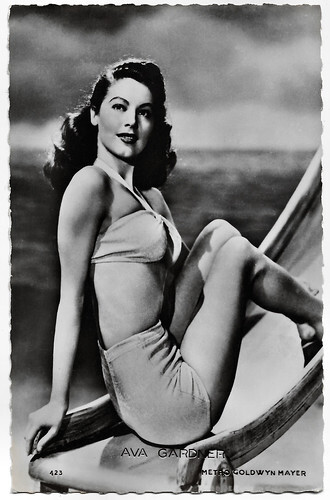
French postcard by Editions P.I., no. 13D. Photo: Metro-Goldwyn-Mayer, 1953.
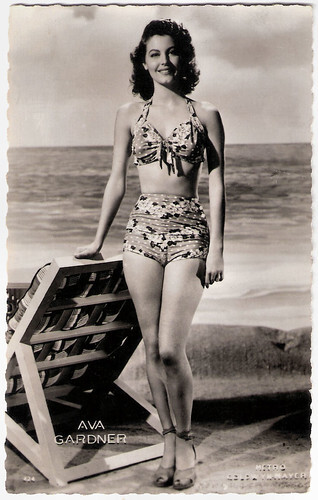
French postcard by Editions P.I., Paris, no. 424. Photo: Metro-Goldwyn-Mayer.
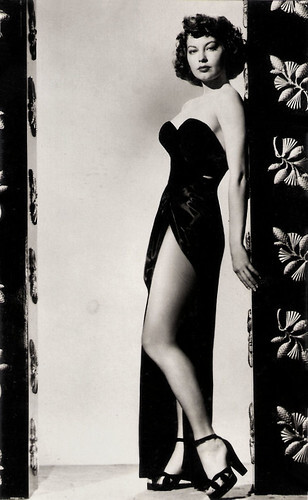
Spanish collectors card, no. 3868.
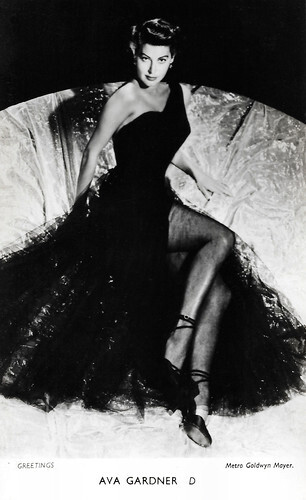
British Greetings card, no. D. Photo: Virgil Apger / Metro Goldwyn Mayer.
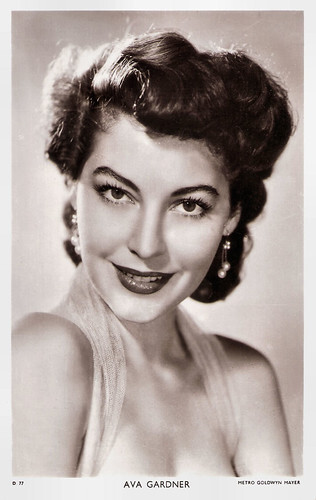
British postcard in the Picturegoer Series, London, no. D 77. Photo: Metro Goldwyn Mayer.
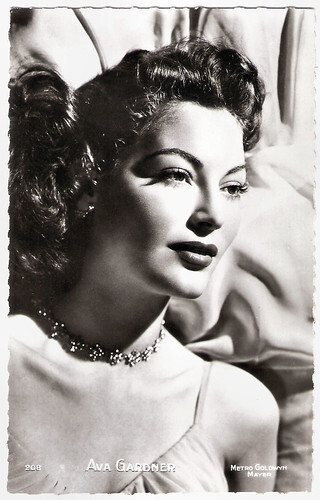
French postcard by Editions P.I., La Garenne-Colombes, no. 208, 1950. Photo: Metro-Goldwyn-Mayer.
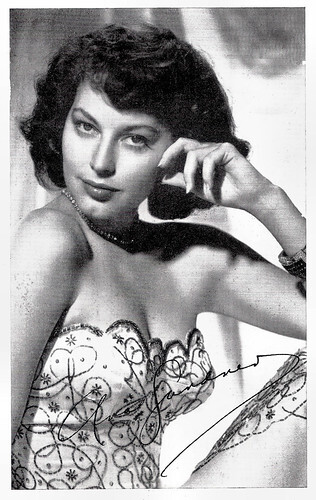
Vintage autograph card.
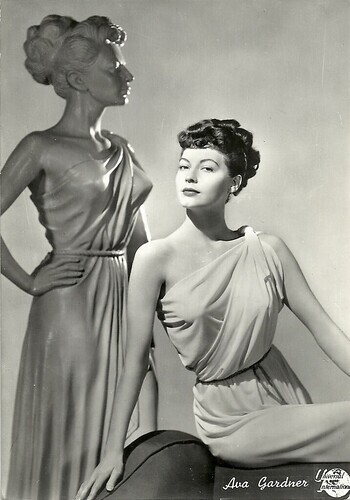
German postcard. Photo: Universal International Pictures. Ava Gardner in One Touch of Venus (William A. Seiter, 1948).
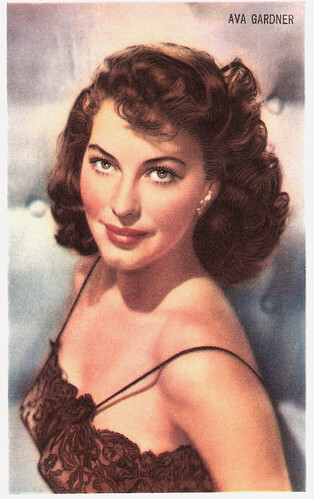
Belgian collectors card by Kwatta, Bois d'Haine, no. C 234. Photo: M.G.M. Publicity still for East Side, West Side (Mervyn LeRoy, 1949).
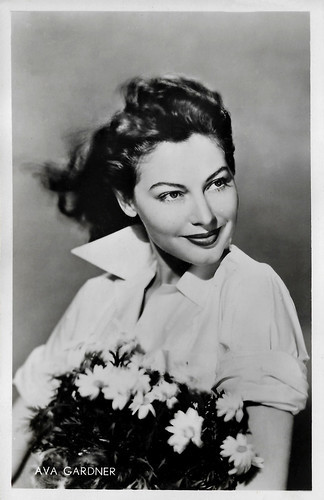
Dutch postcard.
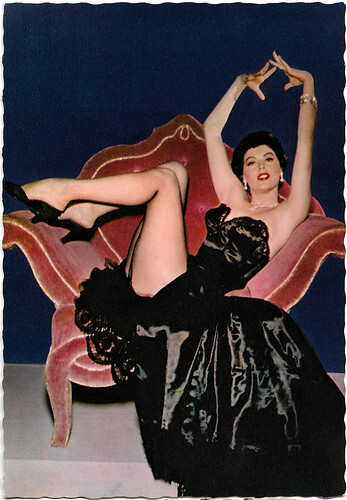
French postcard, no. 116. Photo: Virgil Apger.
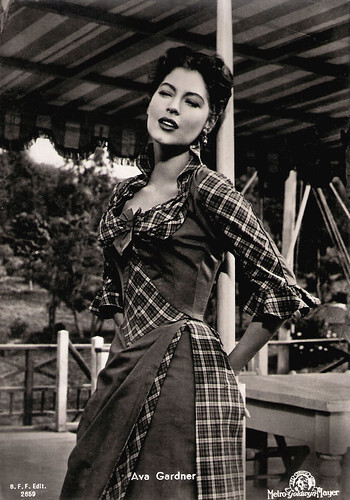
Italian postcard by B.F.F. (Casa Edit. Ballerini & Fratini), Milano, no. 2659. Photo: Metro-Goldwyn-Mayer. Publicity still for Show Boat (George Sidney, 1951).
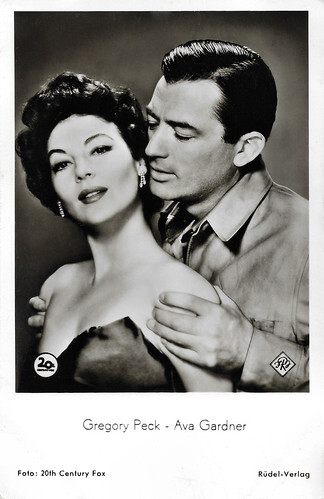
West-German postcard by R��del-Verlag, Hamburg-Bergedorf, no. 507. Photo: 20th Century Fox. Ava Gardner and Gregory Peck in The Snows of Kilimanjaro (Henry King, 1952).
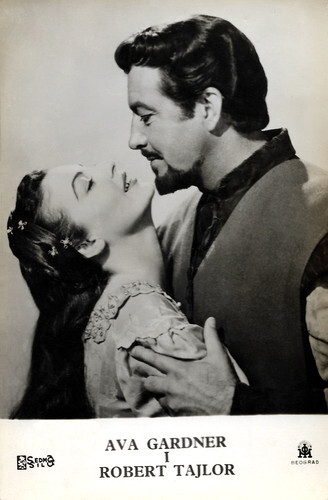
Yugoslavian postcard by Sedma Sila. Photo: IOM, Beograd. Robert Taylor and Ava Gardner in Knights of the Round Table (Richard Thorpe, 1953).
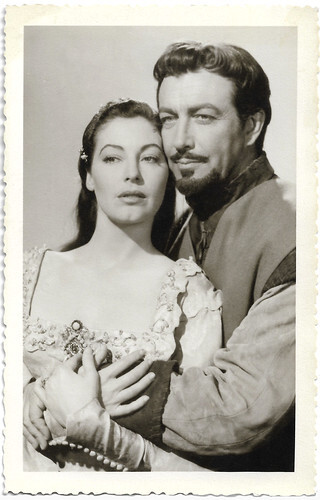
Spanish postcard by Celuloide Stars. Robert Taylor and Ava Gardner in Knights of the Round Table (Richard Thorpe, 1953).
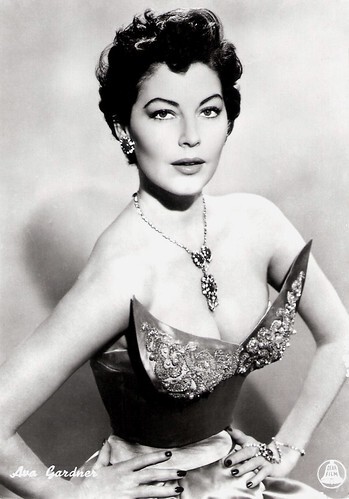
Italian postcard by Bromofoto, Milano, no. 881. Photo: Dear Film. Publicity still for The Barefoot Contessa (Joseph L. Mankiewicz, 1954).
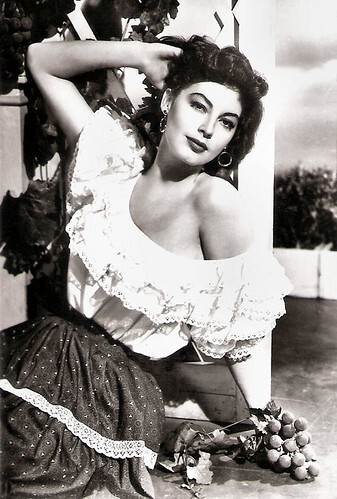
Vintage collectors card. Photo: MGM. Publicity still for The Barefoot Contessa (Joseph L. Mankiewicz, 1954).
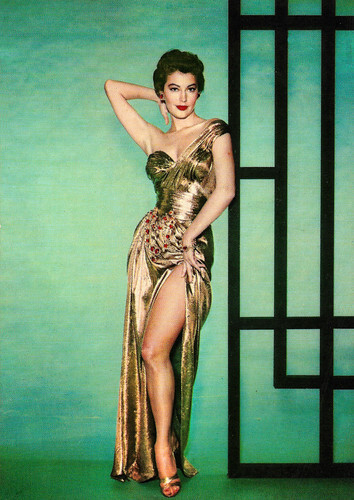
Italian postcard by Rotalcolor, Milano, no. 124.
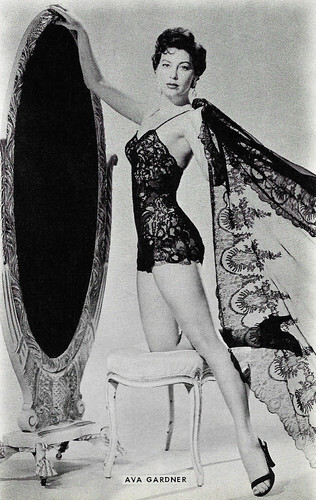
American postcard by Silvercraft, West Nyack (N.Y.). Photo: Metro-Goldwyn-Mayer. Publicity still for Bhowani Junction (George Cukor, 1956).
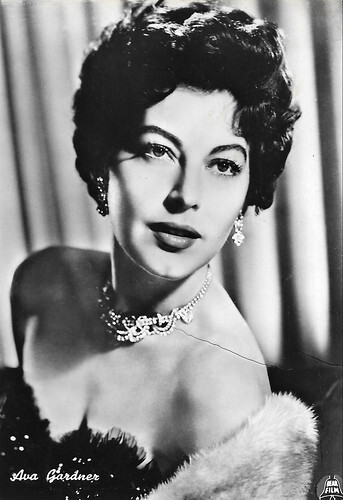
Italian postcard. Photo: DEAR Film.
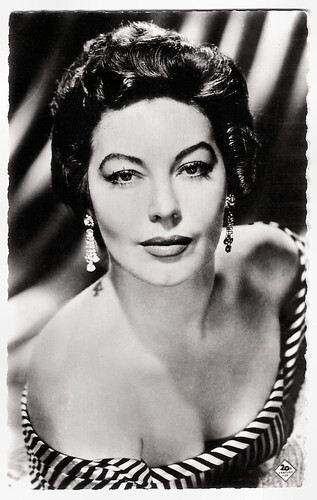
French postcard by Editions P.I., Paris, offered by Les Carbones Kor��s 'Carboplane, no. 885. Photo: 20th Century Fox.
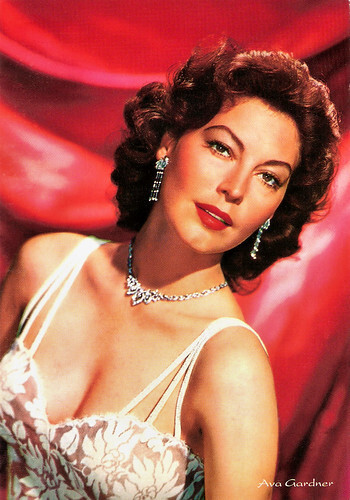
Italian postcard in the series Artisti di Sempre by Rotalfoto, Milano, no. 299.
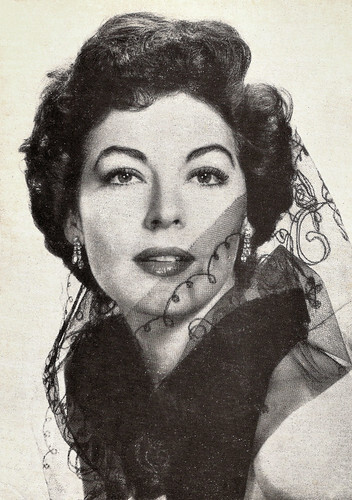
Small Spanish postcard by La Revista Florita, no. 6.
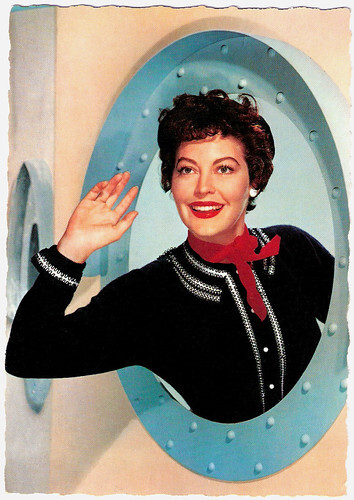
French postcard by E.D.U.G., no. 48.
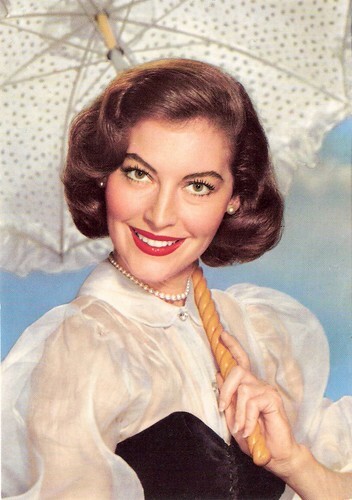
Italian postcard by Rotalcolor (Rotalfoto), Milano (Milan), no. 13.
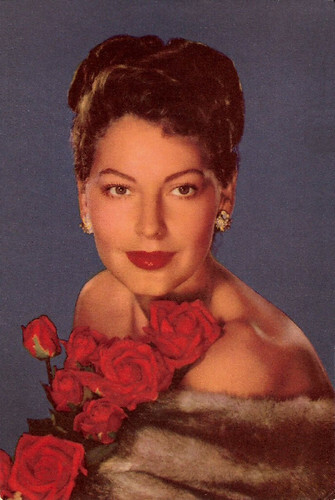
Vintage Postcard.
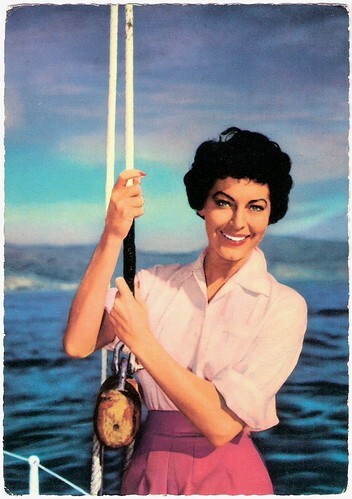
German postcard by ISV, no. D 4. Photo: Civiani.
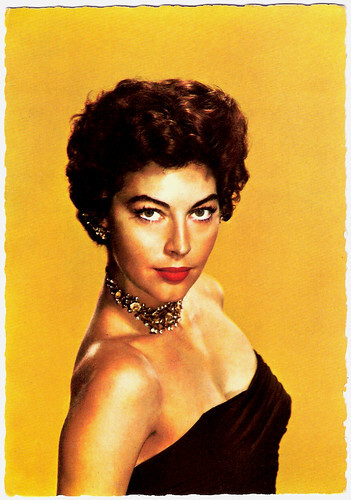
French postcard by E.D.U.G., no. 126.
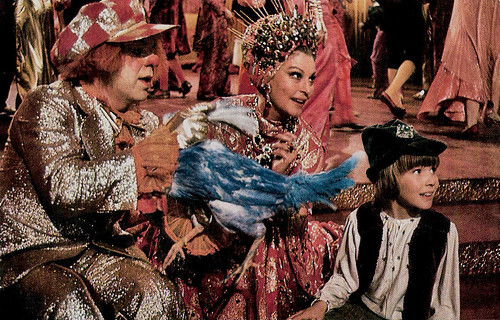
Russian postcard. Photo: Oleg Popov , Ava Gardner, and Todd Lookinland in The Blue Bird (George Cukor, 1976).

Italian postcard by Bromofoto, Milano, no. 224.

Dutch postcard, no. 3265. Photo: Universal International.

Spanish postcard, no. 261.

French postcard by Editions P.I., no. 13D. Photo: Metro-Goldwyn-Mayer, 1953.

French postcard by Editions P.I., Paris, no. 424. Photo: Metro-Goldwyn-Mayer.

Spanish collectors card, no. 3868.

British Greetings card, no. D. Photo: Virgil Apger / Metro Goldwyn Mayer.

British postcard in the Picturegoer Series, London, no. D 77. Photo: Metro Goldwyn Mayer.

French postcard by Editions P.I., La Garenne-Colombes, no. 208, 1950. Photo: Metro-Goldwyn-Mayer.

Vintage autograph card.

German postcard. Photo: Universal International Pictures. Ava Gardner in One Touch of Venus (William A. Seiter, 1948).

Belgian collectors card by Kwatta, Bois d'Haine, no. C 234. Photo: M.G.M. Publicity still for East Side, West Side (Mervyn LeRoy, 1949).

Dutch postcard.

French postcard, no. 116. Photo: Virgil Apger.

Italian postcard by B.F.F. (Casa Edit. Ballerini & Fratini), Milano, no. 2659. Photo: Metro-Goldwyn-Mayer. Publicity still for Show Boat (George Sidney, 1951).

West-German postcard by R��del-Verlag, Hamburg-Bergedorf, no. 507. Photo: 20th Century Fox. Ava Gardner and Gregory Peck in The Snows of Kilimanjaro (Henry King, 1952).

Yugoslavian postcard by Sedma Sila. Photo: IOM, Beograd. Robert Taylor and Ava Gardner in Knights of the Round Table (Richard Thorpe, 1953).

Spanish postcard by Celuloide Stars. Robert Taylor and Ava Gardner in Knights of the Round Table (Richard Thorpe, 1953).

Italian postcard by Bromofoto, Milano, no. 881. Photo: Dear Film. Publicity still for The Barefoot Contessa (Joseph L. Mankiewicz, 1954).

Vintage collectors card. Photo: MGM. Publicity still for The Barefoot Contessa (Joseph L. Mankiewicz, 1954).

Italian postcard by Rotalcolor, Milano, no. 124.

American postcard by Silvercraft, West Nyack (N.Y.). Photo: Metro-Goldwyn-Mayer. Publicity still for Bhowani Junction (George Cukor, 1956).

Italian postcard. Photo: DEAR Film.

French postcard by Editions P.I., Paris, offered by Les Carbones Kor��s 'Carboplane, no. 885. Photo: 20th Century Fox.

Italian postcard in the series Artisti di Sempre by Rotalfoto, Milano, no. 299.

Small Spanish postcard by La Revista Florita, no. 6.

French postcard by E.D.U.G., no. 48.

Italian postcard by Rotalcolor (Rotalfoto), Milano (Milan), no. 13.

Vintage Postcard.

German postcard by ISV, no. D 4. Photo: Civiani.

French postcard by E.D.U.G., no. 126.

Russian postcard. Photo: Oleg Popov , Ava Gardner, and Todd Lookinland in The Blue Bird (George Cukor, 1976).
Published on January 24, 2022 22:00
January 23, 2022
Nos Artistes
The French love their stage performers and in the early 20th Century, the magazine Comoedia published several postcard series with portraits in sepia. In the past, EFSP already did some posts on the 'Nos Artistes dans leur loge' series with French actors and actresses photographed in their dressing rooms. Next week, we will do a post on another series, called 'Nos Artistes dans leurs expressions', translated: Our Artists in their expression. Today we focus on a lesser-known series, simply called 'Nos Artistes'.
Maxa

French postcard in the Nos Artistes series by Edit. Art de Comoedia, no. 28. Photo: Comoedia.
French stage and screen actress Maxa aka Paula Maxa (1898-1970), was nicknamed "the most murdered woman in the world". Mademoiselle Maxa debuted on screen as Laure, the maid of Moréno in Louis Feuillade's crime serial Les vampires (1915-1916). She then played in four French silent films: L'ibis bleu (Camille de Morlhon, 1918), Les chères images (André Hugon, 1920), in which she had the female lead opposite Jean Angelo , La révoltée (Gaston Leprieur, 1920), and finally, Hugon's Fille de rien (André Hugon, 1921). IMDb notes in its Trivia section: "The directors of her time appreciated her excessive gestures, her screams of terror (obviously mute), which accompanied two expressive and watery bulging eyes in their excellent simulation of panic and the hysteria of being killed. For these qualities, she was chosen to be killed in films up to 350 times [this could be contested, as she only appeared in a handful of films]. But in her true career, the theatre, she died on stage up to 30,000 times. A record." Indeed, between 1917 and 1933, Maxa specialised in victims in Grand Guignol plays. Maxa's main stage partner at the Grand Guignol was Georges Paulais. She sometimes left her favourite roles for less bloody productions, boulevard comedies, and some film roles. In 2018 a Belgian Netflix film was made about her, La femme la plus assassinée du monde/The Most Assassinated Woman in the World (Frank Ribière, 2018), staring Anna Mouglalis.
Rahna

French postcard in the Nos Artistes series by Edit. Art de Comoedia, no. 29. Photo: Comoedia.
Marcelle Rahna aka Rahna and La jolie Rahna, was a French revue dancer, singer and actress in the 1920s. In 1923, she performed at the Palace Theatre in Paris with dancer Harry Pilcer in 'L'après-midi d'un Faune', based on the music by Claude Debussy. The year after, she performed with Pilcer, Polaire and Peggy Vere at the Palace in the revue 'Toutes les femmes'. In 1924 she also debuted in cinema, as la Camargo in the seven episodes of the serial Mandrin (Henri Fescourt, 1924), starring Romuald Joubé and produced by Société des Cinéromans. She played a dancer in La Clé de voûte (Roger Lion, 1925) and again as a dancer in Le P'tit Parigot (René Le Somptier, 1926). In 1930 Rahna sang in the revue 'Nudist'bar' (the French version of the Austrian revue 'Die Wunder-Bar). The last time Marcelle Rahna appeared on the screen was in the documentary Montmartre, village d'amour (1932).
Pierre Magnier

French postcard in the Nos Artistes series by Edit. Art de Comoedia, no. 30. Photo: Comoedia.
Pierre Magnier (1869-1959) was a French stage and screen actor and director, acting in over 100 films and known for La roue (Abel Gance, 1923), Cyrano de Bergerac (Augusto Genina, 1923) and La règle du jeu (Jean Renoir, 1939). In 1900 he debuted on-screen in Hamlet's Duel, a short dialogue between Hamlet and Laertes, with Sarah Bernhardt playing Hamlet. With Bernhardt, Magnier also acted in the plays 'Théodora' (1902) and 'Théroigne de Méricourt' (1902) at Bernhardt's own theater. In 1906-1908, Magnier worked with Bernhardt's rival Réjane . In 1909, Magnier started a more substantial career as a film actor in 1909 at Pathé Frères, debuting in La Maison sans enfant (Georges Monca, 1909). He had the male lead in L'ambitieuse (Camille deMorlhon, 1912), the first of a whole string of films with de Morlhon, such as L'usurier (1913), La reine Margot (1914), and La marchande de fleurs (1915), often opposite Léontine Massart . After a few more Pathé films, including L'ibis bleu (Camille deMorlhon, 1919) with Paule Maxa, he moved to Eclipse and appeared with Suzanne Grandais in Le siège des trois K (Jacques de Baroncelli, 1919). Memorable was his - supporting - part as Jacques de Hersan in La roue (Abel Gance, 1922), starring Séverin-Mars . Magnier had the male lead in Cirano di Bergerac/Cyrano de Bergerac (Augusto Genina, 1923), with Linda Moglia as Roxanne, and Angelo Ferrari as Christian. After a few more silent films, Magnier quit film acting and only returned in 1930, when the sound film had set in. From then on, he mainly focused on film acting, less on stage acting. By now, he had become the 'older man' in film plots, e.g. playing Metternich in Le congrès s'amuse (Jean Boyer, Erik Charell, 1931). He acted in many comedies, e.g. with Fernandel. In 1939 he played a general in La règle du jeu/The Rules of the Game (Jean Renoir, 1939). During the 1940s and early 1950s, Magnier kept acting in minor parts.
Maxime Léry
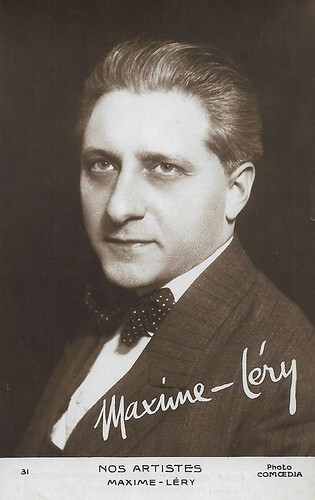
French postcard in the Nos Artistes series by Edit. Art de Comoedia, no. 31. Photo: Comoedia.
Maxime Léry (1884–1966) was a French stage and screen actor, and also a playwright. In 1913 he made his film debut at Pathé Frères as the leading actor in Le fils de Lagardère/The Heir of the Lagarderes (Henri Andréani, 1913), based on the eponymous novel by Paul Faval. After that, he only did a handful of scarce and minor parts in French silent and sound cinema.
Georges Milton
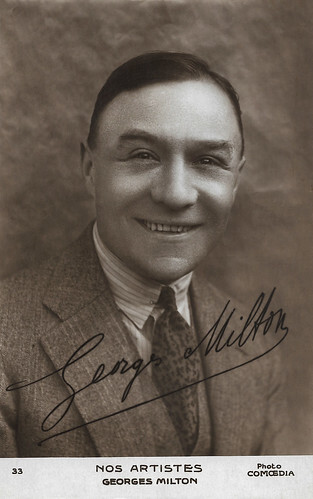
French postcard in the Nos Artistes series by Edit. Art de Comoedia, no. 33. Photo: Comoedia.
With his daring, merry songs, French singer and actor Georges Milton (1886-1970) expressed the atmosphere of the French roaring twenties. He peaked in the French cinema of the 1930s as the character Bouboule. On the advice of Maurice Chevalier , he did singing tours, which earned him immediate success, becoming one of the headliners of the main Parisian café concerts. He also played small parts in four silent films by Henri Diamant-Berger in 1923, all with Maurice Chevalier in the lead. After a revue at La Cigale, Milton turned to operetta. The huge success of the songs 'La Fille du bédouin' and 'Artichauts' from the operetta 'Comte Obligado!' (1927) propelled Milton to stardom. The arrival of sound cinema created a new career for Georges Milton. He created the character of ‘Bouboule’, a French middle-class Joe, who became the optimistic and joyful hero of a series of films. In the film adaptation Le Comte Obligado (André Mathot, 1934), Milton perfectly incorporated the ‘petit Parisien’, enormously dynamic, despite his lack of size and classic beauty. With its air of ‘average Frenchman’, he acted at least in one film a year in the 1930s. Milton retired after the war.
Georges Paulais
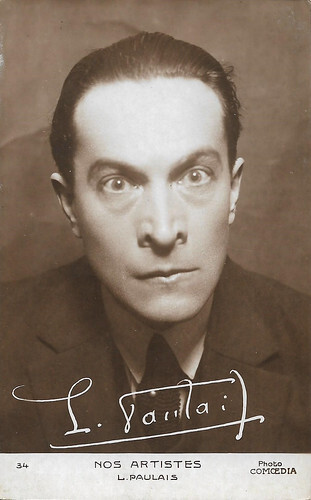
French postcard in the Nos Artistes series by Edit. Art de Comoedia, no. 34. Photo: Comoedia. As Paulais' first stage name was Georges, the signature on this card looks odd.
French actor Kléber Paulais (1884-1967) was known as Georges Paulais. After a successful career in the theatre, where he was the favourite interpreter of André de Lorde's dramas at the Grand-Guignol, the cinema called upon Georges Paulais and his deep bass voice from the beginning of the talking era. His impressive filmography is made up largely of modest, notable appearances, and spans from 1910 to 1968. In 1910-1911 he debuted at Pathé Frères where he played in dozens of shorts, directed by Albert Capellani, Georges Denola, and others. Afterward, he acted at Eclair in 1912, and again in 1914. In the later 1910s and 1920s, he had major supporting parts in Le droit de la vie (Abel Gance, 1917), Eldorado (Marcel L'Herbier, 1921), the serial Belphegor (Henri Desfontaines, 1927), and La merveilleuse vie de Jeanne d'Arc (Marco de Gastyne, 1929). In the sound era, Paulais had major parts in Accusée... levez-vous! (Maurice Tourneur, 1930) starring Gaby Morlay , Coeur de lilas (Anatole Litvak, 1932), La porteuse de pain (René Sti, 1934) starring Germaine Dermoz , and Rigolboche (Christian-Jaque, 1936) with Mistinguett , often playing lawyers and judges. Paulais had a steady, continuous career in French cinema till the early 1950s. His last part was in René Clément's Gervaise (1956).
Other Nos Artistes series
Polin
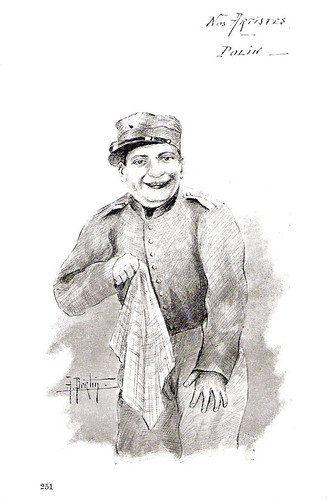
French postcard in the series Nos Artistes, no. 251. Picture: J. Bertin.
French comedian Polin (1863-1927) was one of the greatest stars of the café-concerts of Paris. His interpretations were sober and had nuance and finesse, which were rare in the café-concerts. From 1910 on, he also appeared in film and theatre, including Sacha Guitry's play Le Grand Duc/The Grand Duke (1921) with Lucien and Sacha Guitry , and Yvonne Printemps .
Gilberte Savary
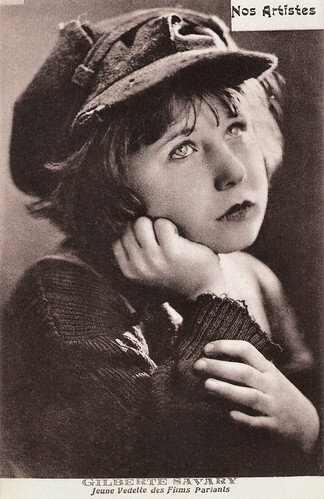
French postcard in the Nos Artistes series. Caption: Jeune Vedette des Films Parlants (Young star of the sound cinema).
French child actress Gilberte Savary (1921-1992) appeared in six films between 1928 and 1934. She made her film debut as a little girl in the silent film La faute de Monique/Monique’s fault (Maurice Gleize, 1928), with Sandra Milovanoff and Rudolf Klein Rogge . The following year, she had a small part in the Alexandre Dumas adaptation Le collier de la reine/The Queen's Necklace (Tony Lekain, Gaston Ravel, 1929) starring Marcelle Chantal and Diana Karenne . She had one of the leading roles in the circus drama La ronde des heures/Round of Hours (Alexandre Ryder, 1931) as the daughter of clown André Baugé . The success of the film made her a child star and in 1931, she appeared in a total of four films. One was a bit role in Tout ça ne vaut pas l'amour/All that is not worth the love (Jacques Tourneur, 1931) with Marcel Lévesque and the young Jean Gabin both falling in love with Josselyne Gael . In 1923, director Jacques de Baroncelli had made the fairy tale-like Le rêve/The Dream (1923), a silent film version of the sixteenth volume in Emile Zola's Rougon-Macquart saga. In 1931 he made a sound version, Le rêve/The Dream (1931), now with Savary as a lost child who is adopted by a humble family. When she has grown up, the girl (now played by Simone Genevois) falls in love with the bishop's son ( Jaque Catelain ), and the old man who plans a beau marriage is not prepared to accept it. Finally in her last film appearance, Savary played the young Eponine Thénardier in the epic Les Miserables (Raymond Bernard, 1934) starring Harry Baur as ex-convict Jean Valjean and Charles Vanel as the obsessive police inspector Javert. Now an adolescent, Gilberte retired from the screen.
Lucienne Waldor
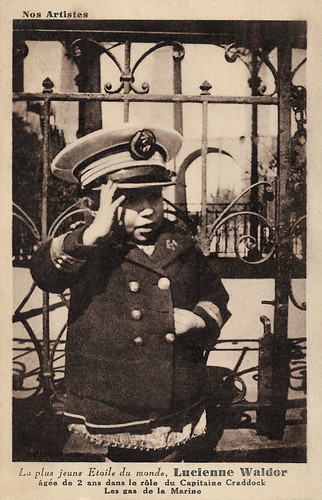
French postcard in the Nos Artistes series. Lucienne Waldor in Les gars de la Marine. Caption: the youngest star in the world, Lucienne Waldor, aged 2, in the role of Captain Craddock, singing Les gars de Marine. The -r has been forgotten on this card.
In 1933 Lucienne Waldor aka Lulu, real name Lucienne Sangan, born Lambec, was promoted as the French Shirley Temple . With her parents Lucien Waldor and his wife, her elder brother Jackie Waldor and other family members (brothers Lucky and Robert and cousin Jackson), she performed as the 'Troupe Waldor", e.g. as live intermezzo in cinemas, singing, dancing, and playing instruments, and touring all of France. Apparently, they were so popular that a boy was knocked over by a car when running out to see the family passing. Lucienne Waldor's life was haunted by car accidents. In 1937 the family had a bad car accident when returning from St. Dizier to Paris a tire exploded and the car crashed into a tree. Particularly the parents were gravely hurt. On 20 September 2019, at age 88, Lucienne Waldor was killed herself by a truck when crossing a zebra in front of the train station of St. Raphael, in a zone where trucks without special permits were forbidden.
Sources: Wikipedia (French) and .
Maxa

French postcard in the Nos Artistes series by Edit. Art de Comoedia, no. 28. Photo: Comoedia.
French stage and screen actress Maxa aka Paula Maxa (1898-1970), was nicknamed "the most murdered woman in the world". Mademoiselle Maxa debuted on screen as Laure, the maid of Moréno in Louis Feuillade's crime serial Les vampires (1915-1916). She then played in four French silent films: L'ibis bleu (Camille de Morlhon, 1918), Les chères images (André Hugon, 1920), in which she had the female lead opposite Jean Angelo , La révoltée (Gaston Leprieur, 1920), and finally, Hugon's Fille de rien (André Hugon, 1921). IMDb notes in its Trivia section: "The directors of her time appreciated her excessive gestures, her screams of terror (obviously mute), which accompanied two expressive and watery bulging eyes in their excellent simulation of panic and the hysteria of being killed. For these qualities, she was chosen to be killed in films up to 350 times [this could be contested, as she only appeared in a handful of films]. But in her true career, the theatre, she died on stage up to 30,000 times. A record." Indeed, between 1917 and 1933, Maxa specialised in victims in Grand Guignol plays. Maxa's main stage partner at the Grand Guignol was Georges Paulais. She sometimes left her favourite roles for less bloody productions, boulevard comedies, and some film roles. In 2018 a Belgian Netflix film was made about her, La femme la plus assassinée du monde/The Most Assassinated Woman in the World (Frank Ribière, 2018), staring Anna Mouglalis.
Rahna

French postcard in the Nos Artistes series by Edit. Art de Comoedia, no. 29. Photo: Comoedia.
Marcelle Rahna aka Rahna and La jolie Rahna, was a French revue dancer, singer and actress in the 1920s. In 1923, she performed at the Palace Theatre in Paris with dancer Harry Pilcer in 'L'après-midi d'un Faune', based on the music by Claude Debussy. The year after, she performed with Pilcer, Polaire and Peggy Vere at the Palace in the revue 'Toutes les femmes'. In 1924 she also debuted in cinema, as la Camargo in the seven episodes of the serial Mandrin (Henri Fescourt, 1924), starring Romuald Joubé and produced by Société des Cinéromans. She played a dancer in La Clé de voûte (Roger Lion, 1925) and again as a dancer in Le P'tit Parigot (René Le Somptier, 1926). In 1930 Rahna sang in the revue 'Nudist'bar' (the French version of the Austrian revue 'Die Wunder-Bar). The last time Marcelle Rahna appeared on the screen was in the documentary Montmartre, village d'amour (1932).
Pierre Magnier

French postcard in the Nos Artistes series by Edit. Art de Comoedia, no. 30. Photo: Comoedia.
Pierre Magnier (1869-1959) was a French stage and screen actor and director, acting in over 100 films and known for La roue (Abel Gance, 1923), Cyrano de Bergerac (Augusto Genina, 1923) and La règle du jeu (Jean Renoir, 1939). In 1900 he debuted on-screen in Hamlet's Duel, a short dialogue between Hamlet and Laertes, with Sarah Bernhardt playing Hamlet. With Bernhardt, Magnier also acted in the plays 'Théodora' (1902) and 'Théroigne de Méricourt' (1902) at Bernhardt's own theater. In 1906-1908, Magnier worked with Bernhardt's rival Réjane . In 1909, Magnier started a more substantial career as a film actor in 1909 at Pathé Frères, debuting in La Maison sans enfant (Georges Monca, 1909). He had the male lead in L'ambitieuse (Camille deMorlhon, 1912), the first of a whole string of films with de Morlhon, such as L'usurier (1913), La reine Margot (1914), and La marchande de fleurs (1915), often opposite Léontine Massart . After a few more Pathé films, including L'ibis bleu (Camille deMorlhon, 1919) with Paule Maxa, he moved to Eclipse and appeared with Suzanne Grandais in Le siège des trois K (Jacques de Baroncelli, 1919). Memorable was his - supporting - part as Jacques de Hersan in La roue (Abel Gance, 1922), starring Séverin-Mars . Magnier had the male lead in Cirano di Bergerac/Cyrano de Bergerac (Augusto Genina, 1923), with Linda Moglia as Roxanne, and Angelo Ferrari as Christian. After a few more silent films, Magnier quit film acting and only returned in 1930, when the sound film had set in. From then on, he mainly focused on film acting, less on stage acting. By now, he had become the 'older man' in film plots, e.g. playing Metternich in Le congrès s'amuse (Jean Boyer, Erik Charell, 1931). He acted in many comedies, e.g. with Fernandel. In 1939 he played a general in La règle du jeu/The Rules of the Game (Jean Renoir, 1939). During the 1940s and early 1950s, Magnier kept acting in minor parts.
Maxime Léry

French postcard in the Nos Artistes series by Edit. Art de Comoedia, no. 31. Photo: Comoedia.
Maxime Léry (1884–1966) was a French stage and screen actor, and also a playwright. In 1913 he made his film debut at Pathé Frères as the leading actor in Le fils de Lagardère/The Heir of the Lagarderes (Henri Andréani, 1913), based on the eponymous novel by Paul Faval. After that, he only did a handful of scarce and minor parts in French silent and sound cinema.
Georges Milton

French postcard in the Nos Artistes series by Edit. Art de Comoedia, no. 33. Photo: Comoedia.
With his daring, merry songs, French singer and actor Georges Milton (1886-1970) expressed the atmosphere of the French roaring twenties. He peaked in the French cinema of the 1930s as the character Bouboule. On the advice of Maurice Chevalier , he did singing tours, which earned him immediate success, becoming one of the headliners of the main Parisian café concerts. He also played small parts in four silent films by Henri Diamant-Berger in 1923, all with Maurice Chevalier in the lead. After a revue at La Cigale, Milton turned to operetta. The huge success of the songs 'La Fille du bédouin' and 'Artichauts' from the operetta 'Comte Obligado!' (1927) propelled Milton to stardom. The arrival of sound cinema created a new career for Georges Milton. He created the character of ‘Bouboule’, a French middle-class Joe, who became the optimistic and joyful hero of a series of films. In the film adaptation Le Comte Obligado (André Mathot, 1934), Milton perfectly incorporated the ‘petit Parisien’, enormously dynamic, despite his lack of size and classic beauty. With its air of ‘average Frenchman’, he acted at least in one film a year in the 1930s. Milton retired after the war.
Georges Paulais

French postcard in the Nos Artistes series by Edit. Art de Comoedia, no. 34. Photo: Comoedia. As Paulais' first stage name was Georges, the signature on this card looks odd.
French actor Kléber Paulais (1884-1967) was known as Georges Paulais. After a successful career in the theatre, where he was the favourite interpreter of André de Lorde's dramas at the Grand-Guignol, the cinema called upon Georges Paulais and his deep bass voice from the beginning of the talking era. His impressive filmography is made up largely of modest, notable appearances, and spans from 1910 to 1968. In 1910-1911 he debuted at Pathé Frères where he played in dozens of shorts, directed by Albert Capellani, Georges Denola, and others. Afterward, he acted at Eclair in 1912, and again in 1914. In the later 1910s and 1920s, he had major supporting parts in Le droit de la vie (Abel Gance, 1917), Eldorado (Marcel L'Herbier, 1921), the serial Belphegor (Henri Desfontaines, 1927), and La merveilleuse vie de Jeanne d'Arc (Marco de Gastyne, 1929). In the sound era, Paulais had major parts in Accusée... levez-vous! (Maurice Tourneur, 1930) starring Gaby Morlay , Coeur de lilas (Anatole Litvak, 1932), La porteuse de pain (René Sti, 1934) starring Germaine Dermoz , and Rigolboche (Christian-Jaque, 1936) with Mistinguett , often playing lawyers and judges. Paulais had a steady, continuous career in French cinema till the early 1950s. His last part was in René Clément's Gervaise (1956).
Other Nos Artistes series
Polin

French postcard in the series Nos Artistes, no. 251. Picture: J. Bertin.
French comedian Polin (1863-1927) was one of the greatest stars of the café-concerts of Paris. His interpretations were sober and had nuance and finesse, which were rare in the café-concerts. From 1910 on, he also appeared in film and theatre, including Sacha Guitry's play Le Grand Duc/The Grand Duke (1921) with Lucien and Sacha Guitry , and Yvonne Printemps .
Gilberte Savary

French postcard in the Nos Artistes series. Caption: Jeune Vedette des Films Parlants (Young star of the sound cinema).
French child actress Gilberte Savary (1921-1992) appeared in six films between 1928 and 1934. She made her film debut as a little girl in the silent film La faute de Monique/Monique’s fault (Maurice Gleize, 1928), with Sandra Milovanoff and Rudolf Klein Rogge . The following year, she had a small part in the Alexandre Dumas adaptation Le collier de la reine/The Queen's Necklace (Tony Lekain, Gaston Ravel, 1929) starring Marcelle Chantal and Diana Karenne . She had one of the leading roles in the circus drama La ronde des heures/Round of Hours (Alexandre Ryder, 1931) as the daughter of clown André Baugé . The success of the film made her a child star and in 1931, she appeared in a total of four films. One was a bit role in Tout ça ne vaut pas l'amour/All that is not worth the love (Jacques Tourneur, 1931) with Marcel Lévesque and the young Jean Gabin both falling in love with Josselyne Gael . In 1923, director Jacques de Baroncelli had made the fairy tale-like Le rêve/The Dream (1923), a silent film version of the sixteenth volume in Emile Zola's Rougon-Macquart saga. In 1931 he made a sound version, Le rêve/The Dream (1931), now with Savary as a lost child who is adopted by a humble family. When she has grown up, the girl (now played by Simone Genevois) falls in love with the bishop's son ( Jaque Catelain ), and the old man who plans a beau marriage is not prepared to accept it. Finally in her last film appearance, Savary played the young Eponine Thénardier in the epic Les Miserables (Raymond Bernard, 1934) starring Harry Baur as ex-convict Jean Valjean and Charles Vanel as the obsessive police inspector Javert. Now an adolescent, Gilberte retired from the screen.
Lucienne Waldor

French postcard in the Nos Artistes series. Lucienne Waldor in Les gars de la Marine. Caption: the youngest star in the world, Lucienne Waldor, aged 2, in the role of Captain Craddock, singing Les gars de Marine. The -r has been forgotten on this card.
In 1933 Lucienne Waldor aka Lulu, real name Lucienne Sangan, born Lambec, was promoted as the French Shirley Temple . With her parents Lucien Waldor and his wife, her elder brother Jackie Waldor and other family members (brothers Lucky and Robert and cousin Jackson), she performed as the 'Troupe Waldor", e.g. as live intermezzo in cinemas, singing, dancing, and playing instruments, and touring all of France. Apparently, they were so popular that a boy was knocked over by a car when running out to see the family passing. Lucienne Waldor's life was haunted by car accidents. In 1937 the family had a bad car accident when returning from St. Dizier to Paris a tire exploded and the car crashed into a tree. Particularly the parents were gravely hurt. On 20 September 2019, at age 88, Lucienne Waldor was killed herself by a truck when crossing a zebra in front of the train station of St. Raphael, in a zone where trucks without special permits were forbidden.
Sources: Wikipedia (French) and .
Published on January 23, 2022 22:00
January 22, 2022
The Incredibles (2004)
In our sixth and for now the last post on Pixar, we focus on the superhero film The Incredibles (Brad Bird, 2004). This American computer-animated film was the sixth feature produced by Pixar Animation Studios and released by Walt Disney Pictures. Set in a fictitious version of the 1960s, the film follows Bob and Helen Parr, a couple of superheroes, known as Mr. Incredible and Elastigirl, who hide their powers in accordance with a government mandate and attempt to live a quiet suburban life with their three children. Bob's desire to help people draws the entire family into a confrontation with a vengeful fan-turned-foe. Although the film was not as successful as its predecessor Finding Nemo (2003), it still received 27 awards and the film's DVD was the best-selling DVD of 2005, selling 17.4 million copies.
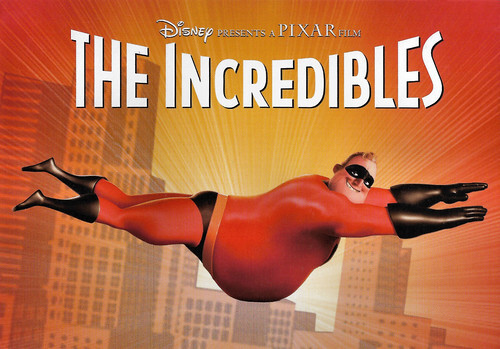
Belgian postcard by Boomerang. Image: Disney / Pixar. The Incredibles (Brad Bird, 2004). Caption: Now on DVD!
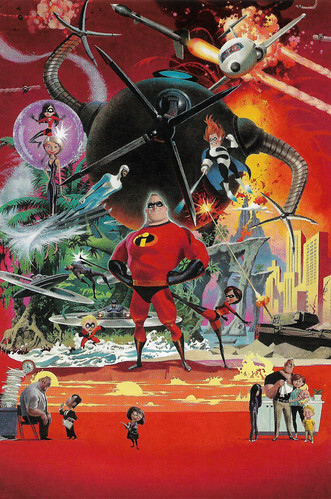
American postcard by Disney Enterprises / Pixar Animation Studios, 2005. Image: Pixar Animation Studios. Art by Robert McGinnis for The Incredibles (Brad Bird, 2004). From 'The Art of Pixar: 100 Collectible Postcards, published by Chronicle Books.
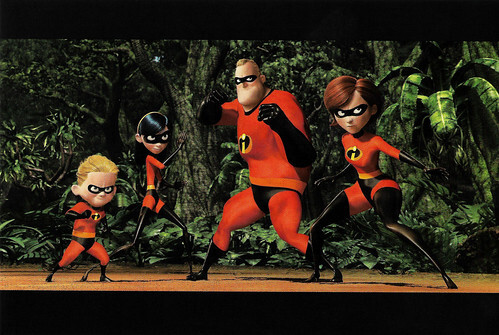
American postcard by Disney Enterprises / Pixar Animation Studios, 2005. Image: Pixar Animation Studios. Film image of The Incredibles (Brad Bird, 2004). From 'The Art of Pixar: 100 Collectible Postcards, published by Chronicle Books.
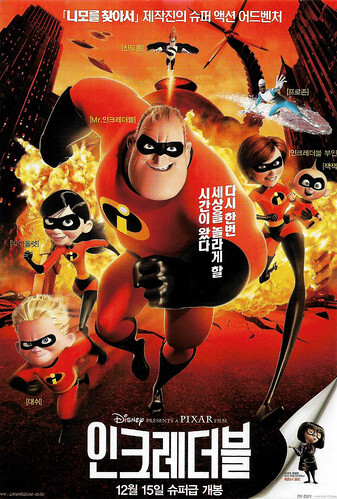
American postcard by Disney Enterprises / Pixar Animation Studios, 2005. Image: Pixar Animation Studios. Korean poster for The Incredibles (Brad Bird, 2004). From 'The Art of Pixar: 100 Collectible Postcards, published by Chronicle Books.

American postcard by Disney Enterprises / Pixar Animation Studios, 2005. Image: Pixar Animation Studios. Art by Paul Topolos for The Incredibles (Brad Bird, 2004). From 'The Art of Pixar: 100 Collectible Postcards, published by Chronicle Books.
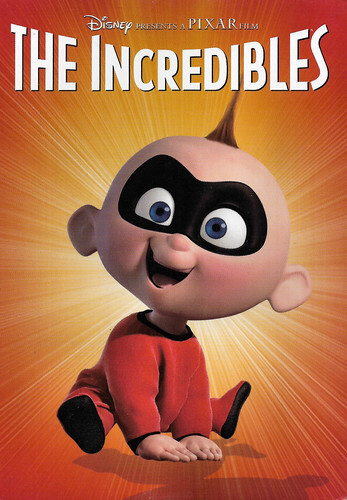
Belgian postcard by Boomerang promoting the DVD of the film. Image: Disney / Pixar. Jack-Jack in The Incredibles (Brad Bird, 2004).
Ex-superheroes
The story of The Incredibles begins with a still young Mr. Incredible a.k.a. Bob Parr who, like any superhero, performs his daily heroic deeds. He is unexpectedly visited by Buddy, a young fan eager to become his helper. Buddy turns out to be more of a nuisance than a help, despite his self-invented gadgets, and Mr. Incredible sends him away.
Later that day, he marries the superheroine Elastigirl (Helen). Then, suddenly, things go wrong. After Mr. Incredible saves a man who was about to commit suicide, the man sues him. This leads to a chain reaction of lawsuits against superheroes. The government decides to help the superheroes by setting up a special programme that will pay for all their lawsuits and provide them with new identities, on the condition that they never do heroic work again.
15 years later, Bob and Helen have settled into a quiet little town. They now have three children: teenage Violet, 10-year-old Dashiell ("Dash"), and baby Jack-Jack. Violet and Dash each have superpowers, but Jack-Jack is apparently normal. Bob, who now works at an insurance company, is frustrated that he can't help anyone anymore. He still tries to be a "hero" by pointing out loopholes in the law to his clients so they can get their benefits. He also regularly goes out at night with his old friend Lucius (also an ex-superhero called Frozone) to help people.
He is unknowingly shadowed by Mirage, a mysterious woman. After Bob loses his job, Mirage contacts him. She offers him a large sum of money if Bob will take out a runaway robot, the Omnidroid 9000, on an island. Bob accepts the job and defeats the Omnidroid. After this, Bob gets more and more assignments. He starts training again to get in shape and has the fashion designer Edna Mode make him a new suit.
Two months later, Mirage calls Bob again. When Bob arrives on the same island again, he is attacked by an enhanced version of the Omnidroid. He is captured by the mastermind behind the Omnidroid, a man called Syndrome. This Syndrome is none other than his old fan Buddy. He has made a fortune over the past 15 years inventing and selling weapons. He has kept the best weapons in order to become a hero, despite his lack of superpowers.
Later, when Mr. Incredible escapes and looks into Syndrome's computer, he is horrified to discover that Syndrome has already killed dozens of superheroes to prepare his Omnidroid for battle with Mr. Incredible. At home, Helen discovers Bob's absence. When she sees that his old superhero suit has been repaired, she immediately goes to Edna.
Edna shows the superhero costumes that she has made for all the members of the family. From Edna, she hears that Bob was fired months ago and has started working as a superhero again. Thanks to a transmitter Edna fitted into Bob's suit, Helen discovers Bob's location and immediately jets off to the island. Dash and Violet come along as stowaways. Unfortunately for Mr. Incredible, the transmitter also gives his location away to Syndrome and he is captured again.
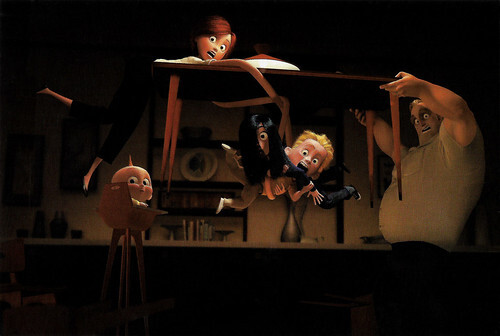
American postcard by Disney Enterprises / Pixar Animation Studios, 2005. Image: Pixar Animation Studios. Film image of The Incredibles (Brad Bird, 2004). From 'The Art of Pixar: 100 Collectible Postcards, published by Chronicle Books.
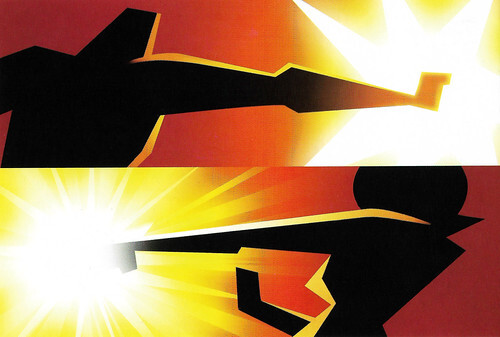
American postcard by Disney Enterprises / Pixar Animation Studios, 2005. Image: Pixar Animation Studios. End credit art by Teddy Newton for The Incredibles (Brad Bird, 2004). From 'The Art of Pixar: 100 Collectible Postcards, published by Chronicle Books.
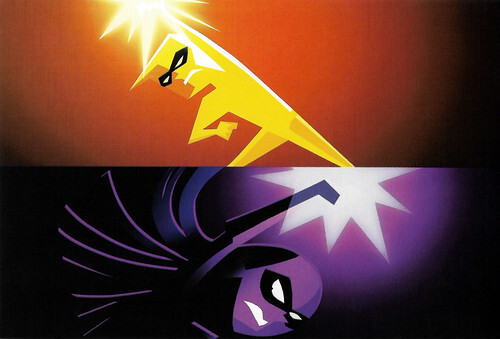
End credit art by Teddy NewtonAmerican postcard by Disney Enterprises / Pixar Animation Studios, 2005. Image: Pixar Animation Studios. Film image of The Incredibles (Brad Bird, 2004). From 'The Art of Pixar: 100 Collectible Postcards, published by Chronicle Books.
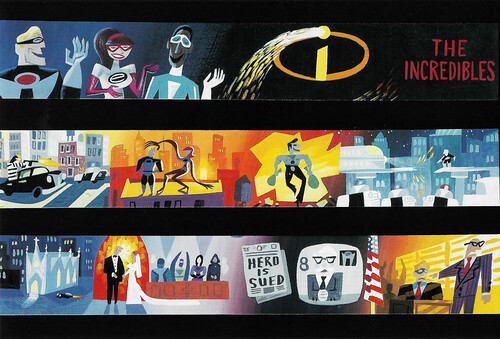
American postcard by Disney Enterprises / Pixar Animation Studios, 2005. Image: Pixar Animation Studios. Concept art by Lou Romano for The Incredibles (Brad Bird, 2004). From 'The Art of Pixar: 100 Collectible Postcards, published by Chronicle Books.
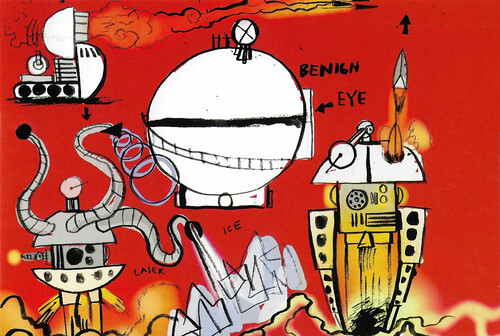
American postcard by Disney Enterprises / Pixar Animation Studios, 2005. Image: Pixar Animation Studios. Concept art by Lou Romano for The Incredibles (Brad Bird, 2004). From 'The Art of Pixar: 100 Collectible Postcards, published by Chronicle Books.
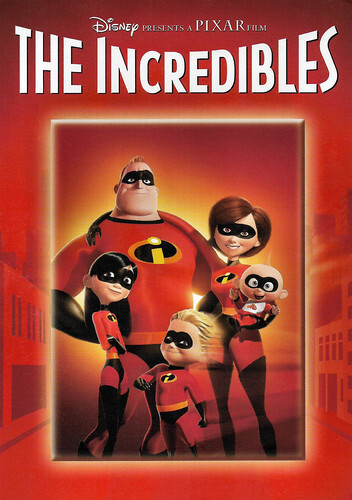
Belgian postcard by Boomerang. Image: Disney / Pixar. The Incredibles (Brad Bird, 2004). Caption: Now on DVD!
Alternating breakneck action with satire of suburban sitcom life
Brad Bird originally conceived the screenplay for The Incredibles for a traditional, animated film for Warner Bros. According to his own account, he got the idea from a drawing he had made in 1993. He developed the film as an extension of the 1960s comic books and spy films from his boyhood and personal family life. After the film Looney Tunes: Back in Action (Joe Dante, Eric Goldberg, 2003) became a flop, Warner Bros. closed its animated film division, and the project for The Incredibles was cancelled.
When Bird later talked to his friend John Lasseter about the film, Lasseter convinced him to give Pixar a try. Bird and Lasseter knew each other from their college years at CalArts in the 1970s. Pixar accepted Bird's script but changed the animation to computer animation. This made it the first Pixar film to feature only human characters.
At his request, Bird was allowed to put together his own crew. He approached people he had worked with on The Iron Giant (Brad Bird, 1999), among others. Bird's idea contained many scenes that were difficult for computer animation to do. Among other things, new techniques were needed to realistically depict human anatomy, clothing, and skin. Among other things, Violet's long hair was technically difficult to draw. The film was largely treated as if it were a live-action production.
John Barry was the first choice for the composer because of his music for the trailer of the James Bond film On Her Majesty's Secret Service (Peter R. Hunt, 1969). However, Barry did not want to recreate his old soundtracks for the film, so Michael Giacchino was approached. The music in the film is entirely instrumental.
Critics' reactions were very positive. Critic Roger Ebert awarded the film 3.5 out of 4 stars and wrote: "The Pixar Studios, which cannot seem to take a wrong step, steps right again with "The Incredibles," a superhero spoof that alternates breakneck action with satire of suburban sitcom life. After the "Toy Story" movies, "A Bug's Life," "Monsters, Inc." and "Finding Nemo," here's another example of Pixar's mastery of popular animation."
The film is generally regarded as one of the best Pixar films. One point that many critics noticed was that the film had a much more serious and mature undertone than previous Pixar films. However, this was also a point of negative criticism. The film clearly contained more and more realistic violence than previous Pixar films.
The film won the Academy Award in 2005 for the Best Animated Film (the second Pixar film to win this award) and the award for best sound effects. The film was also nominated for the award for best screenplay and best sound. The Incredibles made $70,467,623 in its opening week, more than any Pixar film has ever made in its opening week. The film even (just) beat Finding Nemo's revenue of $70,251,710. The film brought in a total of $261,441,092, making it the second most successful Pixar film ever, and the fifth most successful film of 2004. Worldwide revenue was $631,436,092. A sequel, Incredibles 2, was released in 2018.
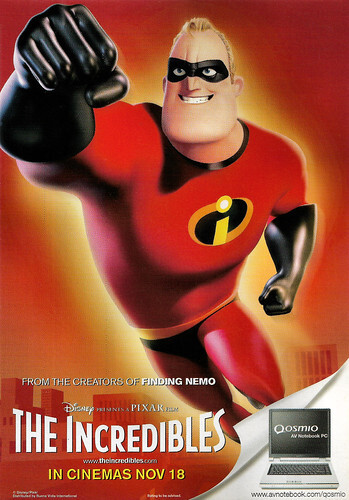
British postcard by Arcard Cards promoting Toshiba's Qosmio AV Notebook PC, no. 678. Image: Disney / Pixar. Bob Parr, Mr. Incredible in The Incredibles (Brad Bird, 2004). Caption: Mr. Incredible. HT: 2.0m. WT: 158 kg. Powers: Strength & Agility. Fifteen years (and fifty pounds) after he hung up his hero suit, Mr. Incredible, once the best-known most popular super alive, has gone underground and is living as Bob Parr, a claims adjuster at possibly the world's worst insurance company, Insuricare. Though Bob's preoccupation with bygone days has taken a toll on him and his family, he's surprised to learn that his greatest adventures lay ahead.
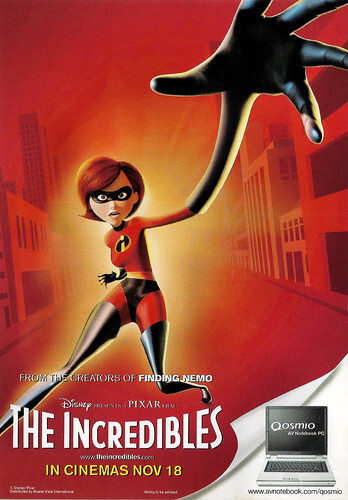
British postcard by Arcard Cards promoting Toshiba's Qosmio AV Notebook PC, no. 679. Image: Disney / Pixar. Helen Parr, Elastigal in The Incredibles (Brad Bird, 2004). Caption: Elastigal. HT: 1.73 m. WT: 56.7 kg. Powers: Flexibility & Stretching. Helen Parr, Bob's wife, has adjusted to normal life quite well and is busily focused on caring for her three children. While she occasionally uses her amazing stretching ability to meet the daily challenges of motherhood, she is careful to do so only behind the closed doors of their suburban home. She misses the old days but doesn't dwell on them. She only wishes that Bob would do the same.
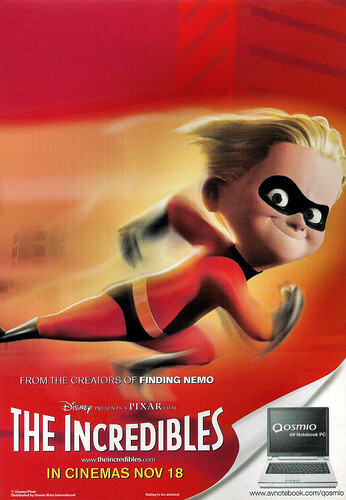
British postcard by Arcard Cards promoting Toshiba's Qosmio AV Notebook PC, no. 680. Image: Disney / Pixar. Dash in The Incredibles (Brad Bird, 2004). Caption: Dash. HT: 1.22 m. WT: 29.5 kg. Powers: Super speed & Superior Reaction Time. Like most ten-year-old boys, Dash seems to be moving even when standing still. Full of restless energy, he has the power of super speed, a power so useful for playing pranks on his least favourite teacher that he has difficulty keeping it in check. Dash has been called into the principal's office more than once, but he's never been caught. Dash doesn't understand why his family should hide their powers - why would they have them if they weren't supposed to use them?
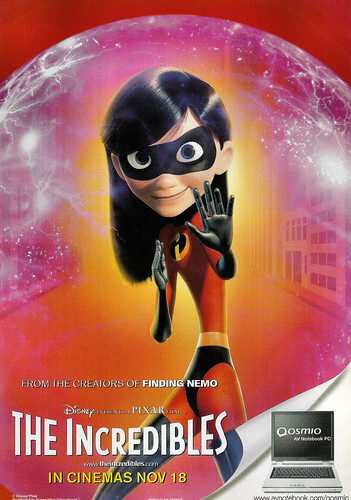
British postcard by Arcard Cards promoting Toshiba's Qosmio AV Notebook PC, no. 681. Image: Disney / Pixar. Violet in The Incredibles (Brad Bird, 2004). Caption: Violet. HT: 1.37m. WT: 158kg [sic]. Powers: Invisibility & Forcefield. Violet Parr is, in most ways, a typical shy, insecure teenage girl stuck at the crossroads between child and woman. She, like her superhero parents, possesses special powers. It seems only right that hers allow her to disappear from view and her problems, at a moment's notice - especially for someone who desperately wants to be like everybody else, but isn't.
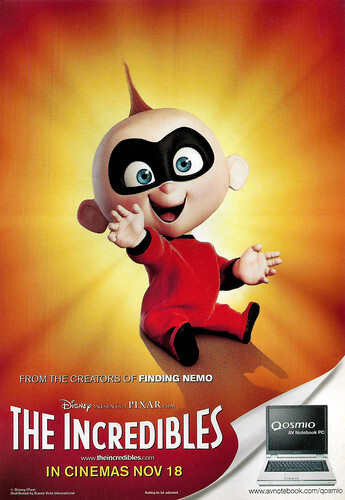
British postcard by Arcard Cards promoting Toshiba's Qosmio AV Notebook PC, no. 682. Image: Disney / Pixar. Jack-Jack in The Incredibles (Brad Bird, 2004). Caption: Jack-Jack. HT: 0.76m. WT: 11.3kg. Powers: unknown. Jack-Jack is the little black sheep of the family. The most unusual thing about him is how there is nothing unusual about him. But who knows? Like all babies, he has 'incredible' potential.
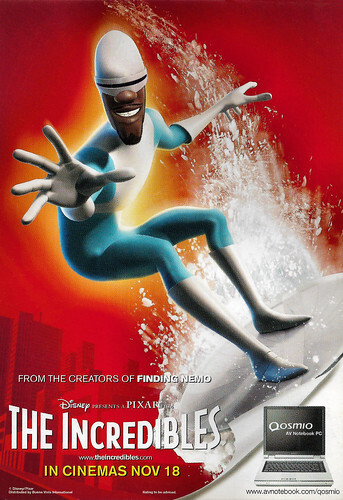
British postcard by Arcard Cards promoting Toshiba's Qosmio AV Notebook PC, no. 683. Image: Disney / Pixar. Lucius Best, Frozone in The Incredibles (Brad Bird, 2004). Caption: Frozone. HT: 1.88m. WT: 81.6kg. Powers: Freezing Ability. Lucius Best used to be known as Frozone - the coolest Super of them all. His style, wit, and ability to create ice from moisture in the air (not to mention his special multi-function boots) made him the envy of every gadget-loving little boy. The best friend of Mr. Incredible. Lucius knows the old days are done and doesn't try to relive the past. But he knows Bob still wants to and tries to help him chill out in any way he can.
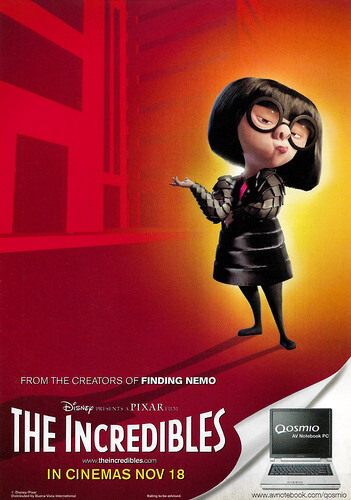
British postcard by Arcard Cards promoting Toshiba's Qosmio AV Notebook PC, no. 684 Image: Disney / Pixar. Edna 'E' Mode in The Incredibles (Brad Bird, 2004). Caption: Edna Mode. Ht: 1.12 m. Wt: Not telling, Dahling! Powers: Fashion Genious, Dahling! Though she first gained notoriety as the world's leading superhero costume designer, Edna Mode (known as E) remains a leading figure in international fashion. Still at the top of her game, E is bored with vapid, "brainless" supermodels, finding it particularly galling as she "used to design for Gods." She longs for the return of the Supers, for a real design challenge, for one more chance to fuse the latest technology with her impeccable fashion sense.
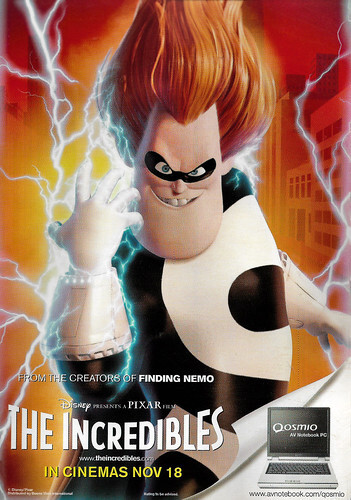
British postcard by Arcard Cards promoting Toshiba's Qosmio AV Notebook PC, no. 685 Image: Disney / Pixar. Buddy Pine a.k.a. Syndrome in The Incredibles (Brad Bird, 2004). Caption: Syndrome. Ht: 1.85 m. Wt: 83.9 kg Powers: Unlimited Budget. Highly intelligent and cunning, Syndrome spends his days on Nomanison Island, a remote paradise on the far side of the world. An accomplished inventor, Syndrome is torn between admiration and resentment towards the Supers.
Sources: Roger Ebert (RogerEbert.com), Wikipedia (Dutch and English), and IMDb.

Belgian postcard by Boomerang. Image: Disney / Pixar. The Incredibles (Brad Bird, 2004). Caption: Now on DVD!

American postcard by Disney Enterprises / Pixar Animation Studios, 2005. Image: Pixar Animation Studios. Art by Robert McGinnis for The Incredibles (Brad Bird, 2004). From 'The Art of Pixar: 100 Collectible Postcards, published by Chronicle Books.

American postcard by Disney Enterprises / Pixar Animation Studios, 2005. Image: Pixar Animation Studios. Film image of The Incredibles (Brad Bird, 2004). From 'The Art of Pixar: 100 Collectible Postcards, published by Chronicle Books.

American postcard by Disney Enterprises / Pixar Animation Studios, 2005. Image: Pixar Animation Studios. Korean poster for The Incredibles (Brad Bird, 2004). From 'The Art of Pixar: 100 Collectible Postcards, published by Chronicle Books.

American postcard by Disney Enterprises / Pixar Animation Studios, 2005. Image: Pixar Animation Studios. Art by Paul Topolos for The Incredibles (Brad Bird, 2004). From 'The Art of Pixar: 100 Collectible Postcards, published by Chronicle Books.

Belgian postcard by Boomerang promoting the DVD of the film. Image: Disney / Pixar. Jack-Jack in The Incredibles (Brad Bird, 2004).
Ex-superheroes
The story of The Incredibles begins with a still young Mr. Incredible a.k.a. Bob Parr who, like any superhero, performs his daily heroic deeds. He is unexpectedly visited by Buddy, a young fan eager to become his helper. Buddy turns out to be more of a nuisance than a help, despite his self-invented gadgets, and Mr. Incredible sends him away.
Later that day, he marries the superheroine Elastigirl (Helen). Then, suddenly, things go wrong. After Mr. Incredible saves a man who was about to commit suicide, the man sues him. This leads to a chain reaction of lawsuits against superheroes. The government decides to help the superheroes by setting up a special programme that will pay for all their lawsuits and provide them with new identities, on the condition that they never do heroic work again.
15 years later, Bob and Helen have settled into a quiet little town. They now have three children: teenage Violet, 10-year-old Dashiell ("Dash"), and baby Jack-Jack. Violet and Dash each have superpowers, but Jack-Jack is apparently normal. Bob, who now works at an insurance company, is frustrated that he can't help anyone anymore. He still tries to be a "hero" by pointing out loopholes in the law to his clients so they can get their benefits. He also regularly goes out at night with his old friend Lucius (also an ex-superhero called Frozone) to help people.
He is unknowingly shadowed by Mirage, a mysterious woman. After Bob loses his job, Mirage contacts him. She offers him a large sum of money if Bob will take out a runaway robot, the Omnidroid 9000, on an island. Bob accepts the job and defeats the Omnidroid. After this, Bob gets more and more assignments. He starts training again to get in shape and has the fashion designer Edna Mode make him a new suit.
Two months later, Mirage calls Bob again. When Bob arrives on the same island again, he is attacked by an enhanced version of the Omnidroid. He is captured by the mastermind behind the Omnidroid, a man called Syndrome. This Syndrome is none other than his old fan Buddy. He has made a fortune over the past 15 years inventing and selling weapons. He has kept the best weapons in order to become a hero, despite his lack of superpowers.
Later, when Mr. Incredible escapes and looks into Syndrome's computer, he is horrified to discover that Syndrome has already killed dozens of superheroes to prepare his Omnidroid for battle with Mr. Incredible. At home, Helen discovers Bob's absence. When she sees that his old superhero suit has been repaired, she immediately goes to Edna.
Edna shows the superhero costumes that she has made for all the members of the family. From Edna, she hears that Bob was fired months ago and has started working as a superhero again. Thanks to a transmitter Edna fitted into Bob's suit, Helen discovers Bob's location and immediately jets off to the island. Dash and Violet come along as stowaways. Unfortunately for Mr. Incredible, the transmitter also gives his location away to Syndrome and he is captured again.

American postcard by Disney Enterprises / Pixar Animation Studios, 2005. Image: Pixar Animation Studios. Film image of The Incredibles (Brad Bird, 2004). From 'The Art of Pixar: 100 Collectible Postcards, published by Chronicle Books.

American postcard by Disney Enterprises / Pixar Animation Studios, 2005. Image: Pixar Animation Studios. End credit art by Teddy Newton for The Incredibles (Brad Bird, 2004). From 'The Art of Pixar: 100 Collectible Postcards, published by Chronicle Books.

End credit art by Teddy NewtonAmerican postcard by Disney Enterprises / Pixar Animation Studios, 2005. Image: Pixar Animation Studios. Film image of The Incredibles (Brad Bird, 2004). From 'The Art of Pixar: 100 Collectible Postcards, published by Chronicle Books.

American postcard by Disney Enterprises / Pixar Animation Studios, 2005. Image: Pixar Animation Studios. Concept art by Lou Romano for The Incredibles (Brad Bird, 2004). From 'The Art of Pixar: 100 Collectible Postcards, published by Chronicle Books.

American postcard by Disney Enterprises / Pixar Animation Studios, 2005. Image: Pixar Animation Studios. Concept art by Lou Romano for The Incredibles (Brad Bird, 2004). From 'The Art of Pixar: 100 Collectible Postcards, published by Chronicle Books.

Belgian postcard by Boomerang. Image: Disney / Pixar. The Incredibles (Brad Bird, 2004). Caption: Now on DVD!
Alternating breakneck action with satire of suburban sitcom life
Brad Bird originally conceived the screenplay for The Incredibles for a traditional, animated film for Warner Bros. According to his own account, he got the idea from a drawing he had made in 1993. He developed the film as an extension of the 1960s comic books and spy films from his boyhood and personal family life. After the film Looney Tunes: Back in Action (Joe Dante, Eric Goldberg, 2003) became a flop, Warner Bros. closed its animated film division, and the project for The Incredibles was cancelled.
When Bird later talked to his friend John Lasseter about the film, Lasseter convinced him to give Pixar a try. Bird and Lasseter knew each other from their college years at CalArts in the 1970s. Pixar accepted Bird's script but changed the animation to computer animation. This made it the first Pixar film to feature only human characters.
At his request, Bird was allowed to put together his own crew. He approached people he had worked with on The Iron Giant (Brad Bird, 1999), among others. Bird's idea contained many scenes that were difficult for computer animation to do. Among other things, new techniques were needed to realistically depict human anatomy, clothing, and skin. Among other things, Violet's long hair was technically difficult to draw. The film was largely treated as if it were a live-action production.
John Barry was the first choice for the composer because of his music for the trailer of the James Bond film On Her Majesty's Secret Service (Peter R. Hunt, 1969). However, Barry did not want to recreate his old soundtracks for the film, so Michael Giacchino was approached. The music in the film is entirely instrumental.
Critics' reactions were very positive. Critic Roger Ebert awarded the film 3.5 out of 4 stars and wrote: "The Pixar Studios, which cannot seem to take a wrong step, steps right again with "The Incredibles," a superhero spoof that alternates breakneck action with satire of suburban sitcom life. After the "Toy Story" movies, "A Bug's Life," "Monsters, Inc." and "Finding Nemo," here's another example of Pixar's mastery of popular animation."
The film is generally regarded as one of the best Pixar films. One point that many critics noticed was that the film had a much more serious and mature undertone than previous Pixar films. However, this was also a point of negative criticism. The film clearly contained more and more realistic violence than previous Pixar films.
The film won the Academy Award in 2005 for the Best Animated Film (the second Pixar film to win this award) and the award for best sound effects. The film was also nominated for the award for best screenplay and best sound. The Incredibles made $70,467,623 in its opening week, more than any Pixar film has ever made in its opening week. The film even (just) beat Finding Nemo's revenue of $70,251,710. The film brought in a total of $261,441,092, making it the second most successful Pixar film ever, and the fifth most successful film of 2004. Worldwide revenue was $631,436,092. A sequel, Incredibles 2, was released in 2018.

British postcard by Arcard Cards promoting Toshiba's Qosmio AV Notebook PC, no. 678. Image: Disney / Pixar. Bob Parr, Mr. Incredible in The Incredibles (Brad Bird, 2004). Caption: Mr. Incredible. HT: 2.0m. WT: 158 kg. Powers: Strength & Agility. Fifteen years (and fifty pounds) after he hung up his hero suit, Mr. Incredible, once the best-known most popular super alive, has gone underground and is living as Bob Parr, a claims adjuster at possibly the world's worst insurance company, Insuricare. Though Bob's preoccupation with bygone days has taken a toll on him and his family, he's surprised to learn that his greatest adventures lay ahead.

British postcard by Arcard Cards promoting Toshiba's Qosmio AV Notebook PC, no. 679. Image: Disney / Pixar. Helen Parr, Elastigal in The Incredibles (Brad Bird, 2004). Caption: Elastigal. HT: 1.73 m. WT: 56.7 kg. Powers: Flexibility & Stretching. Helen Parr, Bob's wife, has adjusted to normal life quite well and is busily focused on caring for her three children. While she occasionally uses her amazing stretching ability to meet the daily challenges of motherhood, she is careful to do so only behind the closed doors of their suburban home. She misses the old days but doesn't dwell on them. She only wishes that Bob would do the same.

British postcard by Arcard Cards promoting Toshiba's Qosmio AV Notebook PC, no. 680. Image: Disney / Pixar. Dash in The Incredibles (Brad Bird, 2004). Caption: Dash. HT: 1.22 m. WT: 29.5 kg. Powers: Super speed & Superior Reaction Time. Like most ten-year-old boys, Dash seems to be moving even when standing still. Full of restless energy, he has the power of super speed, a power so useful for playing pranks on his least favourite teacher that he has difficulty keeping it in check. Dash has been called into the principal's office more than once, but he's never been caught. Dash doesn't understand why his family should hide their powers - why would they have them if they weren't supposed to use them?

British postcard by Arcard Cards promoting Toshiba's Qosmio AV Notebook PC, no. 681. Image: Disney / Pixar. Violet in The Incredibles (Brad Bird, 2004). Caption: Violet. HT: 1.37m. WT: 158kg [sic]. Powers: Invisibility & Forcefield. Violet Parr is, in most ways, a typical shy, insecure teenage girl stuck at the crossroads between child and woman. She, like her superhero parents, possesses special powers. It seems only right that hers allow her to disappear from view and her problems, at a moment's notice - especially for someone who desperately wants to be like everybody else, but isn't.

British postcard by Arcard Cards promoting Toshiba's Qosmio AV Notebook PC, no. 682. Image: Disney / Pixar. Jack-Jack in The Incredibles (Brad Bird, 2004). Caption: Jack-Jack. HT: 0.76m. WT: 11.3kg. Powers: unknown. Jack-Jack is the little black sheep of the family. The most unusual thing about him is how there is nothing unusual about him. But who knows? Like all babies, he has 'incredible' potential.

British postcard by Arcard Cards promoting Toshiba's Qosmio AV Notebook PC, no. 683. Image: Disney / Pixar. Lucius Best, Frozone in The Incredibles (Brad Bird, 2004). Caption: Frozone. HT: 1.88m. WT: 81.6kg. Powers: Freezing Ability. Lucius Best used to be known as Frozone - the coolest Super of them all. His style, wit, and ability to create ice from moisture in the air (not to mention his special multi-function boots) made him the envy of every gadget-loving little boy. The best friend of Mr. Incredible. Lucius knows the old days are done and doesn't try to relive the past. But he knows Bob still wants to and tries to help him chill out in any way he can.

British postcard by Arcard Cards promoting Toshiba's Qosmio AV Notebook PC, no. 684 Image: Disney / Pixar. Edna 'E' Mode in The Incredibles (Brad Bird, 2004). Caption: Edna Mode. Ht: 1.12 m. Wt: Not telling, Dahling! Powers: Fashion Genious, Dahling! Though she first gained notoriety as the world's leading superhero costume designer, Edna Mode (known as E) remains a leading figure in international fashion. Still at the top of her game, E is bored with vapid, "brainless" supermodels, finding it particularly galling as she "used to design for Gods." She longs for the return of the Supers, for a real design challenge, for one more chance to fuse the latest technology with her impeccable fashion sense.

British postcard by Arcard Cards promoting Toshiba's Qosmio AV Notebook PC, no. 685 Image: Disney / Pixar. Buddy Pine a.k.a. Syndrome in The Incredibles (Brad Bird, 2004). Caption: Syndrome. Ht: 1.85 m. Wt: 83.9 kg Powers: Unlimited Budget. Highly intelligent and cunning, Syndrome spends his days on Nomanison Island, a remote paradise on the far side of the world. An accomplished inventor, Syndrome is torn between admiration and resentment towards the Supers.
Sources: Roger Ebert (RogerEbert.com), Wikipedia (Dutch and English), and IMDb.
Published on January 22, 2022 22:00
Directed by Max Reinhardt
Austrian-born theatre and film director, intendant, and theatrical producer Max Reinhardt (1873-1943) was one of the great innovators of the theatre in the early 20th century. In 1920, he established the Salzburg Festival with the performance of Hugo von Hofmannsthal's 'Jedermann'. He also directed several films, including Sumurûn (1910) and Das Mirakel (1912). Reinhardt profoundly influenced the expressionist movement in German film and his staging of crowds and use of lighting were appropriated by F. W. Murnau, Ernst Lubitsch, and Fritz Lang. In 1934, he went into exile and made in Hollywood A Midsummer Night's Dream (1935).
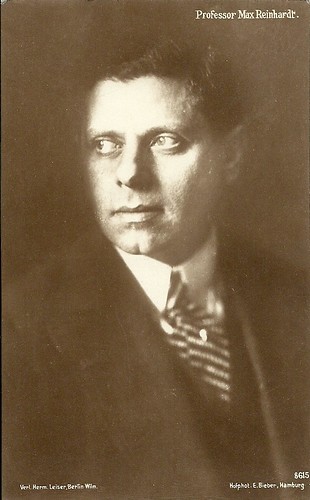
German postcard by Verlag Hermann Leiser, Berlin, no. 8615. Photo: Hofphot. E. Bieber, Hamburg. Collection: Didier Hanson.
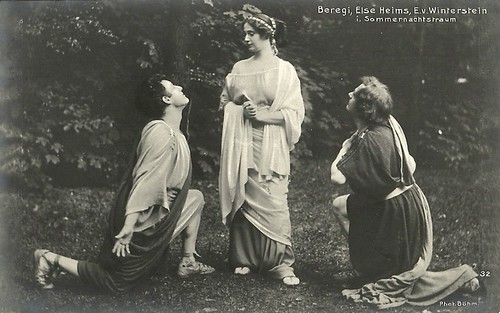
German postcard by Jos Paul Böhm, München, no. 32. Photo: Jos Paul Böhm, München. Eduard von Winterstein , Oscar Beregi , and Else Heims in the play 'Sommernachtstraum', Max Reinhardt's staging of Shakespeare's 'Midsummer Night's Dream'. It was first staged by Reinhardt in 1905.
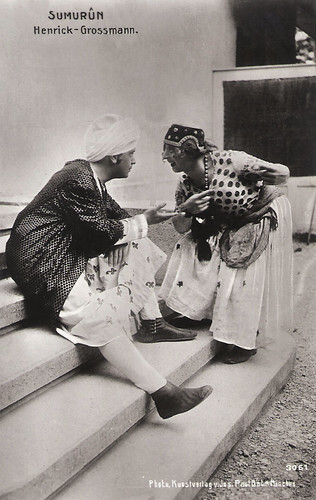
German postcard by Photo und Kunstverlag Jos. Paul Böhm, München, no. 3061. Photo: publicity still for Sumurun (Max Reinhardt, 1910) with at right Richard Grossman as the old woman. But who is the man left, Henrick? Richard Grossman played 'Die alte' (the old woman) in Max Reinhardt's first film, Sumurun (1910), based on a Pantomime by Friedrich Freksa. Perhaps this photo was made for Reinhardt's stage production, 'Sumurun' (1909) at the Kammerspielen des Deutsches Theaters. Grete Wiesenthal played the lead as Sumurun and she would repeat her role in the 1910 film version. Leopoldine Konstantin played the dancer both on stage as in the 1910 film. However, of the four main male actors - Alexander Moissi (as Nur Al Din), Rudolf Schildkraut, Paul Wegener (as the old Sheik) and Eduard von Winterstein (as his son) - only Von Winterstein returned in Reinhardt's film version, but now in the role of the old Sheik. And Wegener would return as the old Sheik in the 1920 film version of Sumurun by Ernst Lubitsch.
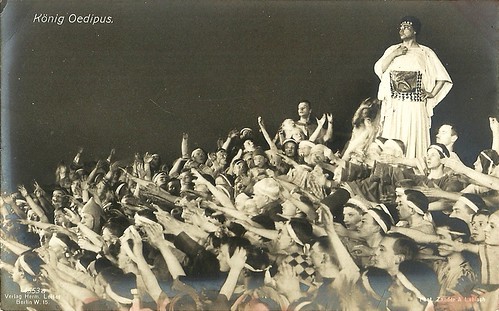
German postcard by Verlag Hermann Leiser, no. 4553a, Berlin. Photo: Zander & Labisch, Berlin. Caption: King Oedipus. Paul Wegener in 'Oedipus Rex', Sophocles's classic tragedy, directed by Max Reinhardt in a translation by Hugo von Hofmannsthal, first performed in 1910, first in a Summer festival in Munich and in the Fall in a circus arena Berlin. Stars were Paul Wegener as Oedipus and Tilla Durieux as Jocasta, though some considered the masses of extras performing the Thebans to be the real stars. Emily Bilski, in Berlin Metropolis: Jews and the New Culture, 1890-1918, writes: "Oedipus was the first major theater-in-the-round production in modern times that featured masses of actors performing for a mass audience."
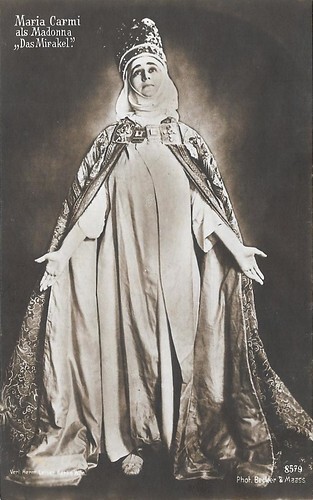
German postcard by Verlag Hermann Leiser, Berlin, no. 8579. Photo: Becker & Maass. Maria Carmi as the Madonna in Das Mirakel/The Miracle (Cherry Kearton, Max Reinhardt, 1912).
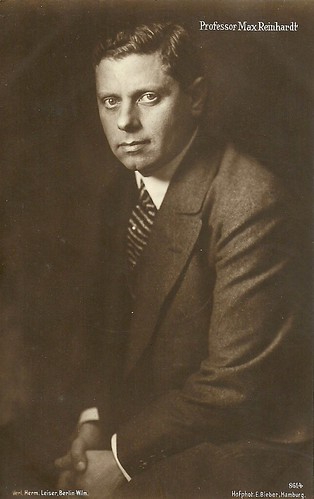
German postcard by Verlag Hermann Leiser, Berlin, no. 8614, 1916. Photo: Hofphot. E. Bieber, Hamburg. Collection: Didier Hanson.
His early landmark of genius
Max Reinhardt was born Maximilian Goldmann in 1873 in the spa town of Baden near Vienna where his parents were spa guests. He was the oldest of seven children of Wilhelm Goldmann, a Jewish merchant from Stupava, Hungary, and his wife Rachel Lea Rosi "Rosa" Goldmann (née Wengraf). Wilhelm was a corset maker and the family – officially Reinhardt after 1904 – lived in Vienna, the capital and residential city of the Austro-Hungarian monarchy, where they belonged to the organised Jewish Community of Vienna.
As a boy, Max haunted the Hofburg Theater and tried to see every play. Having finished school, he began an apprenticeship at a bank but already took acting lessons at the Sulkowsky Theater in Matzleinsdorf. In 1890, he gave his debut on a private stage in Vienna with the stage name Max Reinhardt, possibly after the protagonist Reinhard Werner in Theodor Storm's novella 'Immensee'. In 1893 he performed at the re-opened Salzburg City Theatre. One year later, Reinhardt relocated to Germany, joining the Deutsches Theater ensemble in Berlin under director Otto Brahm, who had brought the drama of Henrik Ibsen to Germany. In Berlin, Max achieved great success as an actor and director.
In 1901, Reinhardt together with Friedrich Kayßler and several other young artists created a lighthearted revue, 'Schall und Rauch' (Sound and Smoke), to which Reinhardt contributed sketches. Playing before invited audiences, it was so successful that it was transformed into a serious work and settled into the Kleines Theater (Little Theatre) in 1902. Reinhardt planned a full season and directed his first play, Oscar Wilde’s 'Salomé'. It was the first of numerous stages.
From 1903 to 1905, he managed the Neues Theater (present-day Theater am Schiffbauerdamm). By the end of 1904, he had directed 42 plays. William McPeak at IMDb : "These were all a part of his evolving philosophy of the harmony of stage design, costumes, language, music, and choreography as a whole unified artwork, Gesamtkunstwerk. He was influenced by several figures, August Strindberg for one, but most significantly by Richard Wagner and his operatic ideal that the director must pull together all aspects of art in his production. Reinhardt's infusion gave new dimensions to German theater."
His early landmark of genius was the production in 1905 of William Shakespeare’s 'A Midsummer Night’s Dream' with a wooded forest revolving stage - turning to reveal progressive new scenes. He became famous for the realistic direction of huge crowd scenes. Hovahnness Israel Pilikian at Encyclopaedia Britannica: "Reinhardt’s staging was swift, light, and joyous, capturing for audiences the theatrical brilliance that had been buried for so long beneath productions devoted to a ponderous, reverent delivery of Shakespeare’s words."
In 1906, he acquired the Deutsches Theater (German Theatre) and placated Brahm, who was furious over his breach of contract. At age 32, Reinhardt had reached the pinnacle of his profession. He completely rebuilt the German theatre, introducing the latest technological innovations in scenic design, and started a school. Purchasing a tavern next door, Reinhardt remodeled it into a small theatre for plays that needed intimacy with the audience. He summarised his new concept in theatre with the word 'Kammerspiele', chamber plays. William McPeak at IMDb : " This all opened Reinhardt to even more experimental ideas in staging with sometimes nightmarish and vivid lighting techniques. He began introducing the expressionist plays to the German-speaking public. "
In 1911, Max Reinhardt premiered with Karl Vollmöller's 'The Miracle' in Olympia, London, gaining an international reputation. It was Reinhardt’s most spectacular work and, at the same time, probably the most characteristic. Reinhardt was fascinated by the emotional richness of Roman Catholic rites and Gregorian chants. His production of 'The Miracle' involved more than 2,000 actors, musicians, dancers, and other personnel. Hovahnness Israel Pilikian at Encyclopaedia Britannica: "Performed without dramatic dialogue, it was a modern-day reunification of drama and ritual. It was pure theatre in the most archetypal sense."
From 1915 to 1918, Reinhardt also worked as director of the Volksbühne theatre and after World War I, he re-opened the Großes Schauspielhaus (after World War II renamed into Friedrichstadtpalast) in 1919, following its expressionist conversion by Hans Poelzig. In 1919 he opened an enormous arena theatre, the 'Grosses Schauspielhaus' (Great Playhouse), but known as the 'Theatre of the Five Thousand', which included a large revolving stage. Many of his biggest productions were done here, including Shakespeare and Greek plays. In the 1920s he built the two Boulevard Theaters on the Kurfürstendamm in Berlin. By 1930, he ran eleven stages in Berlin and, in addition, managed the Theater in der Josefstadt in Vienna from 1924 to 1933.
In 1920, Reinhardt established the Salzburg Festival with composer Richard Strauss and playwright Hugo von Hofmannsthal, notably directing an annual production of the morality play 'Jedermann'(Everyman) in which God sends Death to summon a representative of mankind for judgment. He staged the play in the city’s cathedral square. With Reinhardt’s support, the Salzburg Festival became an annual event, bringing about a new interest in the dramas of the Middle Ages from which Jedermann was adapted. Alexander Moissi played the role of Everyman in seven Festival summers – until his last performance on 30 August 1931. Although Moissi was, in fact, a baptised Christian, his name struck Antisemites as Jewish, and "Moissi the Jew" was subjected to a nasty campaign of character assassination by Salzburg Antisemites and Nazis who demanded that Festival president Baron Puthon refuse to involve the star of the Reinhardt ensembles in Berlin, Vienna and Salzburg in the 1932 season. When Moissi refused to play the role of Everyman if he was otherwise excluded, the Festival replaced him.
Reinhardt staged fourteen plays in the Festival city: 'Jedermann'(Everyman), 'The Great World Theater of Salzburg', 'The Hypochondriac', Das Mirakel (The Miracle), 'The Green Flute', 'Turandot', 'Servant of Two Masters', William Shakespeare's 'A Midsummer's Night Dream', 'Love and Intrigue', 'The Thief', 'Victoria', 'The Difficult', 'Stella' and finally 'Faust' in 1933. Mephisto was played by Max Pallenberg , a member of Reinhardt's ensemble at the German Theatre, whose Salzburg Festival roles also included The devil in 'Jedermann'(Everyman), Argan in 'The Hypochondriac', and Truffaldino in 'Turandot'. Pallenberg also had to leave the place of his triumphs, Berlin, in 1933.
In the United States, Max Reinhardt also successfully directed 'The Miracle' in 1924 and a popular stage version of 'A Midsummer Night's Dream' in 1927. By employing powerful staging techniques, and integrating stage design, language, music and choreography, Reinhardt introduced new dimensions into German theatre. He founded the drama schools Hochschule für Schauspielkunst 'Ernst Busch' in Berlin and the Max Reinhardt Seminar in Vienna, which is arguably the most important German-language acting school. Many alumni of these schools made their careers in film.
In 1918 Reinhardt purchased the castle Schloss Leopoldskron in Salzburg, formerly a summer palace of Salzburg's rulers, the Prince-Archbishops, which had fallen into disrepair. While living in it for nearly 20 years, he painstakingly restored the castle. He had to flee due to the Nazis' increasing anti-Semitic aggressions. The castle was seized following Germany's Anschluss annexation of Austria in 1938. After the war, the castle was restored to Reinhardt's heirs, and subsequently, the home and grounds became famous as the filming site for the early scenes of the Von Trapp family gardens in the film The Sound of Music.
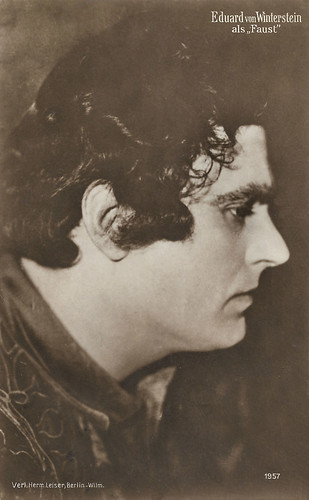
German postcard by Verlag Hermann Leiser, Berlin-Wilm., no. 1957. Eduard von Winterstein as Faust in 'Faust' directed by Max Reinhardt (1913-1916).
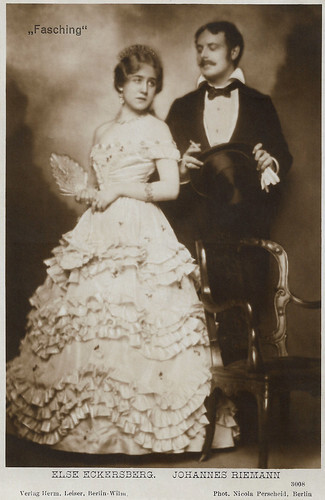
German postcard by Verlag Hermann Leiser, Berlin-Wilm., no. 3008. Photo: Nicola Perscheid. Else Eckersberg as countess Liszka and Johannes Riemann in the play 'Fasching' (Farsang; Fashions for Men) by Ferenc Molnar, directed by Max Reinhardt at the Deutsches Theater in 1917. Sent by mail in 1917.
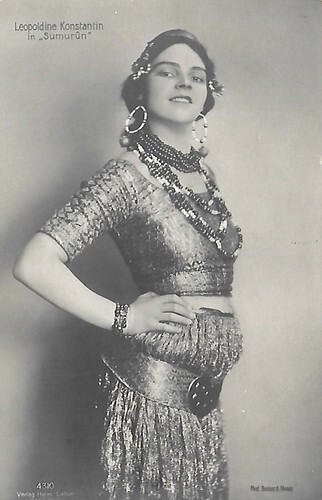
German postcard by Verlag Hermann Leiser, no. 4310. Photo: Becker & Maass. Collection: Didier Hanson. Leopoldine Konstantin in Sumurun (Max Reinhardt, 1910).
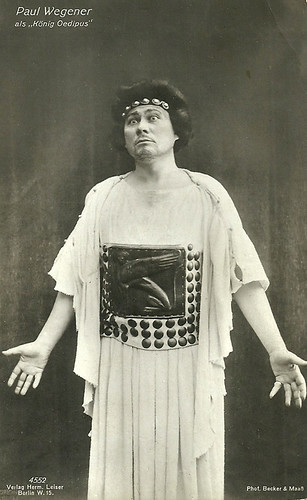
German postcard by Verlag Hermann Leiser, Berlin, no. 4552. Photo: Becker & Maass. Caption: Paul Wegener as King Oedipus.
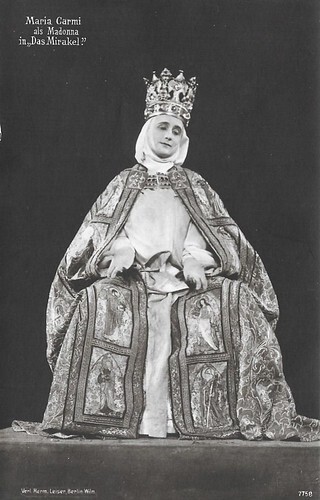
German postcard by Verleih Hermann Leiser, Berlin-Wilmersdorf, no. 7758. Maria Carmi in Das Mirakel/The Miracle (Cherry Kearton, Max Reinhardt, 1912). Collection: Didier Hanson.
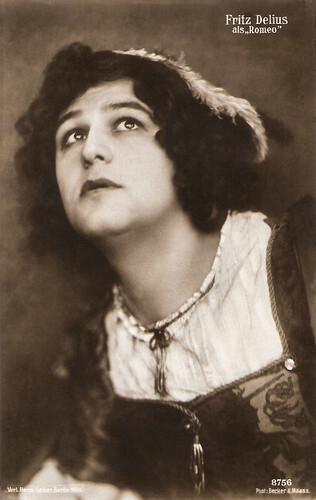
German postcard by Herm. Leiser, Berlin-Wilm., no. 8756. Photo: Becker & Maass. Fritz Delius as Romeo in 'Romeo and Juliet' by William Shakespeare, probably under the direction of Max Reinhardt, ca. 1913.
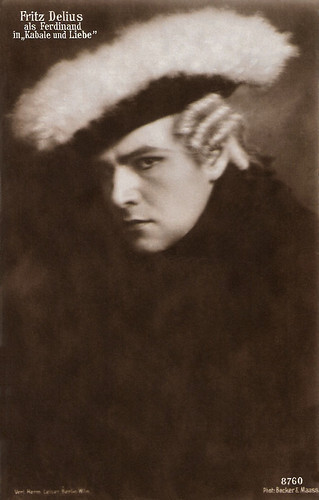
German postcard by Herm. Leiser, Berlin-Wilm., no. 8760. Photo: Becker & Maass. Fritz Delius as Ferdinand in a 1917 stage production of Friedrich Schiller's 'Kabale und Liebe' (Intrigue and Love), under the direction of Max Reinhardt.
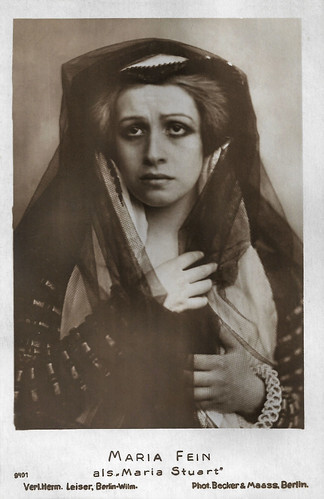
German postcard by Verlag Hermann Leiser, Berlin-Wilm., no. 9491. Photo: Becker & Maass, Berlin. Maria Fein in the title role of Friedrich Schiller's 'Maria Stuart' (Mary Stuart) in a performance at the German Theater in Berlin, 1916.
A feast for starving souls
Max Reinhardt took a greater interest in the film than most of his contemporaries in the theatre world. He made films as a director and from time to time also as a producer. His first staging was the film Sumurûn (1910). After that, Reinhardt founded his own film company.
He sold the film rights for the film adaptation of the play Das Mirakel/The Miracle to Joseph Menchen, whose full-colour film, The Miracle (1912), gained worldwide success. Controversies around the staging of Das Mirakel, which was shown in the Vienna Rotunde in 1912, led to Reinhardt's retreat from the project. The author of the play, Reinhardt's friend and confidant Karl Gustav Vollmoeller, had French director Michel Carré finish the shooting.
Reinhardt made two films, Die Insel der Seligen/Isle of the Blessed (1913) and Eine venezianische Nacht/Venetian Nights (1914), under a four-picture contract for the German film producer Paul Davidson. Both films demanded much of cameraman Karl Freund because of Reinhardt's special shooting needs, such as filming a lagoon in the moonlight.
Die Insel der Seligen/Isle of the Blessed attracted attention due to its erotic nature. Its ancient mythical setting included sea gods, nymphs, and fauns, and the actors appeared naked. However, the film also fit in with the strict customs of the late German and Austrian empires. The actors had to live up to the demands of double roles. Wilhelm Diegelmann and Willy Prager played the bourgeois fathers as well as the sea gods, Ernst Matray a bachelor and a faun, Leopoldine Konstantin the Circe.
The shooting for Eine venezianische Nacht/Venetian Nights by Karl Gustav Vollmoeller took place in Venice. Maria Carmi played the bride, Alfred Abel the young stranger, and Ernst Matray Anselmus and Pipistrello. The shooting was disturbed by a fanatic who incited the attendant Venetians against the German-speaking staff. Both films received negative reviews from the press and the public. The other two films called for in the contract were never made.
At the end of August 1934, Max Reinhardt traveled to the US for the first time since the 1920s and in 1935 he began the process of gaining American citizenship in Los Angeles – where his two sons Wolfgang and Gottfried Reinhardt, lived with their mother, his first wife, actress Else Heims. After many difficulties gaining divorces for the two of them, he was finally able to marry his long-term lover and partner the actress Helene Thimig in Reno, Nevada, in June 1935.
In 1935, Reinhardt directed his first film in Hollywood, a film version of A Midsummer Night's Dream. He used a cast that included James Cagney , Mickey Rooney , Joe E. Brown, and Olivia de Havilland . Mickey Rooney and Olivia de Havilland had also appeared in Reinhardt's 1934 stage production, which was staged at the Hollywood Bowl. The Nazis banned the film because of the Jewish ancestry of both Reinhardt and Felix Mendelssohn, whose music (arranged by Erich Wolfgang Korngold) was used throughout the film.
William McPeak at IMDb : "Shakespeare's lines were cut for public consumption, but there was so much to see - who would notice. In Depression-era America, the movie theater had taken the place of Reinhardt's all-encompassing theater as a haven - and that was certainly fine with him. And here was a feast for starving souls. Reinhardt's multi-faceted approach to theater shone in all its entertaining best-through Warner stage design efficiency. There was the realist extravagance in forested backdrops, but the wonderful ballet of the coming of night with dancer Nini Theilade was distilled expressionism. Other ballet sequences featuring the fairies-children and adults - were choreographed by Bronislava Nijinska (the great Nijinsky's sister). Reinhardt conjured all his and the camera's magic to create the summation of a lifetime of stagecraft."
After the Anschluss of Austria to Nazi-governed Germany in 1938, he emigrated first to Britain, then to the United States. Reinhardt opened the Reinhardt School of the Theatre in Hollywood, on Sunset Boulevard. Several notable stars of the day received classical theatre training, among them actress Nanette Fabray. In 1940, he became a naturalised citizen of the United States. At that time, he was married to his second wife, actress Helene Thimig , daughter of actor Hugo Thimig. His staging of 'Everyman' in modern dress was followed by an unrealised plan for an all-black production of it. The final years of his life were filled with lesser fortunes and poor health, and he died speechless. Max Reinhardt died of a stroke in New York City in 1943 and is interred at Westchester Hills Cemetery in Hastings-on-Hudson, Westchester County, New York. He was 70 years old.
Max Reinhardt had inspired a whole generation of theatre and film directors including F.W. Murnau, Paul Leni, Ernst Lubitsch , William Dieterle, and Otto Preminger. They spread his word to the rest of the world. Reinhardt's papers and literary estate are housed at Binghamton University (SUNY), in the Max Reinhardt Archives and Library. His sons by first wife Else Heims (m. 1910–1935), Wolfgang and Gottfried Reinhardt, were well-regarded film producers. One of his grandsons (by adoption), Stephen Reinhardt, was a labor lawyer who served notably on the United States Court of Appeals for the Ninth Circuit from his appointment by Jimmy Carter in 1980 until his death in 2018. Another grandson, Michael Reinhardt, is a successful fashion photographer. In 2015 his granddaughter Jelena Ulrike Reinhardt was appointed as researcher at the University of Perugia in German literature.
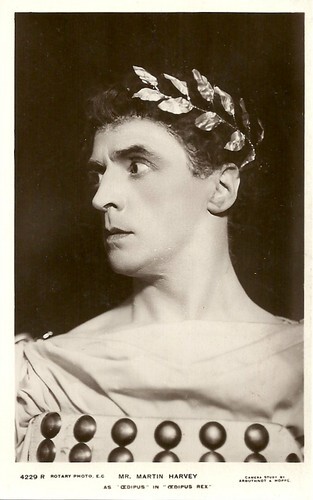
British postcard. Rotary Photo, E.C., No. 4229 R. Camera study by Arbuthnot & Hoppe. Martin Harvey as Oedipus in Oedipus Rex staged in Covent Garden, London, and opening January 1912. It was produced by Max Reinhardt and based on an adaptation of Sophocles' play by Gilbert Murray. Previously, Reinhardt had already staged a - successful - German version by Hugo von Hofmannsthal, opening in Vienna in 1910. Writer W.B. Yeats saw the London production and called it the most imaginative production of a play he ever saw.
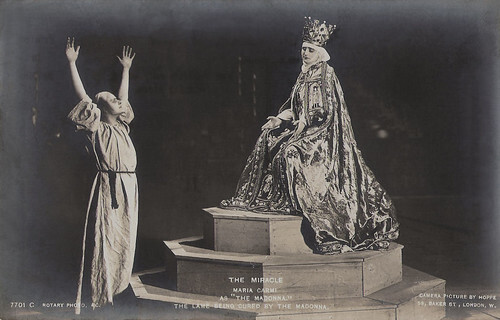
British postcard by Rotary Photo, no. 7701 C. Photo: Hoppe, London. Publicity still of the London stage production of 'Das Mirakel' (The Miracle) (1912) by Max Reinhardt with Maria Carmi as the Madonna. Here she has just cured the lame.
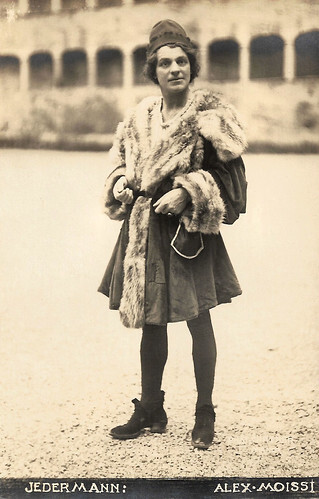
Austrian postcard by Traub, Salzburg. Photo: Atelier K. Hintner. Alexander Moissi as Jedermann in the stage production Jedermann (Everyman) at the Salzburger Festspiele. Max Reinhardt directed Moissi in this production in 1919 and 1920 and from 1926 till 1931.
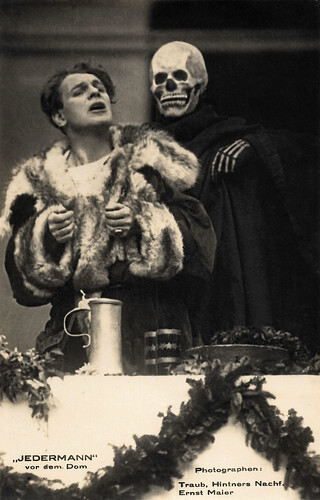
Austrian postcard by Traub, Salzburg. Photo: Ernst Maier (Atelier K. Hintner). Alexander Moissi as Jedermann in the stage production Jedermann (Everyman) at the Salzburger Festspiele. Max Reinhardt directed Moissi in this production in 1919 and 1920 and from 1926 till 1931. Caption: Everyman in front of the cathedral.
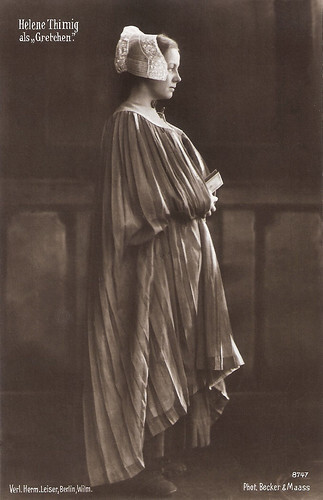
German postcard by Verlag Herm. Leiser, Berlin-Wilm., no. 8747. Photo: Becker & Maass. Helene Thimig as Gretchen in Reinhardt's stage production of Goethe's Faust (1920).
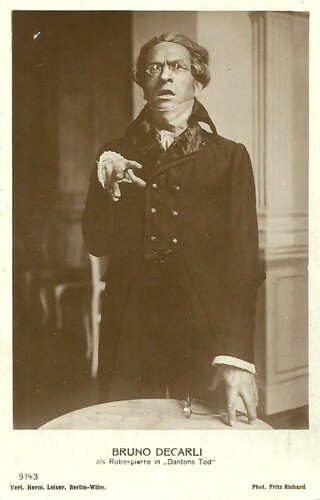
German postcard by Verlag Hermann Leiser, Berlin, no. 9143. Photo: Fritz Richard. Bruno Decarli as Robespierre in the play 'Dantons Tod' (Danton's Death) by Georg Büchner.
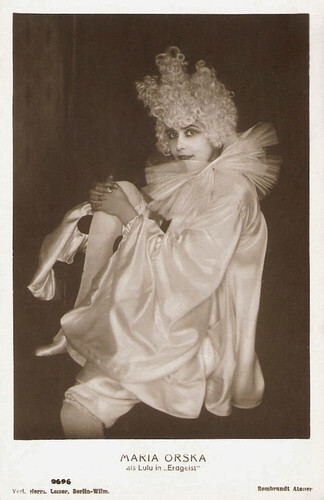
German postcard by Verlag Hermann Leiser, Berlin-Wilm., no. 9696. Photo: Rembrandt Arelier. Maria Orska in her role as Lulu in the stage play Erdgeist (Earth Spirit) by Franz Wedekind directed in 1916 by Max Reinhardt.
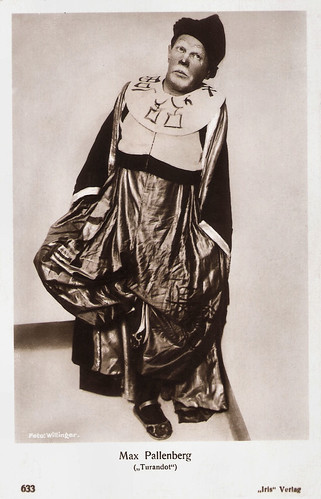
Austrian postcard by Iris Verlag, no. 633. Photo: Laszlo Willinger. Under the direction of Max Reinhardt, Max Pallenberg played Traffaldino in 'Turandot' (1926) by Giacomo Puccini at the Salzburger Festspiele.
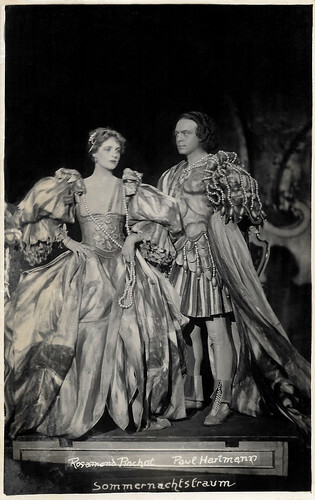
German postcard by Wellington. Photo: Eilinger, Salzburg. Rosamond Pinchot as Hippolyta and Paul Hartmann as Theseus in 'Ein Sommernachtstraum' (A Midsummernight's Dream) by William Shakespeare. This photo was taken for the stage production at the Salzburger Festspiele in 1927, directed by Max Reinhardt.
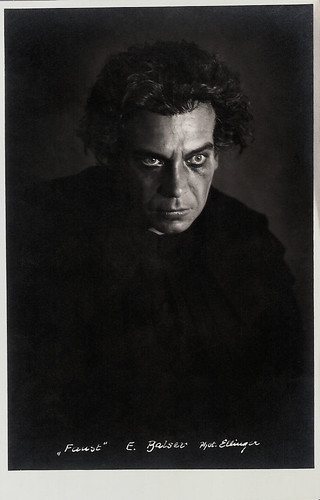
Vintage postcard by L&O, no. 65359. Photo: Ellinger. Ewald Balser as Faust in the stage play 'Faust' (1937) by Johann Wolfgang von Goethe directed by Max Reinhardt at the Salzburger Festspiele.
Sources: Hovahnness Israel Pilikian (Encyclopaedia Britannica), (IMDb), Salzburg Stumbling Blocks, Wikipedia, and .

German postcard by Verlag Hermann Leiser, Berlin, no. 8615. Photo: Hofphot. E. Bieber, Hamburg. Collection: Didier Hanson.

German postcard by Jos Paul Böhm, München, no. 32. Photo: Jos Paul Böhm, München. Eduard von Winterstein , Oscar Beregi , and Else Heims in the play 'Sommernachtstraum', Max Reinhardt's staging of Shakespeare's 'Midsummer Night's Dream'. It was first staged by Reinhardt in 1905.

German postcard by Photo und Kunstverlag Jos. Paul Böhm, München, no. 3061. Photo: publicity still for Sumurun (Max Reinhardt, 1910) with at right Richard Grossman as the old woman. But who is the man left, Henrick? Richard Grossman played 'Die alte' (the old woman) in Max Reinhardt's first film, Sumurun (1910), based on a Pantomime by Friedrich Freksa. Perhaps this photo was made for Reinhardt's stage production, 'Sumurun' (1909) at the Kammerspielen des Deutsches Theaters. Grete Wiesenthal played the lead as Sumurun and she would repeat her role in the 1910 film version. Leopoldine Konstantin played the dancer both on stage as in the 1910 film. However, of the four main male actors - Alexander Moissi (as Nur Al Din), Rudolf Schildkraut, Paul Wegener (as the old Sheik) and Eduard von Winterstein (as his son) - only Von Winterstein returned in Reinhardt's film version, but now in the role of the old Sheik. And Wegener would return as the old Sheik in the 1920 film version of Sumurun by Ernst Lubitsch.

German postcard by Verlag Hermann Leiser, no. 4553a, Berlin. Photo: Zander & Labisch, Berlin. Caption: King Oedipus. Paul Wegener in 'Oedipus Rex', Sophocles's classic tragedy, directed by Max Reinhardt in a translation by Hugo von Hofmannsthal, first performed in 1910, first in a Summer festival in Munich and in the Fall in a circus arena Berlin. Stars were Paul Wegener as Oedipus and Tilla Durieux as Jocasta, though some considered the masses of extras performing the Thebans to be the real stars. Emily Bilski, in Berlin Metropolis: Jews and the New Culture, 1890-1918, writes: "Oedipus was the first major theater-in-the-round production in modern times that featured masses of actors performing for a mass audience."

German postcard by Verlag Hermann Leiser, Berlin, no. 8579. Photo: Becker & Maass. Maria Carmi as the Madonna in Das Mirakel/The Miracle (Cherry Kearton, Max Reinhardt, 1912).

German postcard by Verlag Hermann Leiser, Berlin, no. 8614, 1916. Photo: Hofphot. E. Bieber, Hamburg. Collection: Didier Hanson.
His early landmark of genius
Max Reinhardt was born Maximilian Goldmann in 1873 in the spa town of Baden near Vienna where his parents were spa guests. He was the oldest of seven children of Wilhelm Goldmann, a Jewish merchant from Stupava, Hungary, and his wife Rachel Lea Rosi "Rosa" Goldmann (née Wengraf). Wilhelm was a corset maker and the family – officially Reinhardt after 1904 – lived in Vienna, the capital and residential city of the Austro-Hungarian monarchy, where they belonged to the organised Jewish Community of Vienna.
As a boy, Max haunted the Hofburg Theater and tried to see every play. Having finished school, he began an apprenticeship at a bank but already took acting lessons at the Sulkowsky Theater in Matzleinsdorf. In 1890, he gave his debut on a private stage in Vienna with the stage name Max Reinhardt, possibly after the protagonist Reinhard Werner in Theodor Storm's novella 'Immensee'. In 1893 he performed at the re-opened Salzburg City Theatre. One year later, Reinhardt relocated to Germany, joining the Deutsches Theater ensemble in Berlin under director Otto Brahm, who had brought the drama of Henrik Ibsen to Germany. In Berlin, Max achieved great success as an actor and director.
In 1901, Reinhardt together with Friedrich Kayßler and several other young artists created a lighthearted revue, 'Schall und Rauch' (Sound and Smoke), to which Reinhardt contributed sketches. Playing before invited audiences, it was so successful that it was transformed into a serious work and settled into the Kleines Theater (Little Theatre) in 1902. Reinhardt planned a full season and directed his first play, Oscar Wilde’s 'Salomé'. It was the first of numerous stages.
From 1903 to 1905, he managed the Neues Theater (present-day Theater am Schiffbauerdamm). By the end of 1904, he had directed 42 plays. William McPeak at IMDb : "These were all a part of his evolving philosophy of the harmony of stage design, costumes, language, music, and choreography as a whole unified artwork, Gesamtkunstwerk. He was influenced by several figures, August Strindberg for one, but most significantly by Richard Wagner and his operatic ideal that the director must pull together all aspects of art in his production. Reinhardt's infusion gave new dimensions to German theater."
His early landmark of genius was the production in 1905 of William Shakespeare’s 'A Midsummer Night’s Dream' with a wooded forest revolving stage - turning to reveal progressive new scenes. He became famous for the realistic direction of huge crowd scenes. Hovahnness Israel Pilikian at Encyclopaedia Britannica: "Reinhardt’s staging was swift, light, and joyous, capturing for audiences the theatrical brilliance that had been buried for so long beneath productions devoted to a ponderous, reverent delivery of Shakespeare’s words."
In 1906, he acquired the Deutsches Theater (German Theatre) and placated Brahm, who was furious over his breach of contract. At age 32, Reinhardt had reached the pinnacle of his profession. He completely rebuilt the German theatre, introducing the latest technological innovations in scenic design, and started a school. Purchasing a tavern next door, Reinhardt remodeled it into a small theatre for plays that needed intimacy with the audience. He summarised his new concept in theatre with the word 'Kammerspiele', chamber plays. William McPeak at IMDb : " This all opened Reinhardt to even more experimental ideas in staging with sometimes nightmarish and vivid lighting techniques. He began introducing the expressionist plays to the German-speaking public. "
In 1911, Max Reinhardt premiered with Karl Vollmöller's 'The Miracle' in Olympia, London, gaining an international reputation. It was Reinhardt’s most spectacular work and, at the same time, probably the most characteristic. Reinhardt was fascinated by the emotional richness of Roman Catholic rites and Gregorian chants. His production of 'The Miracle' involved more than 2,000 actors, musicians, dancers, and other personnel. Hovahnness Israel Pilikian at Encyclopaedia Britannica: "Performed without dramatic dialogue, it was a modern-day reunification of drama and ritual. It was pure theatre in the most archetypal sense."
From 1915 to 1918, Reinhardt also worked as director of the Volksbühne theatre and after World War I, he re-opened the Großes Schauspielhaus (after World War II renamed into Friedrichstadtpalast) in 1919, following its expressionist conversion by Hans Poelzig. In 1919 he opened an enormous arena theatre, the 'Grosses Schauspielhaus' (Great Playhouse), but known as the 'Theatre of the Five Thousand', which included a large revolving stage. Many of his biggest productions were done here, including Shakespeare and Greek plays. In the 1920s he built the two Boulevard Theaters on the Kurfürstendamm in Berlin. By 1930, he ran eleven stages in Berlin and, in addition, managed the Theater in der Josefstadt in Vienna from 1924 to 1933.
In 1920, Reinhardt established the Salzburg Festival with composer Richard Strauss and playwright Hugo von Hofmannsthal, notably directing an annual production of the morality play 'Jedermann'(Everyman) in which God sends Death to summon a representative of mankind for judgment. He staged the play in the city’s cathedral square. With Reinhardt’s support, the Salzburg Festival became an annual event, bringing about a new interest in the dramas of the Middle Ages from which Jedermann was adapted. Alexander Moissi played the role of Everyman in seven Festival summers – until his last performance on 30 August 1931. Although Moissi was, in fact, a baptised Christian, his name struck Antisemites as Jewish, and "Moissi the Jew" was subjected to a nasty campaign of character assassination by Salzburg Antisemites and Nazis who demanded that Festival president Baron Puthon refuse to involve the star of the Reinhardt ensembles in Berlin, Vienna and Salzburg in the 1932 season. When Moissi refused to play the role of Everyman if he was otherwise excluded, the Festival replaced him.
Reinhardt staged fourteen plays in the Festival city: 'Jedermann'(Everyman), 'The Great World Theater of Salzburg', 'The Hypochondriac', Das Mirakel (The Miracle), 'The Green Flute', 'Turandot', 'Servant of Two Masters', William Shakespeare's 'A Midsummer's Night Dream', 'Love and Intrigue', 'The Thief', 'Victoria', 'The Difficult', 'Stella' and finally 'Faust' in 1933. Mephisto was played by Max Pallenberg , a member of Reinhardt's ensemble at the German Theatre, whose Salzburg Festival roles also included The devil in 'Jedermann'(Everyman), Argan in 'The Hypochondriac', and Truffaldino in 'Turandot'. Pallenberg also had to leave the place of his triumphs, Berlin, in 1933.
In the United States, Max Reinhardt also successfully directed 'The Miracle' in 1924 and a popular stage version of 'A Midsummer Night's Dream' in 1927. By employing powerful staging techniques, and integrating stage design, language, music and choreography, Reinhardt introduced new dimensions into German theatre. He founded the drama schools Hochschule für Schauspielkunst 'Ernst Busch' in Berlin and the Max Reinhardt Seminar in Vienna, which is arguably the most important German-language acting school. Many alumni of these schools made their careers in film.
In 1918 Reinhardt purchased the castle Schloss Leopoldskron in Salzburg, formerly a summer palace of Salzburg's rulers, the Prince-Archbishops, which had fallen into disrepair. While living in it for nearly 20 years, he painstakingly restored the castle. He had to flee due to the Nazis' increasing anti-Semitic aggressions. The castle was seized following Germany's Anschluss annexation of Austria in 1938. After the war, the castle was restored to Reinhardt's heirs, and subsequently, the home and grounds became famous as the filming site for the early scenes of the Von Trapp family gardens in the film The Sound of Music.

German postcard by Verlag Hermann Leiser, Berlin-Wilm., no. 1957. Eduard von Winterstein as Faust in 'Faust' directed by Max Reinhardt (1913-1916).

German postcard by Verlag Hermann Leiser, Berlin-Wilm., no. 3008. Photo: Nicola Perscheid. Else Eckersberg as countess Liszka and Johannes Riemann in the play 'Fasching' (Farsang; Fashions for Men) by Ferenc Molnar, directed by Max Reinhardt at the Deutsches Theater in 1917. Sent by mail in 1917.

German postcard by Verlag Hermann Leiser, no. 4310. Photo: Becker & Maass. Collection: Didier Hanson. Leopoldine Konstantin in Sumurun (Max Reinhardt, 1910).

German postcard by Verlag Hermann Leiser, Berlin, no. 4552. Photo: Becker & Maass. Caption: Paul Wegener as King Oedipus.

German postcard by Verleih Hermann Leiser, Berlin-Wilmersdorf, no. 7758. Maria Carmi in Das Mirakel/The Miracle (Cherry Kearton, Max Reinhardt, 1912). Collection: Didier Hanson.

German postcard by Herm. Leiser, Berlin-Wilm., no. 8756. Photo: Becker & Maass. Fritz Delius as Romeo in 'Romeo and Juliet' by William Shakespeare, probably under the direction of Max Reinhardt, ca. 1913.

German postcard by Herm. Leiser, Berlin-Wilm., no. 8760. Photo: Becker & Maass. Fritz Delius as Ferdinand in a 1917 stage production of Friedrich Schiller's 'Kabale und Liebe' (Intrigue and Love), under the direction of Max Reinhardt.

German postcard by Verlag Hermann Leiser, Berlin-Wilm., no. 9491. Photo: Becker & Maass, Berlin. Maria Fein in the title role of Friedrich Schiller's 'Maria Stuart' (Mary Stuart) in a performance at the German Theater in Berlin, 1916.
A feast for starving souls
Max Reinhardt took a greater interest in the film than most of his contemporaries in the theatre world. He made films as a director and from time to time also as a producer. His first staging was the film Sumurûn (1910). After that, Reinhardt founded his own film company.
He sold the film rights for the film adaptation of the play Das Mirakel/The Miracle to Joseph Menchen, whose full-colour film, The Miracle (1912), gained worldwide success. Controversies around the staging of Das Mirakel, which was shown in the Vienna Rotunde in 1912, led to Reinhardt's retreat from the project. The author of the play, Reinhardt's friend and confidant Karl Gustav Vollmoeller, had French director Michel Carré finish the shooting.
Reinhardt made two films, Die Insel der Seligen/Isle of the Blessed (1913) and Eine venezianische Nacht/Venetian Nights (1914), under a four-picture contract for the German film producer Paul Davidson. Both films demanded much of cameraman Karl Freund because of Reinhardt's special shooting needs, such as filming a lagoon in the moonlight.
Die Insel der Seligen/Isle of the Blessed attracted attention due to its erotic nature. Its ancient mythical setting included sea gods, nymphs, and fauns, and the actors appeared naked. However, the film also fit in with the strict customs of the late German and Austrian empires. The actors had to live up to the demands of double roles. Wilhelm Diegelmann and Willy Prager played the bourgeois fathers as well as the sea gods, Ernst Matray a bachelor and a faun, Leopoldine Konstantin the Circe.
The shooting for Eine venezianische Nacht/Venetian Nights by Karl Gustav Vollmoeller took place in Venice. Maria Carmi played the bride, Alfred Abel the young stranger, and Ernst Matray Anselmus and Pipistrello. The shooting was disturbed by a fanatic who incited the attendant Venetians against the German-speaking staff. Both films received negative reviews from the press and the public. The other two films called for in the contract were never made.
At the end of August 1934, Max Reinhardt traveled to the US for the first time since the 1920s and in 1935 he began the process of gaining American citizenship in Los Angeles – where his two sons Wolfgang and Gottfried Reinhardt, lived with their mother, his first wife, actress Else Heims. After many difficulties gaining divorces for the two of them, he was finally able to marry his long-term lover and partner the actress Helene Thimig in Reno, Nevada, in June 1935.
In 1935, Reinhardt directed his first film in Hollywood, a film version of A Midsummer Night's Dream. He used a cast that included James Cagney , Mickey Rooney , Joe E. Brown, and Olivia de Havilland . Mickey Rooney and Olivia de Havilland had also appeared in Reinhardt's 1934 stage production, which was staged at the Hollywood Bowl. The Nazis banned the film because of the Jewish ancestry of both Reinhardt and Felix Mendelssohn, whose music (arranged by Erich Wolfgang Korngold) was used throughout the film.
William McPeak at IMDb : "Shakespeare's lines were cut for public consumption, but there was so much to see - who would notice. In Depression-era America, the movie theater had taken the place of Reinhardt's all-encompassing theater as a haven - and that was certainly fine with him. And here was a feast for starving souls. Reinhardt's multi-faceted approach to theater shone in all its entertaining best-through Warner stage design efficiency. There was the realist extravagance in forested backdrops, but the wonderful ballet of the coming of night with dancer Nini Theilade was distilled expressionism. Other ballet sequences featuring the fairies-children and adults - were choreographed by Bronislava Nijinska (the great Nijinsky's sister). Reinhardt conjured all his and the camera's magic to create the summation of a lifetime of stagecraft."
After the Anschluss of Austria to Nazi-governed Germany in 1938, he emigrated first to Britain, then to the United States. Reinhardt opened the Reinhardt School of the Theatre in Hollywood, on Sunset Boulevard. Several notable stars of the day received classical theatre training, among them actress Nanette Fabray. In 1940, he became a naturalised citizen of the United States. At that time, he was married to his second wife, actress Helene Thimig , daughter of actor Hugo Thimig. His staging of 'Everyman' in modern dress was followed by an unrealised plan for an all-black production of it. The final years of his life were filled with lesser fortunes and poor health, and he died speechless. Max Reinhardt died of a stroke in New York City in 1943 and is interred at Westchester Hills Cemetery in Hastings-on-Hudson, Westchester County, New York. He was 70 years old.
Max Reinhardt had inspired a whole generation of theatre and film directors including F.W. Murnau, Paul Leni, Ernst Lubitsch , William Dieterle, and Otto Preminger. They spread his word to the rest of the world. Reinhardt's papers and literary estate are housed at Binghamton University (SUNY), in the Max Reinhardt Archives and Library. His sons by first wife Else Heims (m. 1910–1935), Wolfgang and Gottfried Reinhardt, were well-regarded film producers. One of his grandsons (by adoption), Stephen Reinhardt, was a labor lawyer who served notably on the United States Court of Appeals for the Ninth Circuit from his appointment by Jimmy Carter in 1980 until his death in 2018. Another grandson, Michael Reinhardt, is a successful fashion photographer. In 2015 his granddaughter Jelena Ulrike Reinhardt was appointed as researcher at the University of Perugia in German literature.

British postcard. Rotary Photo, E.C., No. 4229 R. Camera study by Arbuthnot & Hoppe. Martin Harvey as Oedipus in Oedipus Rex staged in Covent Garden, London, and opening January 1912. It was produced by Max Reinhardt and based on an adaptation of Sophocles' play by Gilbert Murray. Previously, Reinhardt had already staged a - successful - German version by Hugo von Hofmannsthal, opening in Vienna in 1910. Writer W.B. Yeats saw the London production and called it the most imaginative production of a play he ever saw.

British postcard by Rotary Photo, no. 7701 C. Photo: Hoppe, London. Publicity still of the London stage production of 'Das Mirakel' (The Miracle) (1912) by Max Reinhardt with Maria Carmi as the Madonna. Here she has just cured the lame.

Austrian postcard by Traub, Salzburg. Photo: Atelier K. Hintner. Alexander Moissi as Jedermann in the stage production Jedermann (Everyman) at the Salzburger Festspiele. Max Reinhardt directed Moissi in this production in 1919 and 1920 and from 1926 till 1931.

Austrian postcard by Traub, Salzburg. Photo: Ernst Maier (Atelier K. Hintner). Alexander Moissi as Jedermann in the stage production Jedermann (Everyman) at the Salzburger Festspiele. Max Reinhardt directed Moissi in this production in 1919 and 1920 and from 1926 till 1931. Caption: Everyman in front of the cathedral.

German postcard by Verlag Herm. Leiser, Berlin-Wilm., no. 8747. Photo: Becker & Maass. Helene Thimig as Gretchen in Reinhardt's stage production of Goethe's Faust (1920).

German postcard by Verlag Hermann Leiser, Berlin, no. 9143. Photo: Fritz Richard. Bruno Decarli as Robespierre in the play 'Dantons Tod' (Danton's Death) by Georg Büchner.

German postcard by Verlag Hermann Leiser, Berlin-Wilm., no. 9696. Photo: Rembrandt Arelier. Maria Orska in her role as Lulu in the stage play Erdgeist (Earth Spirit) by Franz Wedekind directed in 1916 by Max Reinhardt.

Austrian postcard by Iris Verlag, no. 633. Photo: Laszlo Willinger. Under the direction of Max Reinhardt, Max Pallenberg played Traffaldino in 'Turandot' (1926) by Giacomo Puccini at the Salzburger Festspiele.

German postcard by Wellington. Photo: Eilinger, Salzburg. Rosamond Pinchot as Hippolyta and Paul Hartmann as Theseus in 'Ein Sommernachtstraum' (A Midsummernight's Dream) by William Shakespeare. This photo was taken for the stage production at the Salzburger Festspiele in 1927, directed by Max Reinhardt.

Vintage postcard by L&O, no. 65359. Photo: Ellinger. Ewald Balser as Faust in the stage play 'Faust' (1937) by Johann Wolfgang von Goethe directed by Max Reinhardt at the Salzburger Festspiele.
Sources: Hovahnness Israel Pilikian (Encyclopaedia Britannica), (IMDb), Salzburg Stumbling Blocks, Wikipedia, and .
Published on January 22, 2022 15:29
January 21, 2022
The Early Silent Comedians: France
This month, EFSP presents three posts by Ivo Blom on early comedy in three countries. Last week we had a post on Italian comedians, and next week we'll host the American silent comedians. But today, we'll focus on France which produced the first major comedy star, André Deed, but also the diminutive Little Moritz, the stout Rosalie (Sarah Duhamel), and of course Max Linder.
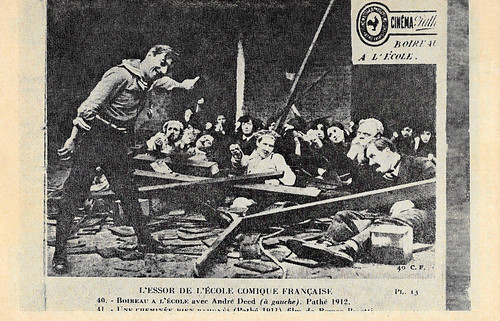
French postcard by Sadag de France, Imp., Paris, no. 40. Photo: Pathé Frères. André Deed in Boireau à l'école/Boireau at school (André Deed, 1912).
André Deed (1879-1940) was one the most popular comedians in French and Italian silent cinema under the names of Boireau and Cretinetti. In 1901 he did his first steps in the film world in supporting roles, working for film pioneer Georges Méliès. In 1906 he started his own series of short comedies at Pathé Frères, around a comic character designed by himself: Boireau, a small grotesque figure, grinning demonically. The characteristic form of his films cast him in some metier - boxer, gendarme, or concierge - which would permit him to precipitate an orgy of chaos or destruction. Between 1906 and 1908 he made some 27 films for Pathé, directed by pioneer filmmakers like Georges Hathot and Georges Monca, though of several films no director is known.
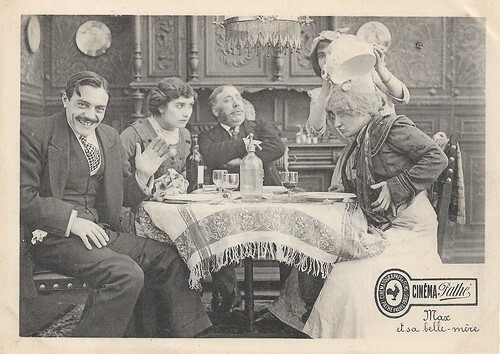
Large-format vintage collectors card from an album of Pathé Frères films with publicity stills, dating 1911. Photo: Pathé. Max Linder and Paquerette or Olga Demidoff as the mother-in-law in Max et sa belle-mère/Max and His Mother-In-Law (Max Linder, 1911). The man in the back is Jacques Vandenne and the young woman right of Linder may be Paulette Lorsy, playing his wife.
French comedian Max Linder (1883-1925), with his trademark silk hat, stick and moustache was an influential pioneer of silent film. In 1909, when André Deed was lured away from Pathé by Itala, Pathé found an instant replacement in Max Linder. While Deed was grotesque and absurd, Max was handsome, neat, and elegant. The essence of his comedy was the contrast between this impeccable man-about-town and the grotesque incidents which befell him. Linder became largely responsible for the creation of the classic style of silent slapstick comedy and he was the highest-paid entertainer of his day.
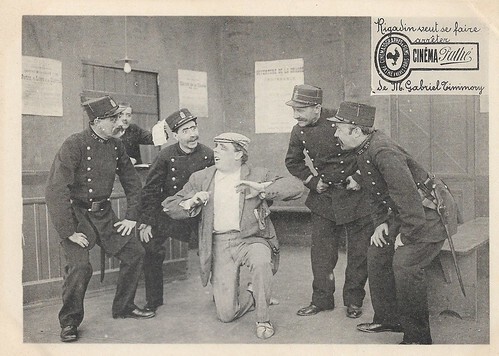
Large-format vintage collectors card from an album of Pathé Frères films with publicity stills, dating 1911. Photo: S.C.A.G.L. / Pathé. Charles Prince in Rigadin veut se faire arrêter/Rigadin wants to be arrested (Georges Monca, 1911). Scripted by Gabriel Timmory, the film was based on Lapurée veut se faire arrêter/Hard to Get Arrested (N.N., 1908), in which a tramp eats without paying thus hoping to get food and lodging at the police station. Yet, he manages to get away with it. When he suddenly gets money and orders a huge meal, the restaurant owner warns the police, and our poor bum is arrested after all.
Another Pathé star, moon-faced Charles Prince (1872-1933), aka just ‘Prince’, was a comic actor rather than a clown. He was famous for his countless comical shorts with his alter ego Rigadin. Tramps and hobos figured large in the popular imagination at the turn of the 20th Century. These familiar real-life figures combined the potent appeal of romance, menace, and pathos.
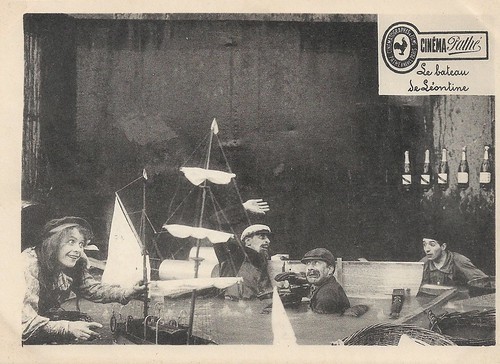
Large-format vintage collectors card from an album of Pathé Frères films with publicity stills, dating 1911. Photo: Pathé Frères. Publicity still for Le bateau de Léontine/Betty's Boat (N.N., 1911). It is still unclear who the actress is who played in the typical nasty lady series of Léontine, a girl always into terrible mischief.
Léontine has received for her party a superb three-master. She has promised her parents to be very good in their absence, but she cannot resist the temptation to have her boat sailing. She turns the kitchen faucets wide-open, so the room serves as a pool to her exploits. Soon the ship is sailing in the 'open sea', but Titine is still dissatisfied. However, the water, crossing the floor, flows in large streams onto the lower floors, drowning the tenants, and transforming the stairs into impassable torrents. Titine, unsuspecting of the dramas that take place below her, quietly floats in a barrel amidst the disaster.
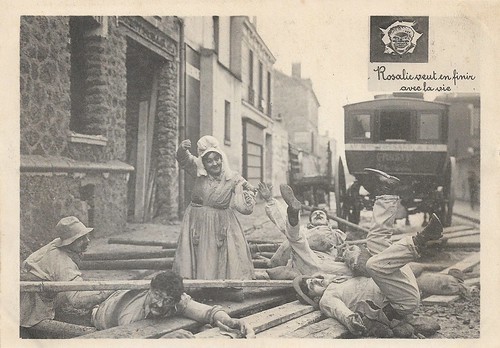
Large format vintage collectors card from an album of Pathé Frères films with publicity stills, dating 1911. Photo: Pathé Frères / Comica. Sarah Duhamel as Rosalie in Rosalie veut en finir avec la vie/Rosalie wants to end her life (Romeo Bosetti, 1911).
Rosalie is fired, so she wants to commit suicide. She shoots herself with a revolver but only destroys the mirror. She throws herself on the tramway rails, but, alas, this one takes another track. She throws herself from a parapet but in vain. Desperate, she goes into a gunshop, throws a bomb, and mounts to heaven but is only to cause her to descend again. She falls in the arms of a well-mustached police officer, so Rosalie gets lust for life again.
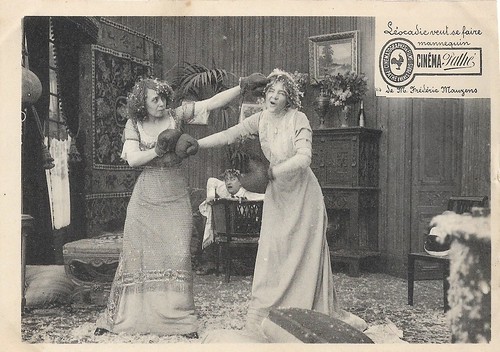
Large format vintage collectors card from an album of Pathé Frères films with publicity stills, dating 1911. Photo: S.C.A.G.L. / Pathé. Mistinguett and Juliette Clarens in Léocadie veut se faire mannequin/Leocadia Wishes to Be Fashion-model (Frédéric Mauzens (unconfirmed), 1911).
Uncle Dufond wants to marry his nephew Onésime to a charming widow, Boxing Clorinde. But Onésime, prey to a fatal love, formally repels the offer of his uncle who threatens to cut off his food and ruthlessly chases away his girlfriend, the young Léocadie. She soon finds a job as a model and has just started in her new job, when the boy of her janitor comes to warn that Onésime is drowning in his tub, out of despair. Listening only to her heart, Leocadie flies to his aid without worrying about the elegant dress she wears, which is precisely the one the rich Boxing Clorinde has selected. The fashion designer, the client, and the model are all at Léocadie's, where Onésime, recalled to life by their good care, escapes only with difficulty to the fury of the two rivals. In the end, Léocadie, who triumphs as mistress of the battlefield, chases the uncle and his dangerous protegee.
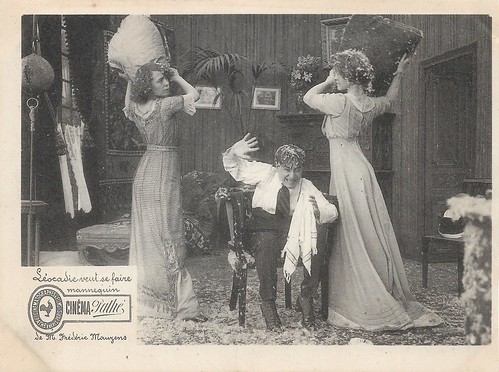
Large format vintage collectors card from an album of Pathé Frères films with publicity stills, dating 1911. Photo: S.C.A.G.L. / Pathé. Mistinguett and Juliette Clarens in Léocadie veut se faire mannequin/Leocadia Wishes to Be Fashion-model (Frédéric Mauzens (unconfirmed), 1911).
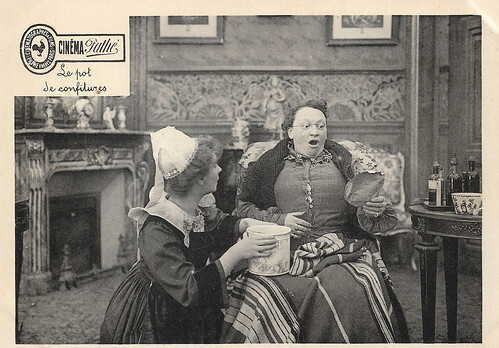
Large-format vintage collectors card from an album of Pathé Frères films with publicity stills, dating 1911. Photo: S.C.A.G.L. Madeleine Guitty in Le Pot de confitures/The Jam Jar (Georges Denola, 1911).
French actress Madeleine Guitty (1870-1936) began her artistic career in the theatre and appeared in more than 80 films from 1909 to 1936. It was Louis Feuillade who discovered her and had her make several short films. Among her favourite roles: maids, cooks, fishmongers, and fairground owners. She made her mark in 1922 in Henri Desfontaines' La Fille des chiffonniers.
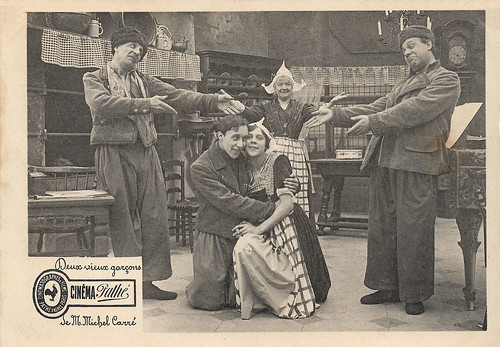
Large-format vintage collectors card from an album of Pathé Frères films with publicity stills, dating 1911. Photo: S.C.A.G.L. Andrée Marly in Deux vieux garçons/Two old boys (Michel Carré, 1911). Marly is kneeling in the middle. Her lover is played by Charles Maudru. The two old men, courting young Katje in vain, and finally giving in, are Louis Baron fils and Georges Coquet. The woman in the back is Marie Ernestine Desclauzas. In real life, Marly was married to Coquet. The setting and costumes in this film refer to the popular Dutch village of Volendam.
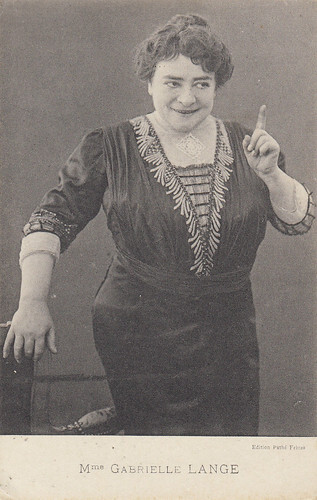
French postcard by Editions Pathé Frères. Collection: Marlene Pilaete.
Before she passed away in 1914, French Gabrielle Lange was a very popular actress in countless short comedies by Pathé Frères. She often played opposite Max Linder and Charles Prince.
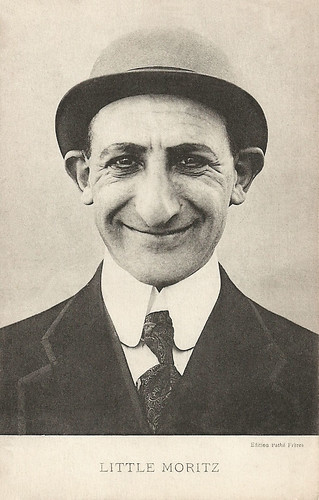
French postcard by Edition Pathé Frères.
Maurice Schwartz (1890-1960) was an international popular Pathé comedian in 1910-1912, known as Little Moritz . He came from the German music hall and worked for Pathé's Comica studio in Nice, where Romeo Bosetti directed some 30 comedies with Little Moritz. Sarah Duhamel was often his partner as 'Rosalie'. He is not to be confused with Yiddish actor Maurice Schwartz, according to the site Nitrateville. Fondation Seydoux-Pathé lists 30 titles with Schwartz between November 1910 and December 1912, while the first Little Moritz comedies started in September 1911.
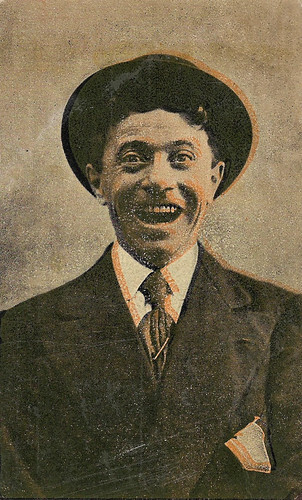
Spanish collectors card by Amatller Marca Luna, series 1, no. 18.
In 1908 Paul Bertho (?-?) debuted in the Pathé comedy Calino a mangé du cheval/Result of Eating Horse Flesh (Romeo Bosetti, 1908), but then shifted to the company Lux, where he would become famous as the character Patouillard, known in the US as Bill. Bosetti continued to direct him in some 70 Patouillard comedies at Lux in 1910-1912. In 1910, Bertho briefly played the comic character of Cri-Cri at Eclipse, while in 1911 he did a handful of Calino comedies at Pathé. In 1912 Bosetti and Bertho moved to Eclair, where they created the character of Gavroche in some 50 comedies in 1912-1914. In some, Gavroche was united with Casimir (Lucien Bataille), in others with Pétronille (Sarah Duhamel). In 1914 Bertho also did a handful of Patouillard comedies again, directed by Bosetti. After 1914 Berto's career halted, apart from one Bosetti comedy, Patouillard et Lulu/Patouillard and Lulu (Romeo Bosetti, 1916).
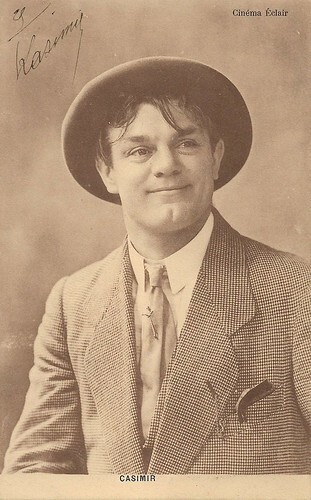
French postcard. Photo: Cinéma Eclair. Signed 'Kasimir'.
Casimir or Lucien Bataille (1877-1953) was one of the most popular comic characters at the French company Eclair in the early 1910s. He would often act together with Sarah Duhamel as Pétronille. Lucien Bataille played the comic characters of Zigoto and Casimir, under the direction of mostly Jean Durand and Roméo Bosetti. In 1911 Bataille started as the character Zigoto at the Gaumont film company, probably first in Zigoto et l'affaire du collier/Zigoto and the Affair of the Necklace (Jean Durand, 1911). After 30 short comedies as Zigoto in 1911-1912, Bataille moved to the company Eclair. There he continued his career as a comedian with the character Casimir. Between 1913 and 1916 he acted in some 30 Casimir comedies, often paired with Sarah Duhamel as Pétronille.
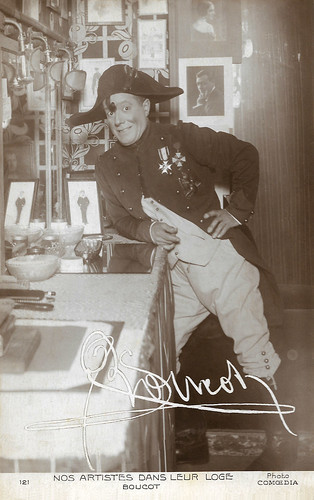
French postcard in the Nos artistes dans leur loge series, no. 121. Photo: Comoedia, Paris.
French stage and screen actor Louis-Jacques Boucot aka Boucot (1882-1949) was well-known for his comic characters of Pénard and Babylas. Just like the more famous Dranem, Boucot was known for his vivacity and grimaces. Boucot started acting at Pathé Frères in 1910, first in Une petite femme bien douce/A sweet little woman (Georges Denola, 1910), scripted and performed by Mistinguett. By 1911 he had his own comedies such as Ami trop entreprenant/Over-enterprising friend (1911) and La dame de compagnie/The lady-in-waiting (1911), while in the same year he also developed the popular comic character of Babylas in various shorts directed by Alfred Machin in 1911-1912. Sometimes, Machin's pet panther Mimir acted in these films too, such as Babylas vient d'hériter d'une panthère/Babylas has just inherited a panther (1911). In 1912 Boucot also developed another character, Pénard, with whom he made even more short comedies (16 films in 1912-13), all for Pathé. During the First World War, Boucot was only visible in one Babylas comedy, Babylas marraine/Babylas godmother (1917). After the war, he acted in only one film in the 1920s, La première idylle de Boucot/Boucot's first romance (Robert Saidreau, 1920). He returned to the screen when the sound film had set in.
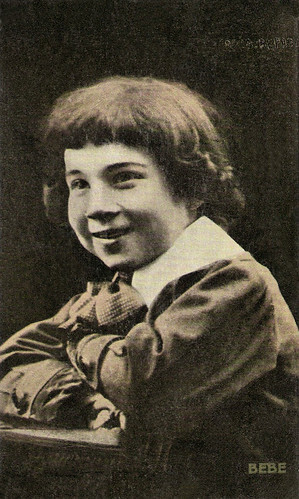
Spanish postcard in the Series Principales Artistas Cinematograficos, serie 1a, no. 29, by Chocolate Amattler Marca Luna.
Clément Mary (1905-1974) was Bébé the best-known child actor of the early 1910s. In 1910, director Louis Feuillade tested him and designed a whole series around him, the Bébé series. All in all, Mary would play in 74 Bébé comedies between 1910 and 1912. He would later act in French sound films as René Dary .
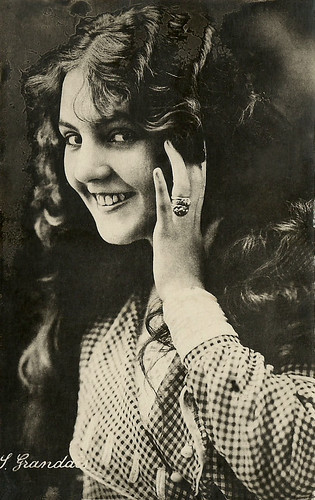
Vintage postcard. Collection: Didier Hanson.
Suzanne Grandais (1893-1920) is one of our favorite film stars. She was the most beautiful and sophisticated actress in the French silent cinema. Her nickname was 'the French Mary Pickford' because of her angel face. From 1911 till 1913, Grandais made some 45 films for Gaumont, mostly short comedies and dramas. Grandais often played Léonce Perret's wife or temptress in the Léonce series, elegant comedies starring and directed by Perret.
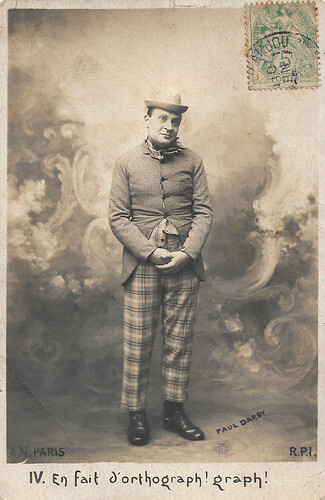
French postcard by A.N., Paris / R.P.I., no. 251. Photo: Paul Darby. Caption: IV. En fait d'ortograph! graph!
Dranem (1869-1935) was a French comic singer, music hall, stage, and film actor. Around 1900 he acted in many shorts by Pathé while he also performed in a large series of 'phonoscènes' by Gaumont, directed by Alice Guy in 1905. Other early films include Les souliers de Dranem/Dranem's shoes (Ferdinand Zecca, 1908), Dranem fait ressemeler ses ribouis/Dranem has his old shoes resealed (?, 1910), Le mariage de Dranem/Dranem's wedding (Ferdinand Zecca, 1912) and Dranem sténo-dactyle/Shorthand Typist Dranem (?, 1912), and the Molière adaptation Le médecin malgré lui/The doctor in spite of himself (?, 1913).
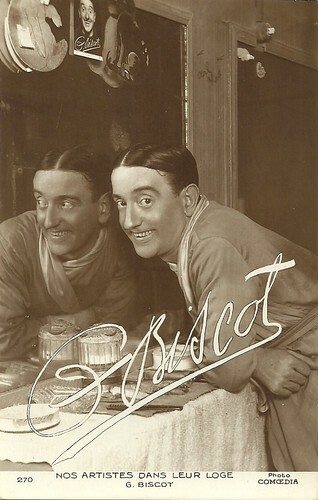
French postcard in the Nos artistes dans leur loge series by Editions La Fayette, no. 270.
Georges Biscot (1886-1945) was a popular French music hall and revue singer and actor, who also knew a career in French silent and sound film. Biscot debuted on the silver screen in 1913 in filmed songs, produced by Georges Lordier. Soon he became a star of the music-hall of the Folies-Bergères, in particular when acting in 'La revue galante' (1914) next to Musidora, then in 'À la parisienne' (1916) where he did an imitation of Chaplin. In the same year, he returned to film in the crime serial parody Le pied qui étreint/The Clutching Foot (1916) by Jacques Feyder. Impressed by his comic talent, Feyder recommended Biscot to Louis Feuillade, who used him in the serials Vendémiaire (Louis Feuillade, 1918) with René Cresté, and Tih Minh/In the Clutches of the Hindu (Louis Feuillade, 1918) with Mary Harald, succeeding Marcel Lévesque in the parts of jocular characters. Subsequently, Biscot had notable comic parts in the serials Barrabas (Louis Feuillade, 1919) with Blanche Montel, and Les deux gamines/The Two Girls (Louis Feuillade, 1921) with Sandra Milovanoff.
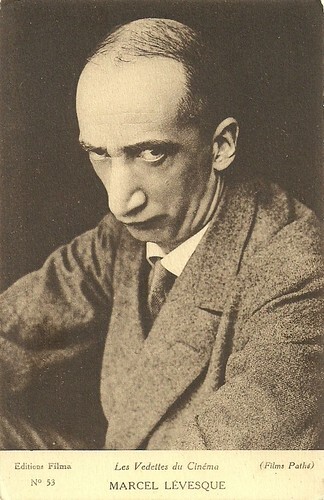
French postcard in the Les Vedettes du Cinéma series by Editions Filma, no. 53. Photo: Films Pathé.
Marcel Lévesque (1877-1962) was a French actor and scriptwriter who excelled in French silent and sound comedies but also played memorable parts in the crime serials by Feuillade and in Jean Renoir’s Le crime de M. Lange (1936). In 1913, he joined Gaumont where he met actor-director Léonce Perret for whom he wrote La belle-mère/The Stepmother (1913) with Suzanne Le Bret, followed by Léonce et Poupette (1913), which he scripted as well and in which he played Léonce’s manservant. He followed this with the lead in L’illustre Mâchefer/The Illustrious Clinker (1913), directed by Louis Feuillade, who would become his regular director between 1913 and 1918 and which whom he acted in almost 30 films plus some serials. Feuillade would have him play countless witty characters in the comedy series La vie drôle/Funny Life. Meanwhile, Marcel Lévesque had tried his luck at film direction at Gaumont with La pintade et le dindon/Guinea pig and fowl (1915) with Madeleine Guitty as his partner.
Sources: Richard Abel (Encyclopedia of Early Cinema), Fondation Seydoux-Pathé, Wikipedia (French), and IMDb.

French postcard by Sadag de France, Imp., Paris, no. 40. Photo: Pathé Frères. André Deed in Boireau à l'école/Boireau at school (André Deed, 1912).
André Deed (1879-1940) was one the most popular comedians in French and Italian silent cinema under the names of Boireau and Cretinetti. In 1901 he did his first steps in the film world in supporting roles, working for film pioneer Georges Méliès. In 1906 he started his own series of short comedies at Pathé Frères, around a comic character designed by himself: Boireau, a small grotesque figure, grinning demonically. The characteristic form of his films cast him in some metier - boxer, gendarme, or concierge - which would permit him to precipitate an orgy of chaos or destruction. Between 1906 and 1908 he made some 27 films for Pathé, directed by pioneer filmmakers like Georges Hathot and Georges Monca, though of several films no director is known.

Large-format vintage collectors card from an album of Pathé Frères films with publicity stills, dating 1911. Photo: Pathé. Max Linder and Paquerette or Olga Demidoff as the mother-in-law in Max et sa belle-mère/Max and His Mother-In-Law (Max Linder, 1911). The man in the back is Jacques Vandenne and the young woman right of Linder may be Paulette Lorsy, playing his wife.
French comedian Max Linder (1883-1925), with his trademark silk hat, stick and moustache was an influential pioneer of silent film. In 1909, when André Deed was lured away from Pathé by Itala, Pathé found an instant replacement in Max Linder. While Deed was grotesque and absurd, Max was handsome, neat, and elegant. The essence of his comedy was the contrast between this impeccable man-about-town and the grotesque incidents which befell him. Linder became largely responsible for the creation of the classic style of silent slapstick comedy and he was the highest-paid entertainer of his day.

Large-format vintage collectors card from an album of Pathé Frères films with publicity stills, dating 1911. Photo: S.C.A.G.L. / Pathé. Charles Prince in Rigadin veut se faire arrêter/Rigadin wants to be arrested (Georges Monca, 1911). Scripted by Gabriel Timmory, the film was based on Lapurée veut se faire arrêter/Hard to Get Arrested (N.N., 1908), in which a tramp eats without paying thus hoping to get food and lodging at the police station. Yet, he manages to get away with it. When he suddenly gets money and orders a huge meal, the restaurant owner warns the police, and our poor bum is arrested after all.
Another Pathé star, moon-faced Charles Prince (1872-1933), aka just ‘Prince’, was a comic actor rather than a clown. He was famous for his countless comical shorts with his alter ego Rigadin. Tramps and hobos figured large in the popular imagination at the turn of the 20th Century. These familiar real-life figures combined the potent appeal of romance, menace, and pathos.

Large-format vintage collectors card from an album of Pathé Frères films with publicity stills, dating 1911. Photo: Pathé Frères. Publicity still for Le bateau de Léontine/Betty's Boat (N.N., 1911). It is still unclear who the actress is who played in the typical nasty lady series of Léontine, a girl always into terrible mischief.
Léontine has received for her party a superb three-master. She has promised her parents to be very good in their absence, but she cannot resist the temptation to have her boat sailing. She turns the kitchen faucets wide-open, so the room serves as a pool to her exploits. Soon the ship is sailing in the 'open sea', but Titine is still dissatisfied. However, the water, crossing the floor, flows in large streams onto the lower floors, drowning the tenants, and transforming the stairs into impassable torrents. Titine, unsuspecting of the dramas that take place below her, quietly floats in a barrel amidst the disaster.

Large format vintage collectors card from an album of Pathé Frères films with publicity stills, dating 1911. Photo: Pathé Frères / Comica. Sarah Duhamel as Rosalie in Rosalie veut en finir avec la vie/Rosalie wants to end her life (Romeo Bosetti, 1911).
Rosalie is fired, so she wants to commit suicide. She shoots herself with a revolver but only destroys the mirror. She throws herself on the tramway rails, but, alas, this one takes another track. She throws herself from a parapet but in vain. Desperate, she goes into a gunshop, throws a bomb, and mounts to heaven but is only to cause her to descend again. She falls in the arms of a well-mustached police officer, so Rosalie gets lust for life again.

Large format vintage collectors card from an album of Pathé Frères films with publicity stills, dating 1911. Photo: S.C.A.G.L. / Pathé. Mistinguett and Juliette Clarens in Léocadie veut se faire mannequin/Leocadia Wishes to Be Fashion-model (Frédéric Mauzens (unconfirmed), 1911).
Uncle Dufond wants to marry his nephew Onésime to a charming widow, Boxing Clorinde. But Onésime, prey to a fatal love, formally repels the offer of his uncle who threatens to cut off his food and ruthlessly chases away his girlfriend, the young Léocadie. She soon finds a job as a model and has just started in her new job, when the boy of her janitor comes to warn that Onésime is drowning in his tub, out of despair. Listening only to her heart, Leocadie flies to his aid without worrying about the elegant dress she wears, which is precisely the one the rich Boxing Clorinde has selected. The fashion designer, the client, and the model are all at Léocadie's, where Onésime, recalled to life by their good care, escapes only with difficulty to the fury of the two rivals. In the end, Léocadie, who triumphs as mistress of the battlefield, chases the uncle and his dangerous protegee.

Large format vintage collectors card from an album of Pathé Frères films with publicity stills, dating 1911. Photo: S.C.A.G.L. / Pathé. Mistinguett and Juliette Clarens in Léocadie veut se faire mannequin/Leocadia Wishes to Be Fashion-model (Frédéric Mauzens (unconfirmed), 1911).

Large-format vintage collectors card from an album of Pathé Frères films with publicity stills, dating 1911. Photo: S.C.A.G.L. Madeleine Guitty in Le Pot de confitures/The Jam Jar (Georges Denola, 1911).
French actress Madeleine Guitty (1870-1936) began her artistic career in the theatre and appeared in more than 80 films from 1909 to 1936. It was Louis Feuillade who discovered her and had her make several short films. Among her favourite roles: maids, cooks, fishmongers, and fairground owners. She made her mark in 1922 in Henri Desfontaines' La Fille des chiffonniers.

Large-format vintage collectors card from an album of Pathé Frères films with publicity stills, dating 1911. Photo: S.C.A.G.L. Andrée Marly in Deux vieux garçons/Two old boys (Michel Carré, 1911). Marly is kneeling in the middle. Her lover is played by Charles Maudru. The two old men, courting young Katje in vain, and finally giving in, are Louis Baron fils and Georges Coquet. The woman in the back is Marie Ernestine Desclauzas. In real life, Marly was married to Coquet. The setting and costumes in this film refer to the popular Dutch village of Volendam.

French postcard by Editions Pathé Frères. Collection: Marlene Pilaete.
Before she passed away in 1914, French Gabrielle Lange was a very popular actress in countless short comedies by Pathé Frères. She often played opposite Max Linder and Charles Prince.

French postcard by Edition Pathé Frères.
Maurice Schwartz (1890-1960) was an international popular Pathé comedian in 1910-1912, known as Little Moritz . He came from the German music hall and worked for Pathé's Comica studio in Nice, where Romeo Bosetti directed some 30 comedies with Little Moritz. Sarah Duhamel was often his partner as 'Rosalie'. He is not to be confused with Yiddish actor Maurice Schwartz, according to the site Nitrateville. Fondation Seydoux-Pathé lists 30 titles with Schwartz between November 1910 and December 1912, while the first Little Moritz comedies started in September 1911.

Spanish collectors card by Amatller Marca Luna, series 1, no. 18.
In 1908 Paul Bertho (?-?) debuted in the Pathé comedy Calino a mangé du cheval/Result of Eating Horse Flesh (Romeo Bosetti, 1908), but then shifted to the company Lux, where he would become famous as the character Patouillard, known in the US as Bill. Bosetti continued to direct him in some 70 Patouillard comedies at Lux in 1910-1912. In 1910, Bertho briefly played the comic character of Cri-Cri at Eclipse, while in 1911 he did a handful of Calino comedies at Pathé. In 1912 Bosetti and Bertho moved to Eclair, where they created the character of Gavroche in some 50 comedies in 1912-1914. In some, Gavroche was united with Casimir (Lucien Bataille), in others with Pétronille (Sarah Duhamel). In 1914 Bertho also did a handful of Patouillard comedies again, directed by Bosetti. After 1914 Berto's career halted, apart from one Bosetti comedy, Patouillard et Lulu/Patouillard and Lulu (Romeo Bosetti, 1916).

French postcard. Photo: Cinéma Eclair. Signed 'Kasimir'.
Casimir or Lucien Bataille (1877-1953) was one of the most popular comic characters at the French company Eclair in the early 1910s. He would often act together with Sarah Duhamel as Pétronille. Lucien Bataille played the comic characters of Zigoto and Casimir, under the direction of mostly Jean Durand and Roméo Bosetti. In 1911 Bataille started as the character Zigoto at the Gaumont film company, probably first in Zigoto et l'affaire du collier/Zigoto and the Affair of the Necklace (Jean Durand, 1911). After 30 short comedies as Zigoto in 1911-1912, Bataille moved to the company Eclair. There he continued his career as a comedian with the character Casimir. Between 1913 and 1916 he acted in some 30 Casimir comedies, often paired with Sarah Duhamel as Pétronille.

French postcard in the Nos artistes dans leur loge series, no. 121. Photo: Comoedia, Paris.
French stage and screen actor Louis-Jacques Boucot aka Boucot (1882-1949) was well-known for his comic characters of Pénard and Babylas. Just like the more famous Dranem, Boucot was known for his vivacity and grimaces. Boucot started acting at Pathé Frères in 1910, first in Une petite femme bien douce/A sweet little woman (Georges Denola, 1910), scripted and performed by Mistinguett. By 1911 he had his own comedies such as Ami trop entreprenant/Over-enterprising friend (1911) and La dame de compagnie/The lady-in-waiting (1911), while in the same year he also developed the popular comic character of Babylas in various shorts directed by Alfred Machin in 1911-1912. Sometimes, Machin's pet panther Mimir acted in these films too, such as Babylas vient d'hériter d'une panthère/Babylas has just inherited a panther (1911). In 1912 Boucot also developed another character, Pénard, with whom he made even more short comedies (16 films in 1912-13), all for Pathé. During the First World War, Boucot was only visible in one Babylas comedy, Babylas marraine/Babylas godmother (1917). After the war, he acted in only one film in the 1920s, La première idylle de Boucot/Boucot's first romance (Robert Saidreau, 1920). He returned to the screen when the sound film had set in.

Spanish postcard in the Series Principales Artistas Cinematograficos, serie 1a, no. 29, by Chocolate Amattler Marca Luna.
Clément Mary (1905-1974) was Bébé the best-known child actor of the early 1910s. In 1910, director Louis Feuillade tested him and designed a whole series around him, the Bébé series. All in all, Mary would play in 74 Bébé comedies between 1910 and 1912. He would later act in French sound films as René Dary .

Vintage postcard. Collection: Didier Hanson.
Suzanne Grandais (1893-1920) is one of our favorite film stars. She was the most beautiful and sophisticated actress in the French silent cinema. Her nickname was 'the French Mary Pickford' because of her angel face. From 1911 till 1913, Grandais made some 45 films for Gaumont, mostly short comedies and dramas. Grandais often played Léonce Perret's wife or temptress in the Léonce series, elegant comedies starring and directed by Perret.

French postcard by A.N., Paris / R.P.I., no. 251. Photo: Paul Darby. Caption: IV. En fait d'ortograph! graph!
Dranem (1869-1935) was a French comic singer, music hall, stage, and film actor. Around 1900 he acted in many shorts by Pathé while he also performed in a large series of 'phonoscènes' by Gaumont, directed by Alice Guy in 1905. Other early films include Les souliers de Dranem/Dranem's shoes (Ferdinand Zecca, 1908), Dranem fait ressemeler ses ribouis/Dranem has his old shoes resealed (?, 1910), Le mariage de Dranem/Dranem's wedding (Ferdinand Zecca, 1912) and Dranem sténo-dactyle/Shorthand Typist Dranem (?, 1912), and the Molière adaptation Le médecin malgré lui/The doctor in spite of himself (?, 1913).

French postcard in the Nos artistes dans leur loge series by Editions La Fayette, no. 270.
Georges Biscot (1886-1945) was a popular French music hall and revue singer and actor, who also knew a career in French silent and sound film. Biscot debuted on the silver screen in 1913 in filmed songs, produced by Georges Lordier. Soon he became a star of the music-hall of the Folies-Bergères, in particular when acting in 'La revue galante' (1914) next to Musidora, then in 'À la parisienne' (1916) where he did an imitation of Chaplin. In the same year, he returned to film in the crime serial parody Le pied qui étreint/The Clutching Foot (1916) by Jacques Feyder. Impressed by his comic talent, Feyder recommended Biscot to Louis Feuillade, who used him in the serials Vendémiaire (Louis Feuillade, 1918) with René Cresté, and Tih Minh/In the Clutches of the Hindu (Louis Feuillade, 1918) with Mary Harald, succeeding Marcel Lévesque in the parts of jocular characters. Subsequently, Biscot had notable comic parts in the serials Barrabas (Louis Feuillade, 1919) with Blanche Montel, and Les deux gamines/The Two Girls (Louis Feuillade, 1921) with Sandra Milovanoff.

French postcard in the Les Vedettes du Cinéma series by Editions Filma, no. 53. Photo: Films Pathé.
Marcel Lévesque (1877-1962) was a French actor and scriptwriter who excelled in French silent and sound comedies but also played memorable parts in the crime serials by Feuillade and in Jean Renoir’s Le crime de M. Lange (1936). In 1913, he joined Gaumont where he met actor-director Léonce Perret for whom he wrote La belle-mère/The Stepmother (1913) with Suzanne Le Bret, followed by Léonce et Poupette (1913), which he scripted as well and in which he played Léonce’s manservant. He followed this with the lead in L’illustre Mâchefer/The Illustrious Clinker (1913), directed by Louis Feuillade, who would become his regular director between 1913 and 1918 and which whom he acted in almost 30 films plus some serials. Feuillade would have him play countless witty characters in the comedy series La vie drôle/Funny Life. Meanwhile, Marcel Lévesque had tried his luck at film direction at Gaumont with La pintade et le dindon/Guinea pig and fowl (1915) with Madeleine Guitty as his partner.
Sources: Richard Abel (Encyclopedia of Early Cinema), Fondation Seydoux-Pathé, Wikipedia (French), and IMDb.
Published on January 21, 2022 22:00
Paul van Yperen's Blog
- Paul van Yperen's profile
- 13 followers
Paul van Yperen isn't a Goodreads Author
(yet),
but they
do have a blog,
so here are some recent posts imported from
their feed.



